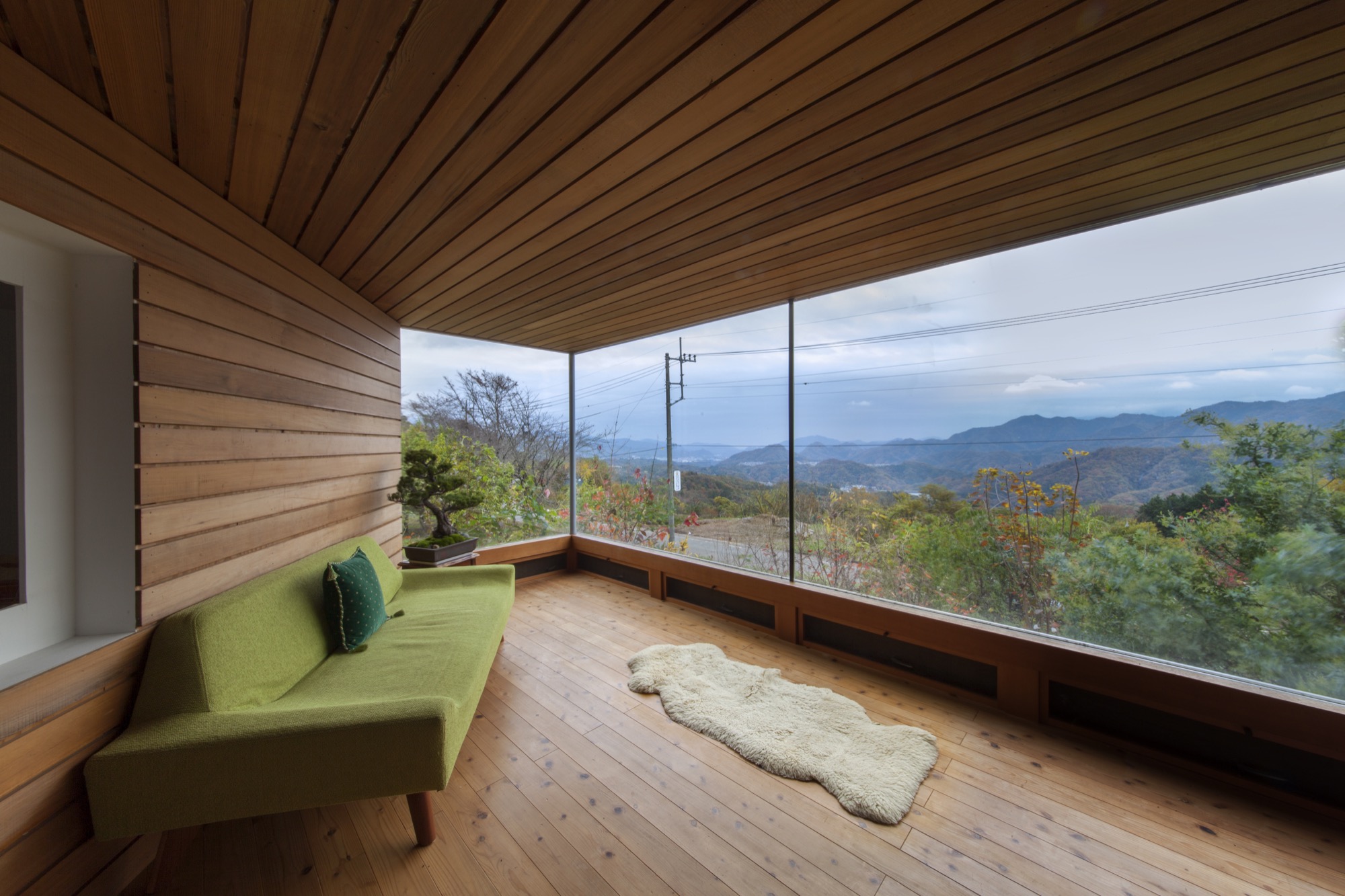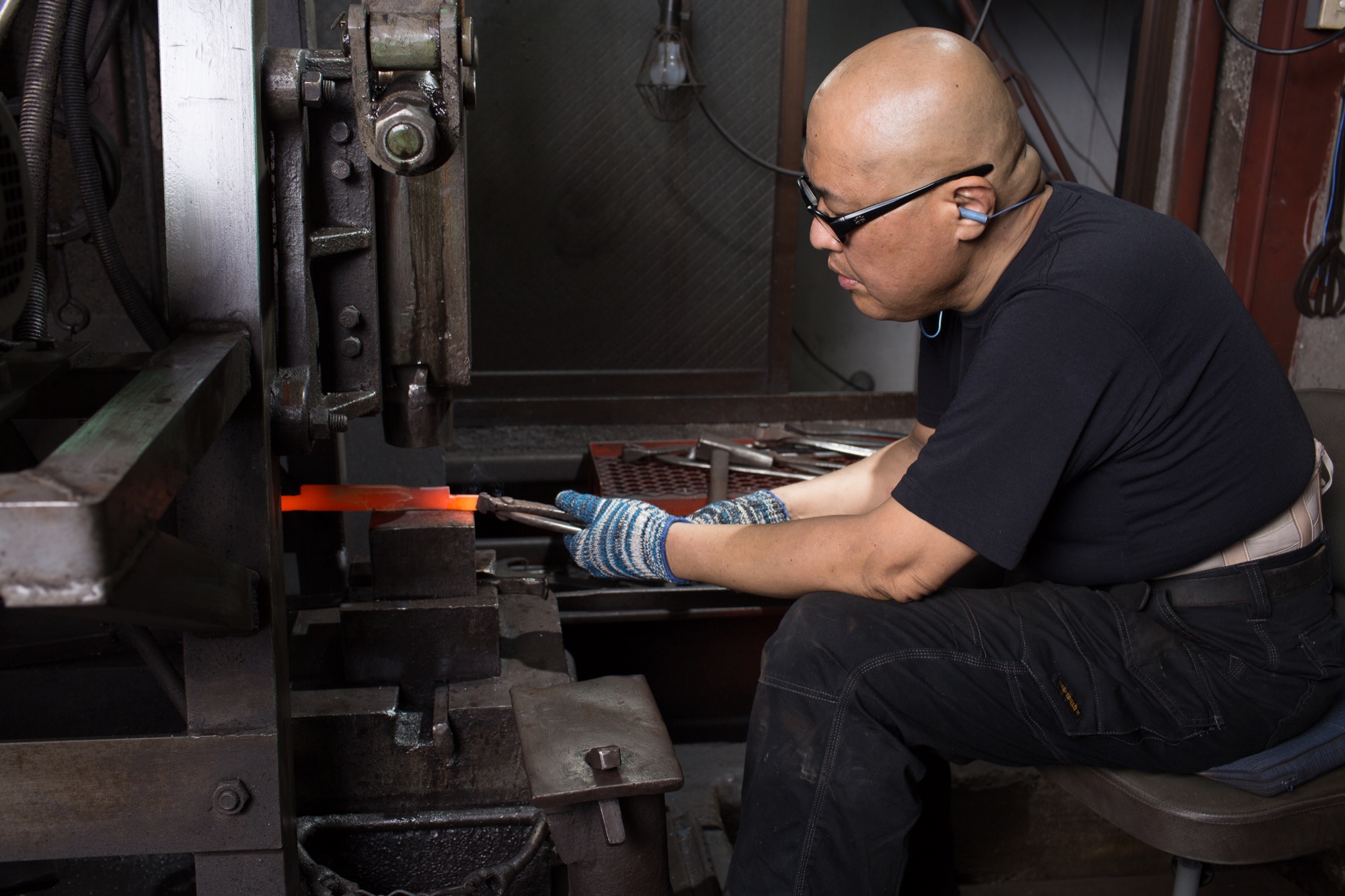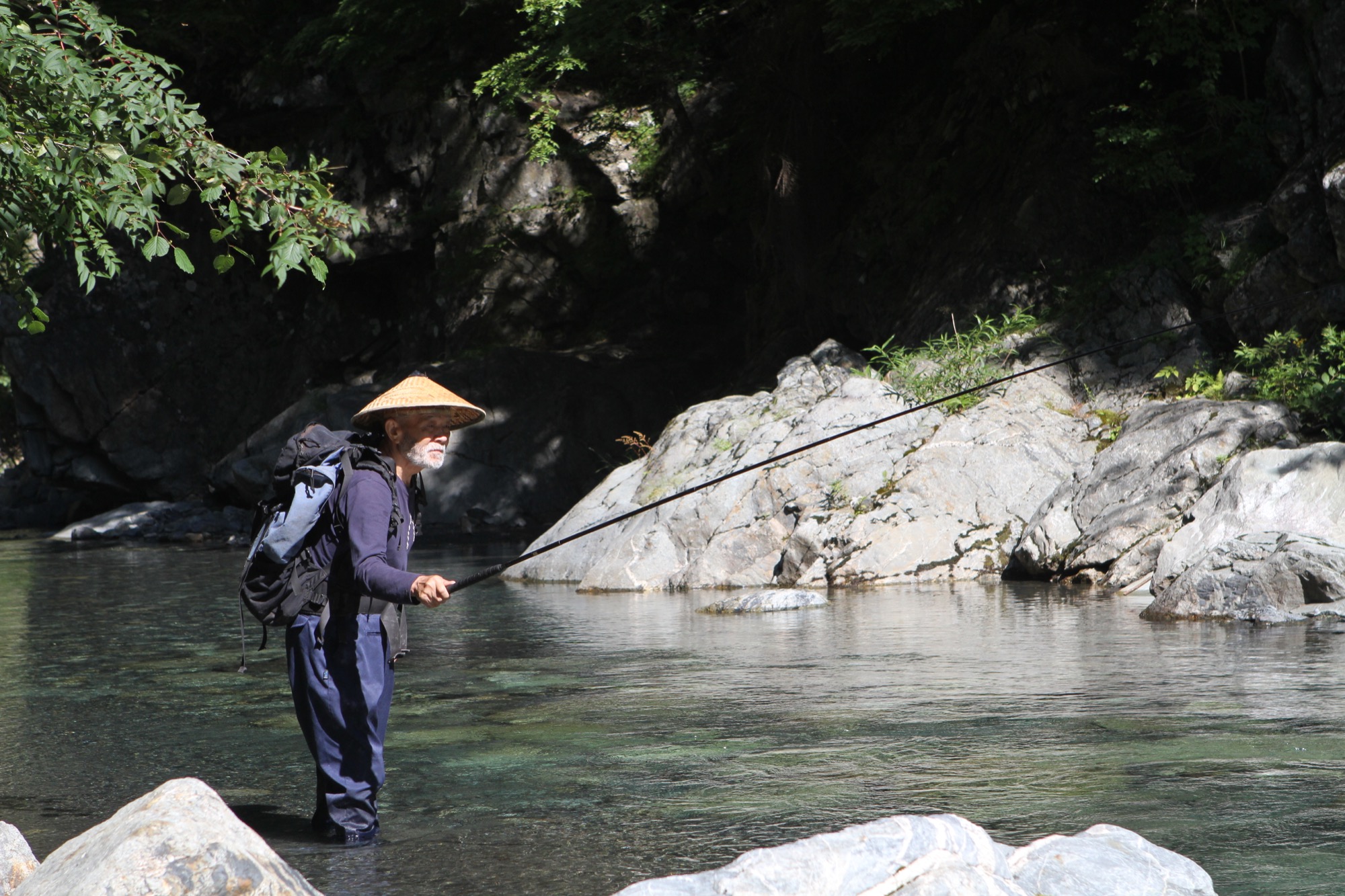
Inspirations
Explore the elevated life in the mountains. This content debuted in 2015 with Alpine Modern’s printed quarterly magazine project.
Inspirations No. 14
In this article… blah, blah, blah.
Hope you're enjoying a relaxing Saturday. We're getting bundled up and about to head down to the Cafe for waffles with our guests visiting from California. There's nothing like sugary waffles and warm coffee to kick off a weekend with friends. We're so thankful for the success of Alpine Modern Cafe and the amazing staff that wake up every morning to serve our neighborhood and the wide-eyed visitors from around the globe. It's demanding, being in the service industry, but occasionally our drained egos are refilled by a thoughtful online review, a sincere thank you, or, in this case, a spot at the top of a well-regarded list. Alpine Modern Cafe was highlighted, along with Intelligentsia, as the best place to get coffee in the USA from the Financial Times newspaper. We learned about this on Friday when we had an unusual number of Englanders visiting the Cafe, all snapping photos for their Instagram accounts. So cool! Well done, everyone! Here are some inspirations to keep you busy this morning:
Finally, someone designed a television for the modern home. The Samsung Serif is a work of art.
Coco has become an Instagram icon. She lives in Japan and she is only six years old.
This online illustrated guide to Frank Lloyd Wright's signature buildings.
This new game from our friend, Matt Sisson, called Ravine. We’ll be carrying it in our Shop once it’s ready but if you want to support Matt and receive an early copy, back him on Kickstarter.
Mr Porter curated a wonderful list of retreats. What’s more luxurious than a retreat in the middle of nowhere?
Chasen + Stone Matcha made this video about the cultivation and production of it matcha. This small farm in Japan supplies all the matcha for our Cafe and Coffee Bar.
Desktop cold brew coffee system by Bruer.
Two alpine-modern architects in Colorado worth noting: Studio-B and tres birds workshop
Loving these new Reebok × Barneys New York suede shoes.
Our Canadian friends at Wise sent us samples of their hair care products. We’ve been using the shampoo for the last two weeks. It smells splendid and the packaging design...it's oh so nice.
This home in Northern California is worth the click.
Scandinavia Trip Itinerary
When fall comes each year we find ourselves cleaning house, organizing, downsizing, and taking stock of the beautiful sunny memories of summer. As the kids nap peacefully this afternoon, we're snuggled on the couch watching the last of the orange and yellow leaves of cottonwoods drift quietly in the backyard. We're taking this window of opportunity to send a special inspirations email today about our summer vacation to Scandinavia. Along with our two kids, we explored Denmark, Sweden, and Norway for three full weeks in July. There are plenty of luxury-focused travel guides like Monocle, CITYX, and the Michelin Nordic Guide that are excellent resources, but we wanted to share with you some of our favorite places from the trip. Many of these links will go to our website where we have included pictures and more details about our experiences:
Denmark
When we began our trip we planned a few days of doing nothing so that we could adjust to the time zone and enter vacation-mode. We rented an Airbnb home in Hellerup (just North of Copenhagen). The home is located in a quiet neighborhood which was a perfect setting to help us get settled. Bonus, the house had a trampoline. We cooked meals, explored the town, and let the kids run loose at the most amazing children's museum, the Experimentarium.
Arne Jacobsen's iconic Station Wall Clock seemed to be everywhere we went in Denmark, including hanging in the Airbnb house. We purchased one for our home in Boulder to remind us of our trip and the importance of timeless design.
You must go to the Louisiana Art Museum. The art is very good but the architecture of the building is what really stands out.
When in Copenhagen, eat lunch at Copenhagen Street Food, specifically try Tacos Chucho. Get afternoon coffee and cake at 108 Restaurant and also go there for dinner. Stay at the D'Angleterre hotel and make sure to experience the spa and pool. You'll certainly see Tivoli Gardens and when you do, eat at Gemyse and try to get a seat inside the greenhouse. Great coffee at the four locations of Coffee Collective.
Sweden
When in Stockholm, have lunch at Oaxen Slip. Go to the Vasa Museum. Stay at the Grand Hotel and eat at chef Mathia Dahlgren's Rutabaga. Take a day boat to Vaxholmarchipelago and have lunch. Visit the old town of Stockholm, Gamla Stan, and make sure to buy candy at Polkagris Kokeri. Eat pizza dinner at Tutto Bello. For a quick lunch go to Kalf & Hansen and then get a coffee at nearby Drop Coffee.
In the unassuming town of Växjö, Sweden there is a beautiful hotel and restaurant, PM & Vänner. If you're traveling with children, you'll also want to spend an afternoon at the local park and playground, Linnéparken.
We had the opportunity to meet with the renowned designer, Pia Wallen, in her magnificent Stockholm design studio/home. Pia is the designer of the iconic, Cross Blanket, which we sell at our Shop in Boulder and that is part of the Swedish design museum. We wrote a more in-depth piece about Pia, here.
We discovered a Swedish architect worth noting, Jonas Lindvall, while staying at the PM & Vänner hotel, which he designed. His body of work is incredibly beautiful, modern, and considered. We especially like his furniture collections such as the Miss Holly Chair and Table.
Norway
We stayed at a nice and centrally located Airbnb in Oslo, Norway.
When in Oslo visit the Oslo Opera House to experience the architectural marvel that it is. This might seem odd, but there is a very good Chinese restaurant in Oslo that's worth eating, it's called Dinner. Go to the Vigeland sculpture park. Best coffee we had on our entire trip was at Tim Wendelboe. Eat at Smalhans.
If you make your way to Norway you'll undoubtedly explore the fjords. We stayed in a picturesque modern cottage in Aurland called 2|92 Aurland. Yes, that is a real a waterfall in the background...it was one of a dozen that surrounds you in the Aurland valley. Absolutely magnificent. Get to Aurland by train from Oslo to Flåm then take the breathtaking one-hour, Flåm Railway to the start of the fjord. From Aurland, take the five-hour Norled boat ride through the fjords to the ocean and end up in Bergen.
When in Bergen we couldn't find anywhere remarkable to stay but so long as you're near the town center, you'll be fine. Eat at Lyscerket and also at Bare Vestland.
Scandinavia is a remarkable part of the world. The people are kind, beautiful, progressive, and reserved. These values inspire us in our endeavors with Alpine Modern and in raising our family. It was a transformative trip for us and we hope that you get the opportunity to travel to that magical North. And if you do, please share with us your experiences.
Pia Wallen Stockholm Design Studio
We had the opportunity to meet with the renowned designer, Pia Wallen, in her magnificent Stockholm studio.
29|2 Aurland, Norway
While on our family vacation through Scandinavia this summer we stayed at a magnificent bed and breakfast in the heart of the Norwegian Fjords. 29|2 Aurland is nestled within the Aurland valley. We starting our Fjord journey in Oslo and rode a high-speed train to Flam. We boarded the Flam Railway and traversed down toward the fjords on one of the most magical train rides on earth. The train ends at Myrdal and from there 29|2 Aurland is a short fifteen-minute drive by taxi or hired car.
The staff at 29|2 Aurland prepared breakfast and dinner and also arranged guided hikes, fly fishing, and bike rentals.
Oaxen Slip Restaurant — Stockholm
Our good friend and culinary expert, Colin Kirby, recommended we lunch at Oaxen Slip while visiting Stockholm this summer. The weather was perfectly sunny but even in the middle of summer, there can be a chilled breeze off the water. Fortunately, the restaurant provides cozy wool blankets to keep you warm while you dine. We enjoyed a splendid meal and some of the highlights include smoked shrimp, new potatoes, and fried cod. It's a restaurant not to be missed on your next visit to Stockholm.
Louisiana Art Museum in Denmark
If you must see one museum while in Copenhagen, go to the Louisiana. It's about one hour north of the city and you can get there by bus or taxi. The exhibitions and installations are nice but what truly sets this museum apart is the architecture of the building and its setting on the water. Also of note is the exquisitely curated gift shop (we took copious notes of newly discovered designers for the Shop) and the free kids' artistic studios.

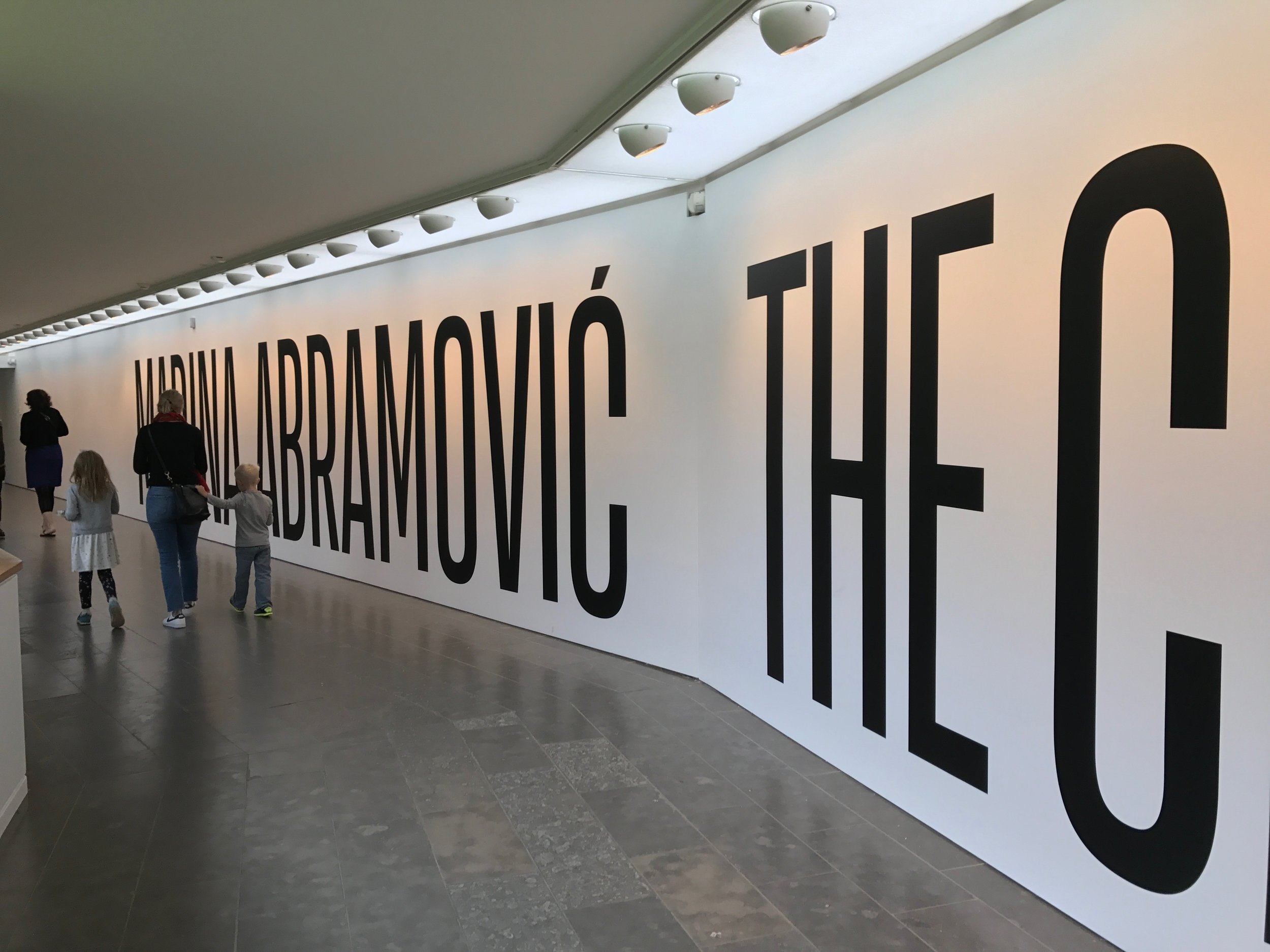
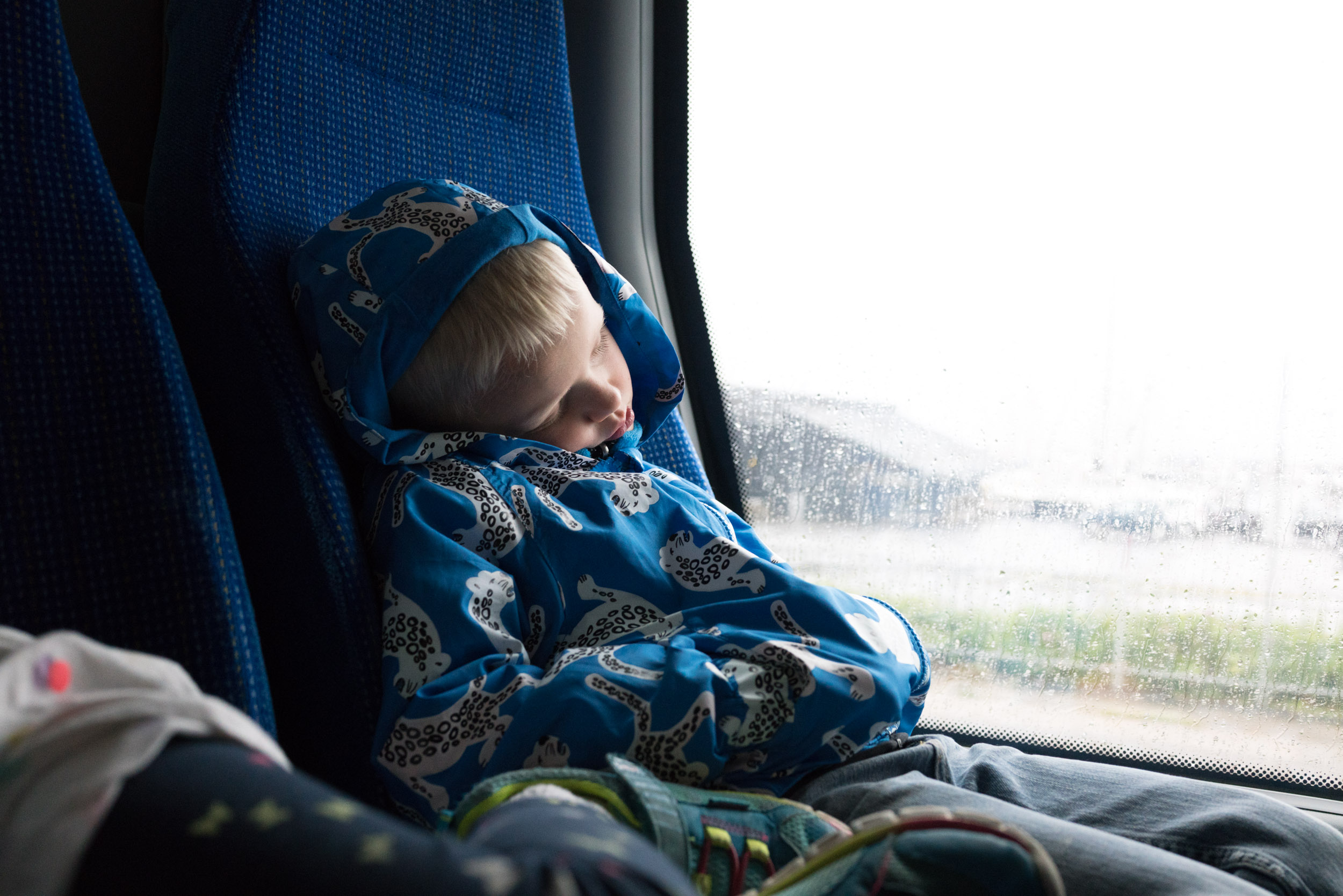
Best Airbnb in Hellerup, Denmark
While traveling through Scandinavia this summer we stayed at the perfect Airbnb in Hellerup, Denmark. It's about 20 minutes North of Copenhagen in a residential neighborhood and just steps to the beach. We were a bit hesitant to stay outside of the city but it turned out to be a great decision. The house was wonderful and even included a trampoline for our kids...which was a welcome activity after eighteen hours of travel! Jes is the owner and was the perfect host. You can view and book the home on Airbnb.
The featured picture above is of the dining room after our first dinner at the house. Notice the Arne Jacobsen wall clock? Love this place.
Minimalist Pottery in the Kyoto Mountains
An intimate visit with husband-and-wife pottery artists Momoko and Tetsuya Otani at their home and studio in Japan
The Shinkansen bullet train from Tokyo to Kyoto departs not one minute late, travels almost 200 miles an hour, passes Mount Fuji on the way, and pulls into Kyoto’s vaulting modern station not one minute early. From there it’s 40 kilometers by car to Shigaraki, an industrial mountain town, where I’ve come to visit a ceramic artist whose work has transfixed me on Instagram for the past ten months.
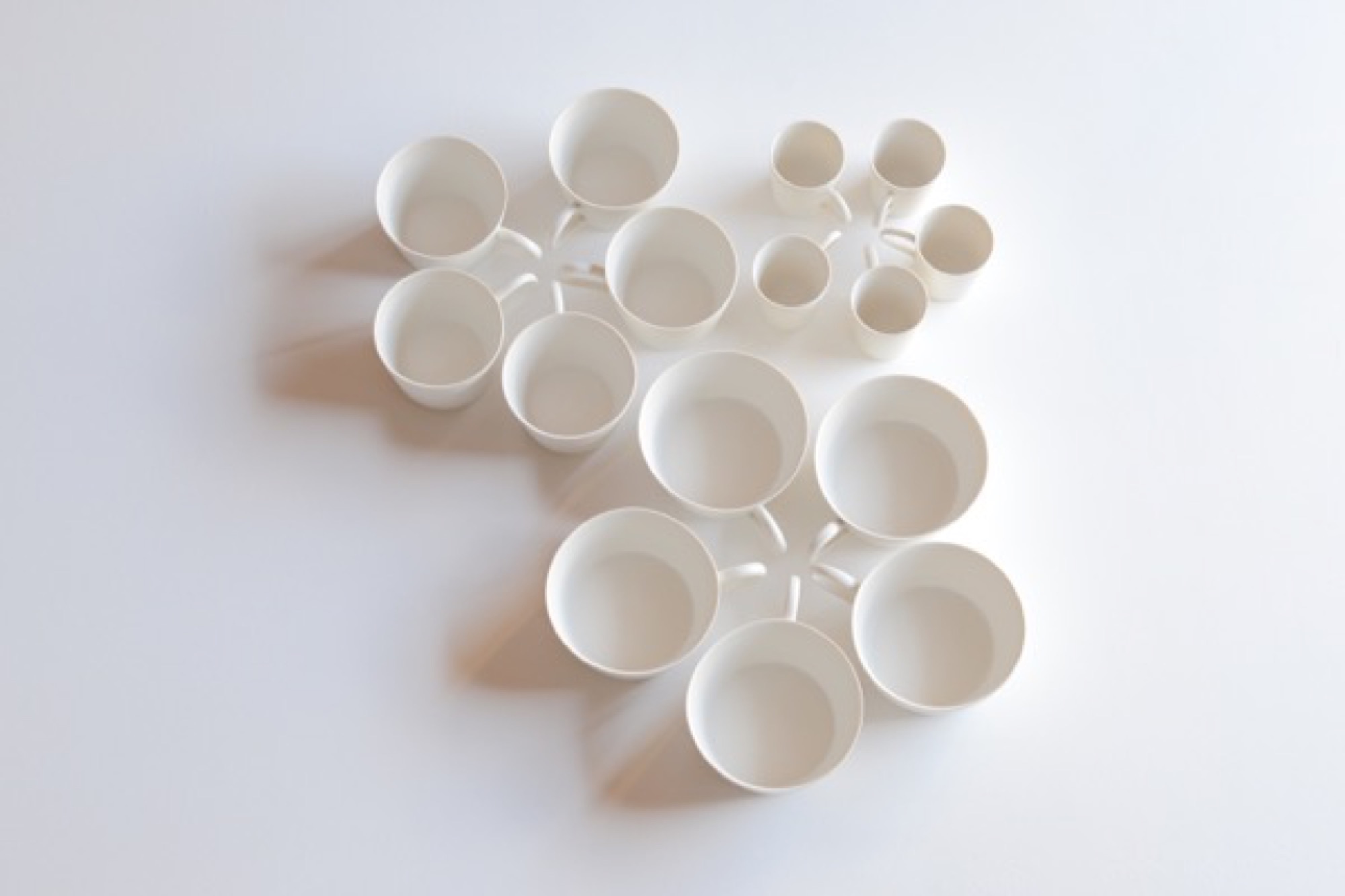
Shigaraki is home to one of Japan’s “six old kilns.” The most admired pottery here—tea bowls and sake cups made from local iron-rich clay—is often misshapen and haphazardly glazed. Much is left to the felicitous violence of earth and fire in wood-fueled kilns. These clay items, used in the exquisitely calibrated tea ceremony, are prized for their imperfections, reflecting the wabi-sabi philosophy in which earthiness, transience, roughness and decay reveal the essential nature of the world.
Such is Japan: hyper-curated, thrillingly modern, clockwork precise—then offering you a tea bowl that seems primeval.

The ceramic artist I’ve come to see, however, is Tetsuya Otani, whose work departs so thoroughly from the Shigaraki style as to seem from another world. Otani’s hand-thrown porcelain chases the precision of machine manufacture. Its skin is smooth and naked, like that of a baby. I wanted to know why he was making such beautiful but plain stuff.
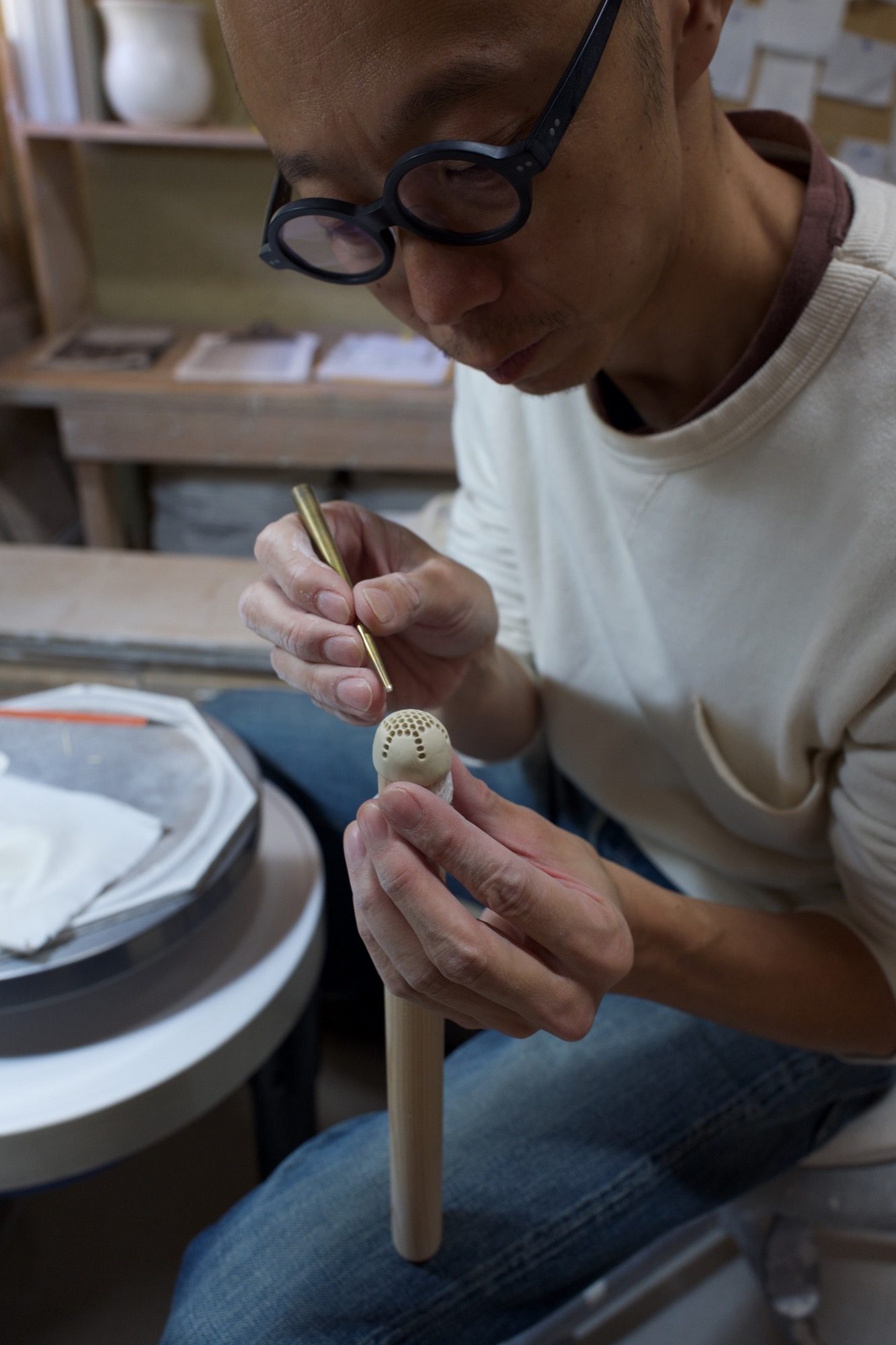
Right now, though, I have a few hours to kill, so I drive into the mountains to find the I.M. Pei-designed Miho Museum. The Miho is a kind of Japanese Getty, opened in 1997. It’s perched on a thick-forested mountain top like something a hermit might build if the hermit had several hundred million dollars. To reach it you walk through a hill via a gleaming, curving science-fiction-y pedestrian tunnel and emerge on a bridge that’s supported by a harp-string array of steel cables. The Miho was commissioned by an industrial-fortune heiress who also made time to found a sect in the 1970s, variously described as an art-centric religion and a sinister cult.
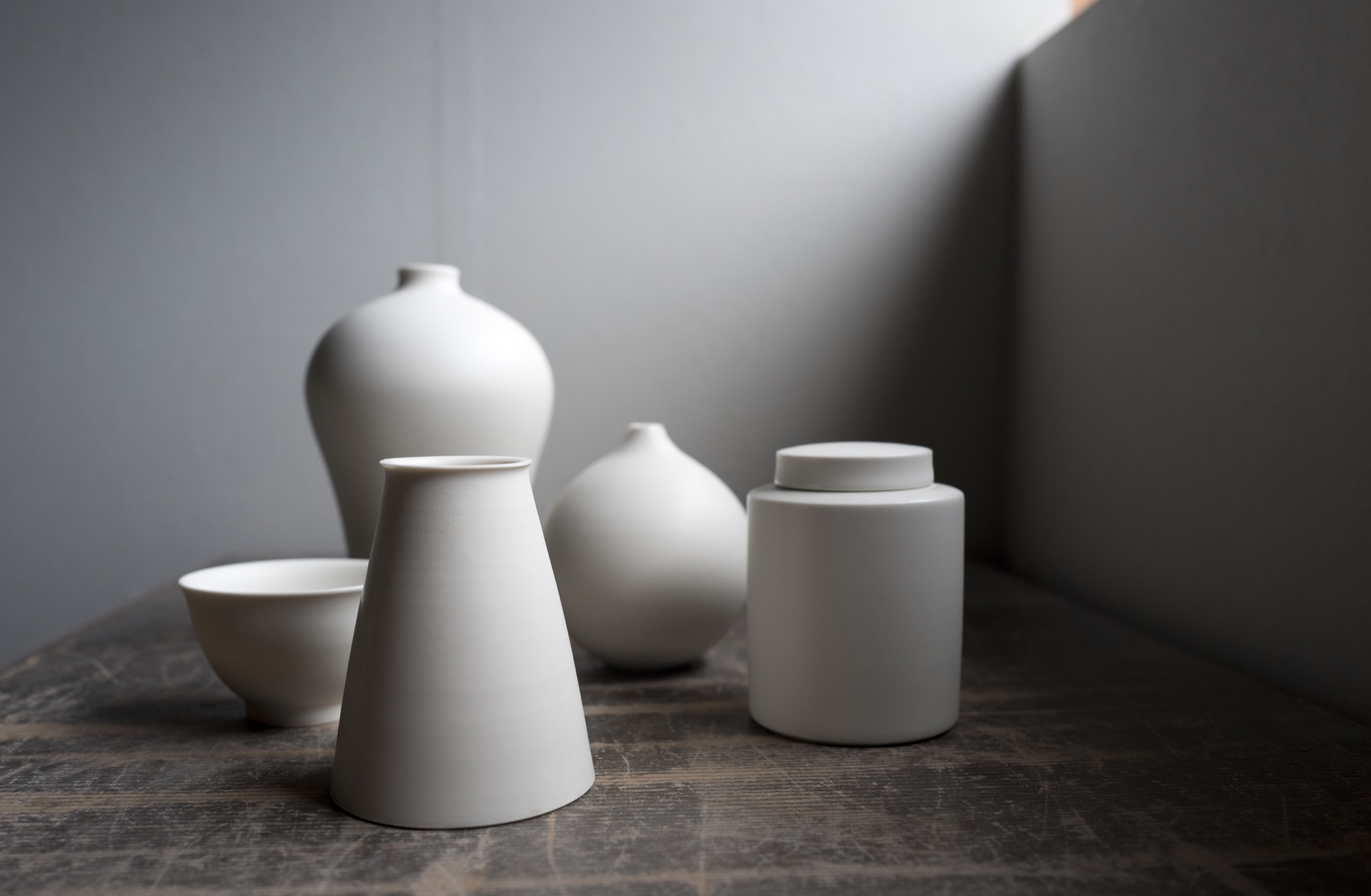
As traveler’s luck would have it, the museum is showing an astounding collection of ceramics by the 18th-century artist Ogata Kenzan, whose name means “northwest mountains.” His painted cups, bowls, and trays leave the viewer giddy, so varied and playful are they in style and form.
At home with Momoko and Tetsuya Otani
Five or so kilometers from the Miho is the home that Tetsuya Otani shares with his wife Momoko—also a gifted ceramic artist—and their three girls and a dog. It’s beautiful, with farmhouse mud walls and high wood beams that employ traditional temple joinery. Everything on the main floor revolves around the kitchen, which is far larger than usual in a Japanese house, reflecting the Otanis’ passion for communal cooking and eating with friends, many of whom also make pottery. The shelves, in the dining area and kitchen, are filled with both Tetsuya’s and Momoko’s pieces.
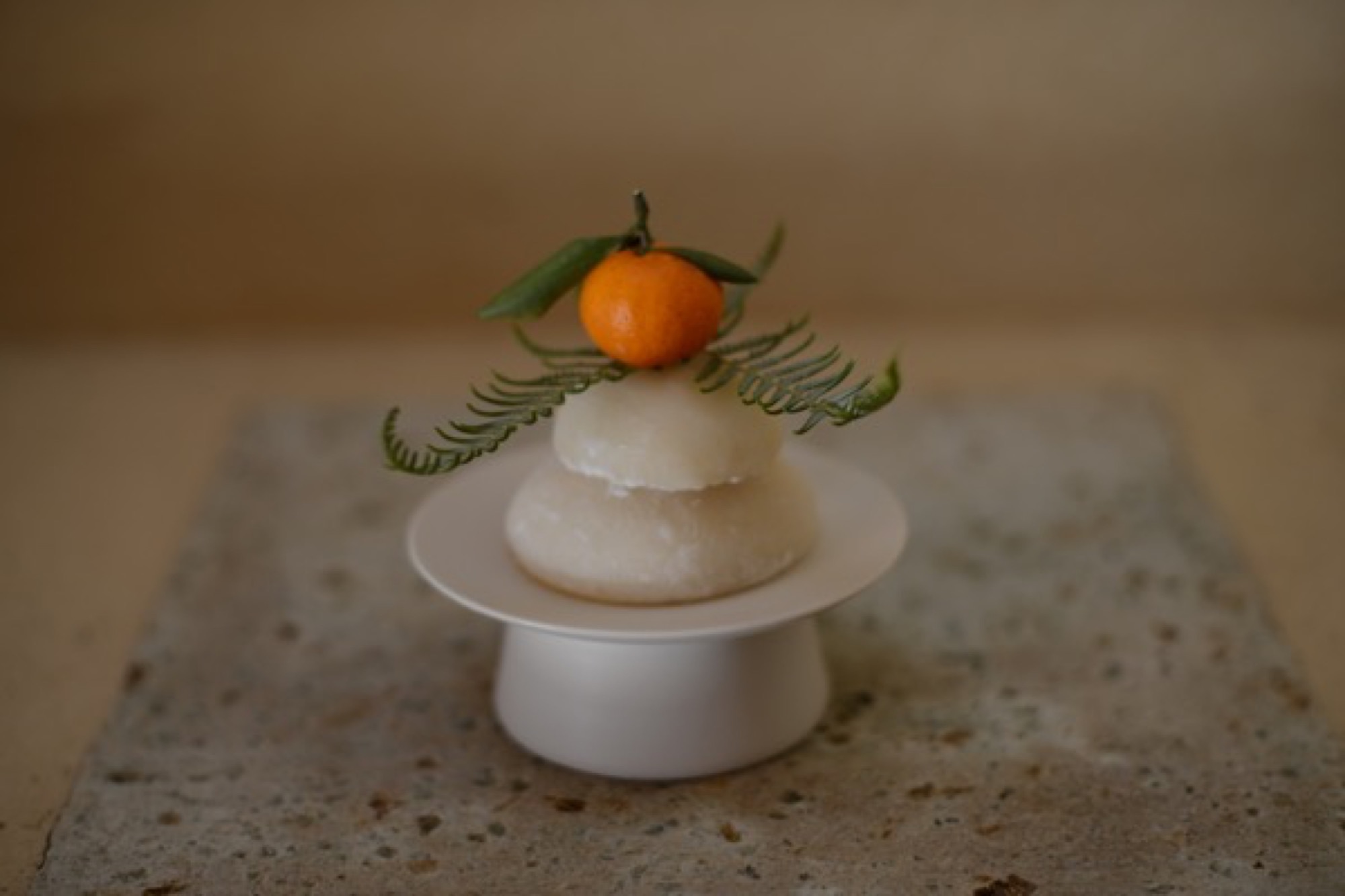
The work of Tetsuya Otani
Lately attracting attention among collectors in Beijing, Shanghai, and Taiwan, Tetsuya shuns both wabi-sabi imperfection and Kenzan decorative exuberance. Everything he makes is to be used, mostly in the kitchen or at the table: tiny matcha urns with clinking lids, curved-belly flower vases, delicately spouted teapots, tiny soy dispensers, little round boxes. The pieces are finely lipped and polished to a supple smoothness; their creamy matte glaze begs to be caressed.
Tetsuya’s pottery has thrown off all temptation toward decoration. The potter’s goal, he says, is to remove as much information as possible from his ceramics, seeking pure functional forms, because “things that work give pleasure.”
"The potter’s goal, he says, is to remove as much information as possible from his ceramics, seeking pure functional forms, because 'things that work give pleasure.' ”
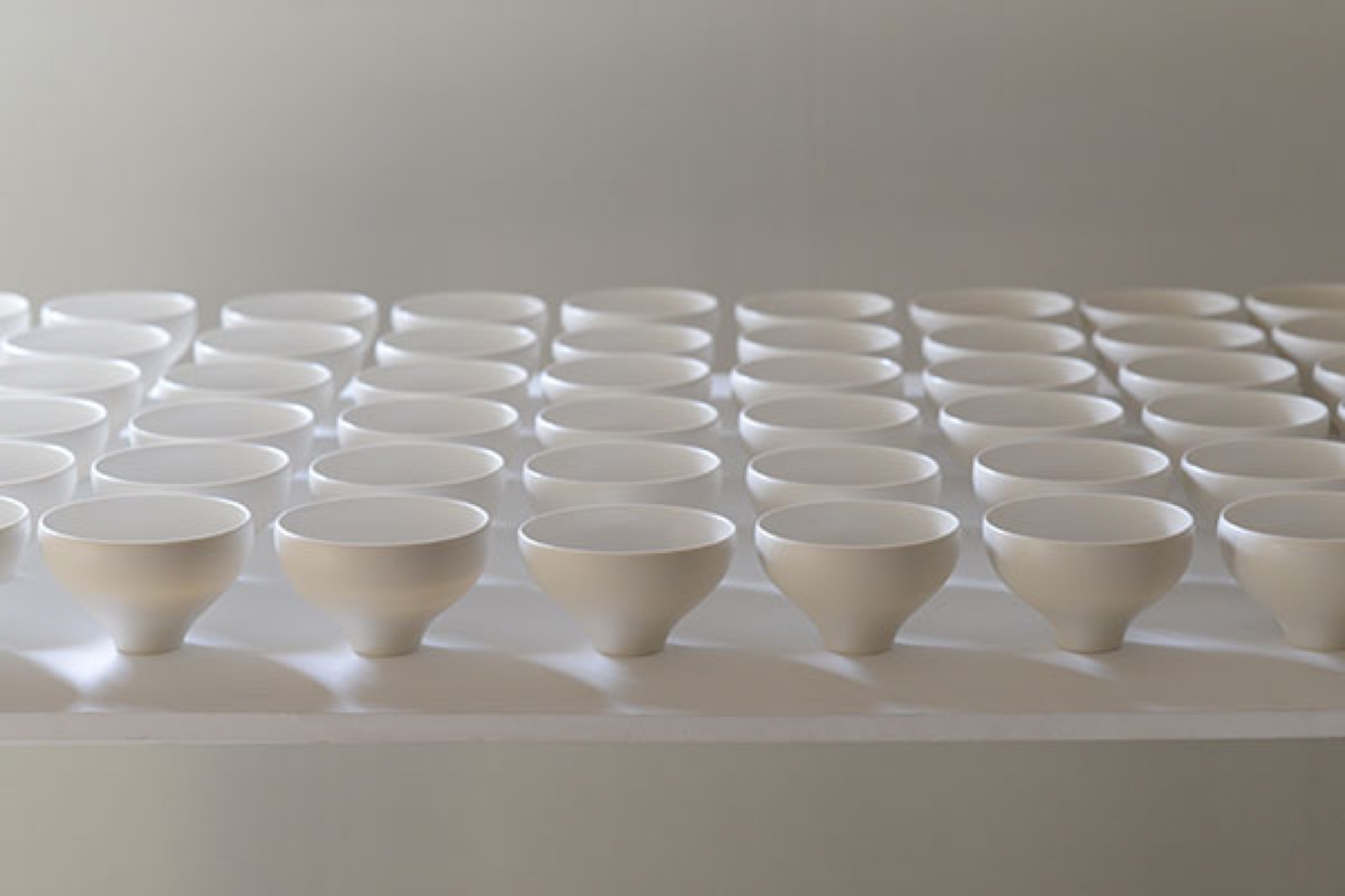
He studied in Kyoto, hoping to design cars, but when the economy skidded in the nineties, he shifted to graphics and ended up teaching product design (“how to make molds”) at the Ceramic Institute in Shigaraki, where he met Momoko and, on the side, learned throwing and glazing clay. By 2008, their house was built and he embarked on a ceramic career. He’s now in his late thirties.
I watch him work in the studio, which has wheels for him and Momoko, as he forms and pokes a bit of clay that will become a tiny strainer inside a teapot. A few feet away, a large machine mixes clay while sucking air from it, then extrudes large, irresistibly smooth noodles of the stuff. The machine is close to the same color as the clay. Tetsuya grins and admits he had it custom-painted to obliterate the standard industrial green. A clue to his fastidious brain.

The pure cup and the pure bowl
Later, we sit at the long kitchen table and look at bowls and cups and teapots and plates and discuss this idea of removing information from one’s work.
“The pure cup,” Tetsuya says, through Momoko’s translating, “and the pure bowl: They can accept anything, become a vessel for anything. Cultural information is eliminated. And then the cup or bowl can be applied to any culture.”
“The pure cup and the pure bowl: They can accept anything, become a vessel for anything. Cultural information is eliminated. And then the cup or bowl can be applied to any culture.”
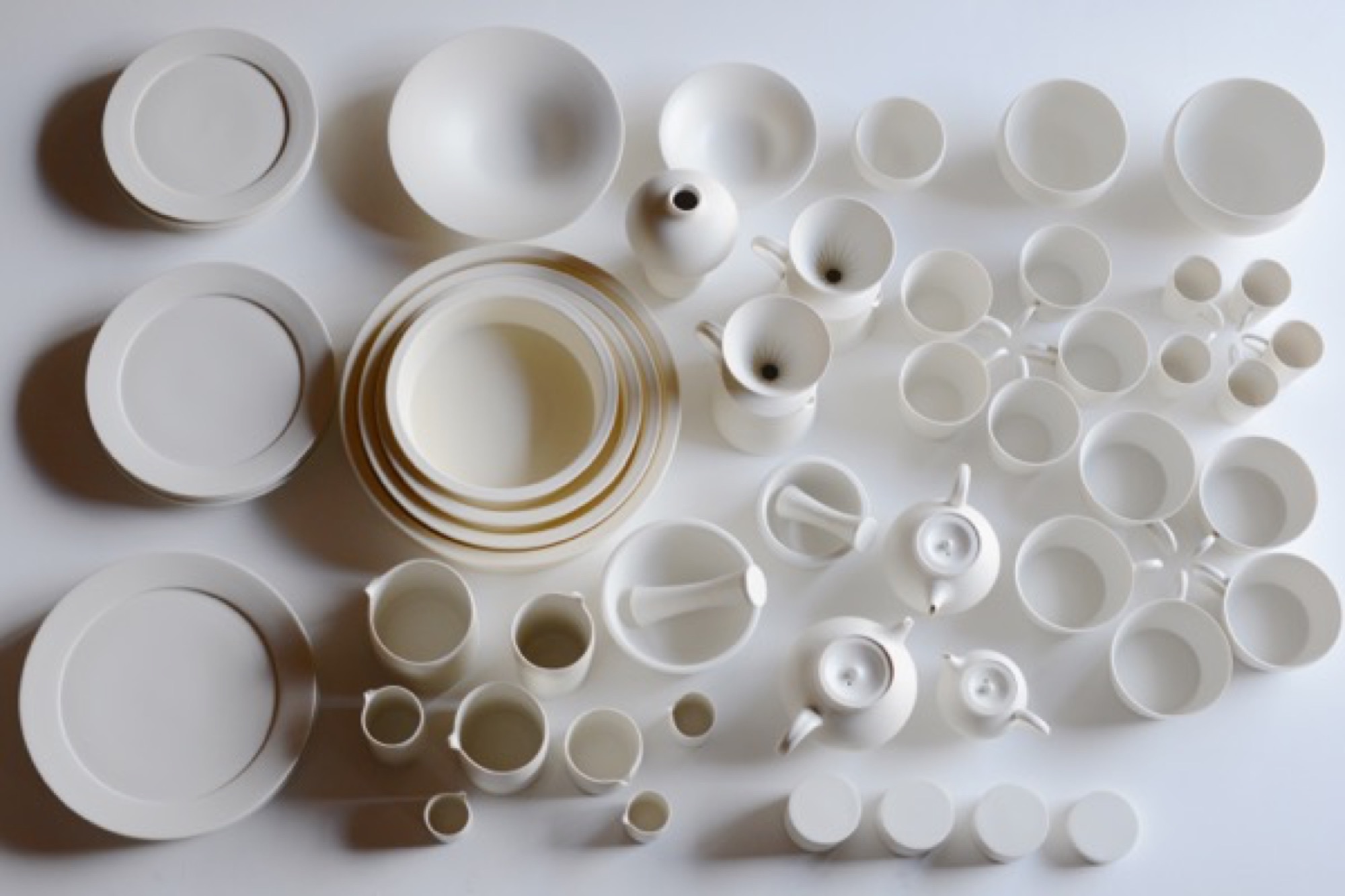
One may begin with the form of a traditional Japanese offering bowl. Decorative motifs are removed until it approaches neutrality. Eventually you “come down to the point where we can use it on our table, not for the gods’ offerings.”
Momoko adds: “Tetsuya strips the bowl of the divine.” He produces smooth dinner plates as blank canvasses for food—altars, really. They’re used in fancy Osaka and Kyoto restaurants to showcase chef art. His works are unsigned, unmarked.
“Tetsuya strips the bowl of the divine.”
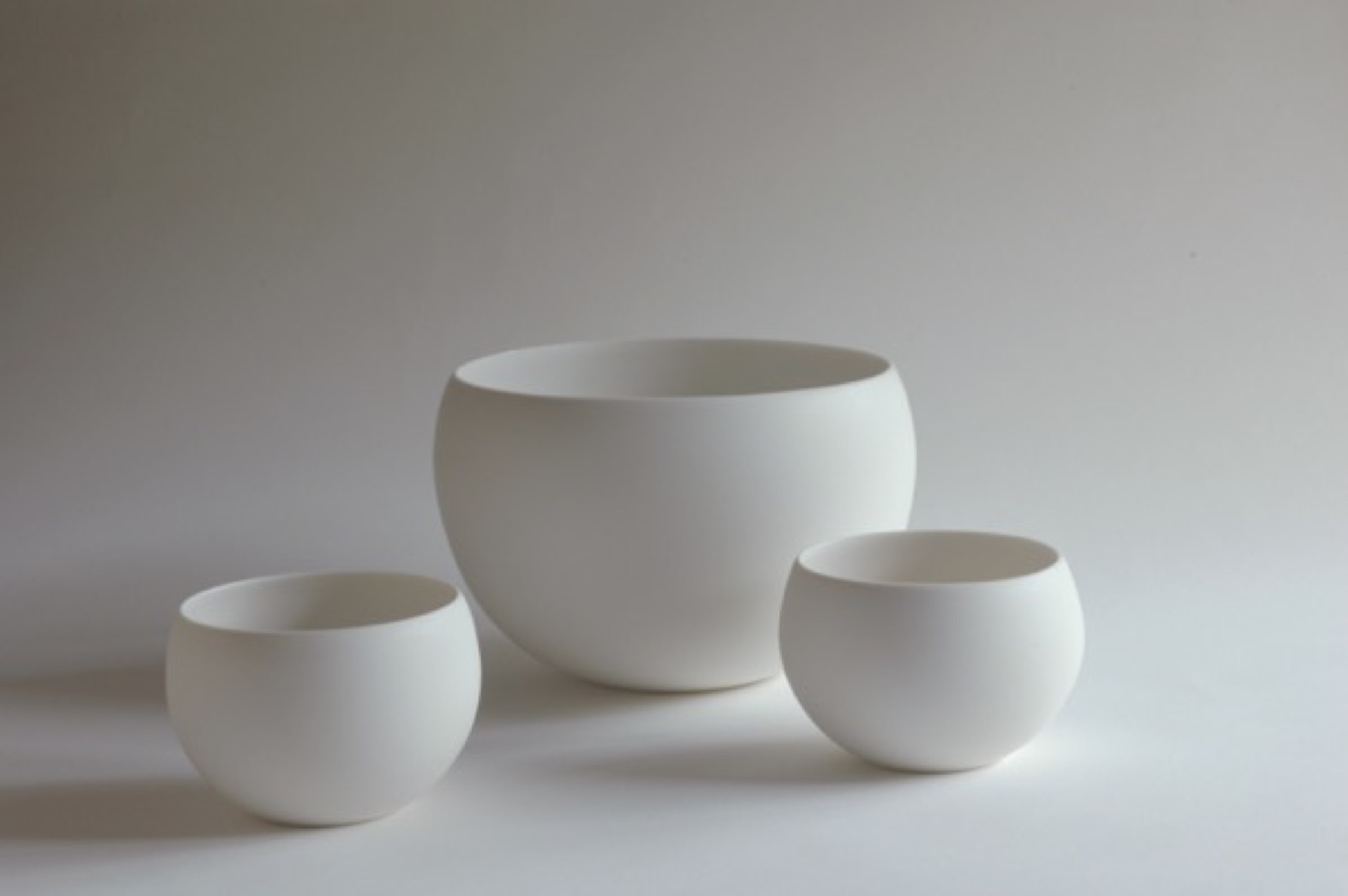
But cultural negation negates a specific culture, and Tetsuya says he has lately realized, when showing his works in China, that they are in some way indelibly, irreducibly Japanese. “I now feel that,” he says, “but I don’t have the answer yet about why I feel that way.”
The potter approaches, but never finds, ideal functionality. Tetsuya tweaks the ancient teacup form a wee bit from batch to batch, always seeking the right feel of cup in hand, the right curve of handle against thumb and finger. This lonely, incremental search for ideal form, endlessly repeated, is itself very Japanese.
The motivation is pleasure, however, not denial. Tetsuya and Momoko are exuberant foodies, and have found that their table-centric philosophy resonates globally through their gorgeous Instagram feeds, @otntty and @otnmmk, with more than 20,000 followers between the two for their pictures of utensils and food.
Tetsuya is also funny. He calls the clay mixing machine Mr. Hiroshira, “my only employee.” What about the beautiful industrial kiln in the next room, I ask? “No,” he says, “I work for it.”
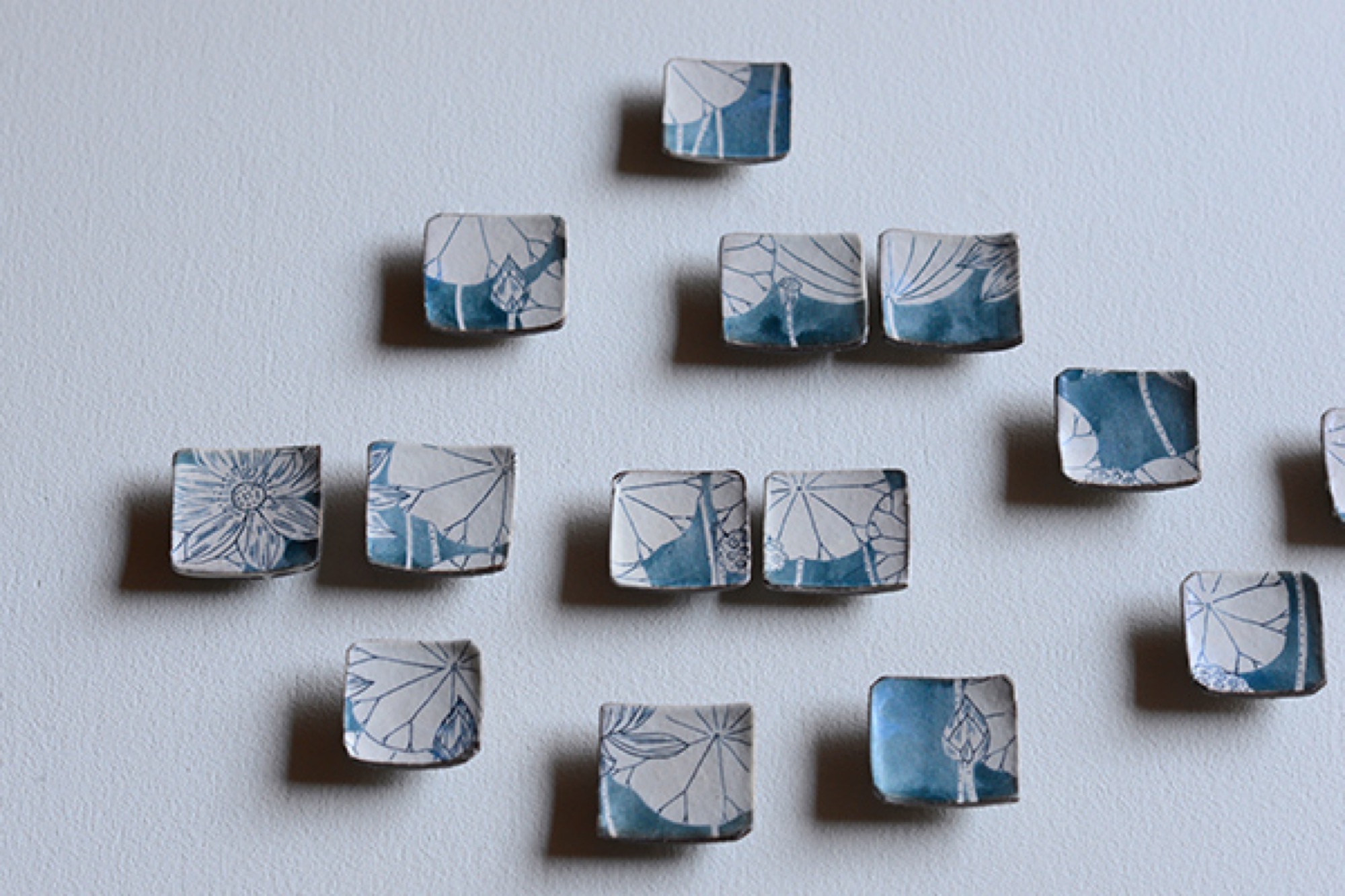
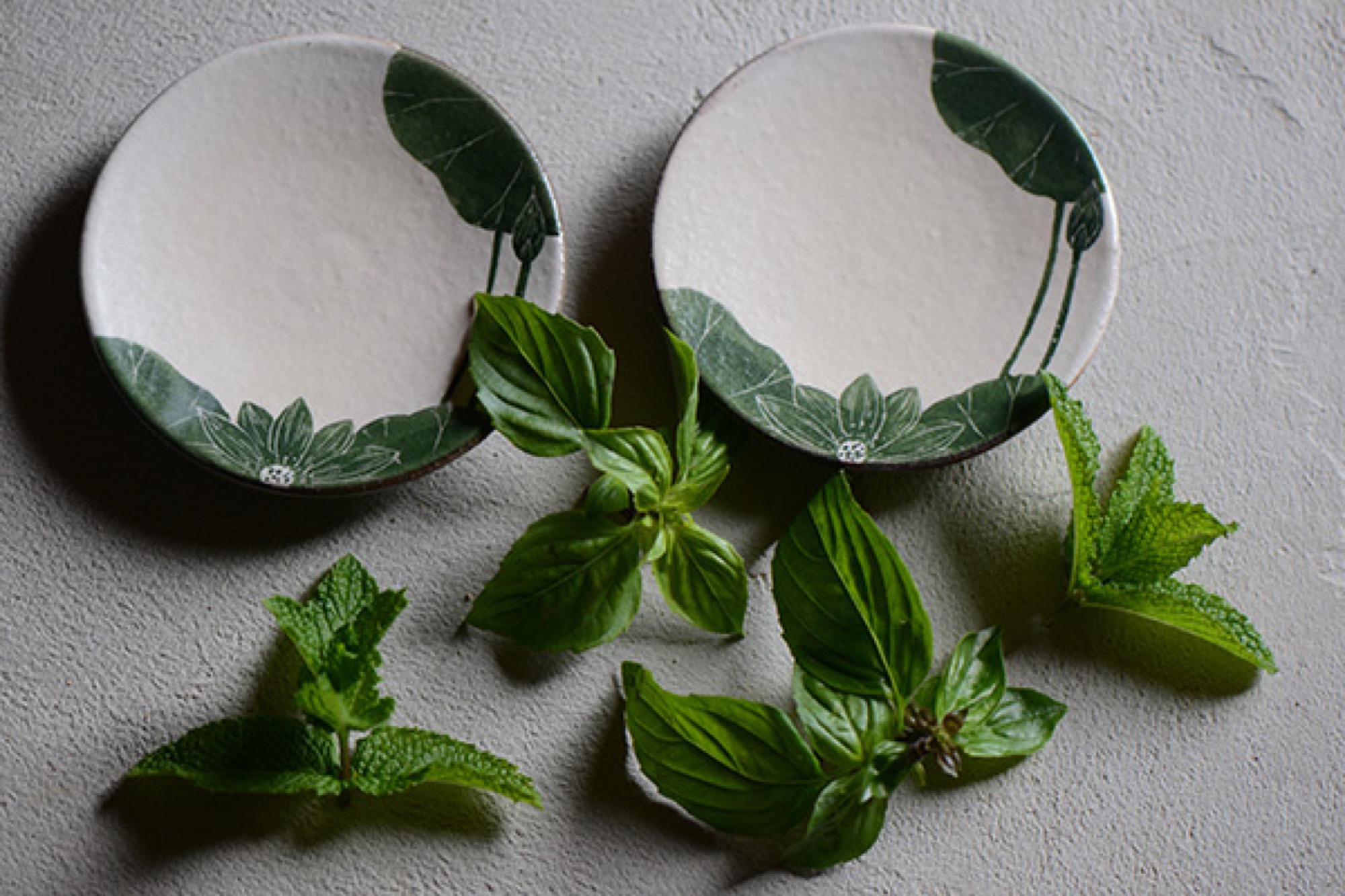
Return to Kyoto
A few nights later, in Kyoto, my wife and I visit a little chocolatier and bakery called Assemblages Kakimoto, near the Imperial Palace. In the minimalist showroom up front I buy a box of orange biscuits enrobed in dark chocolate, each biscuit not much bigger than a postage stamp. Beyond the front space is a narrow, pretty room with a half-dozen seats or so against a counter, facing a tiny kitchen. We order chocolates and cakes and glasses of thirty-year-old palo cortado sherry. Two women to our right—the only other customers in the café—have come for the chef’s omakase dinner. With each course they look gobsmacked, enraptured by the treats placed in front of them. It’s beautiful food, for that is the Kyoto style. Each composition sits on the pale canvass of an Otani plate.
The entanglement of much fuss and no fuss that lies at the heart of many things Japanese is hard to describe, but when I palm one of the Otani pieces that we brought back from Japan, it seems to embody that contradiction. My favorite is a little round vase, the size of a tennis ball, whose satin smooth sides curve up to a sharp-lipped hole that’s big enough to accommodate the stem of a single bud. In weight and delicacy and touch and every other aspect the vase seems, to me, as close to perfect as it can get. It holds a lot of information about Japan. △
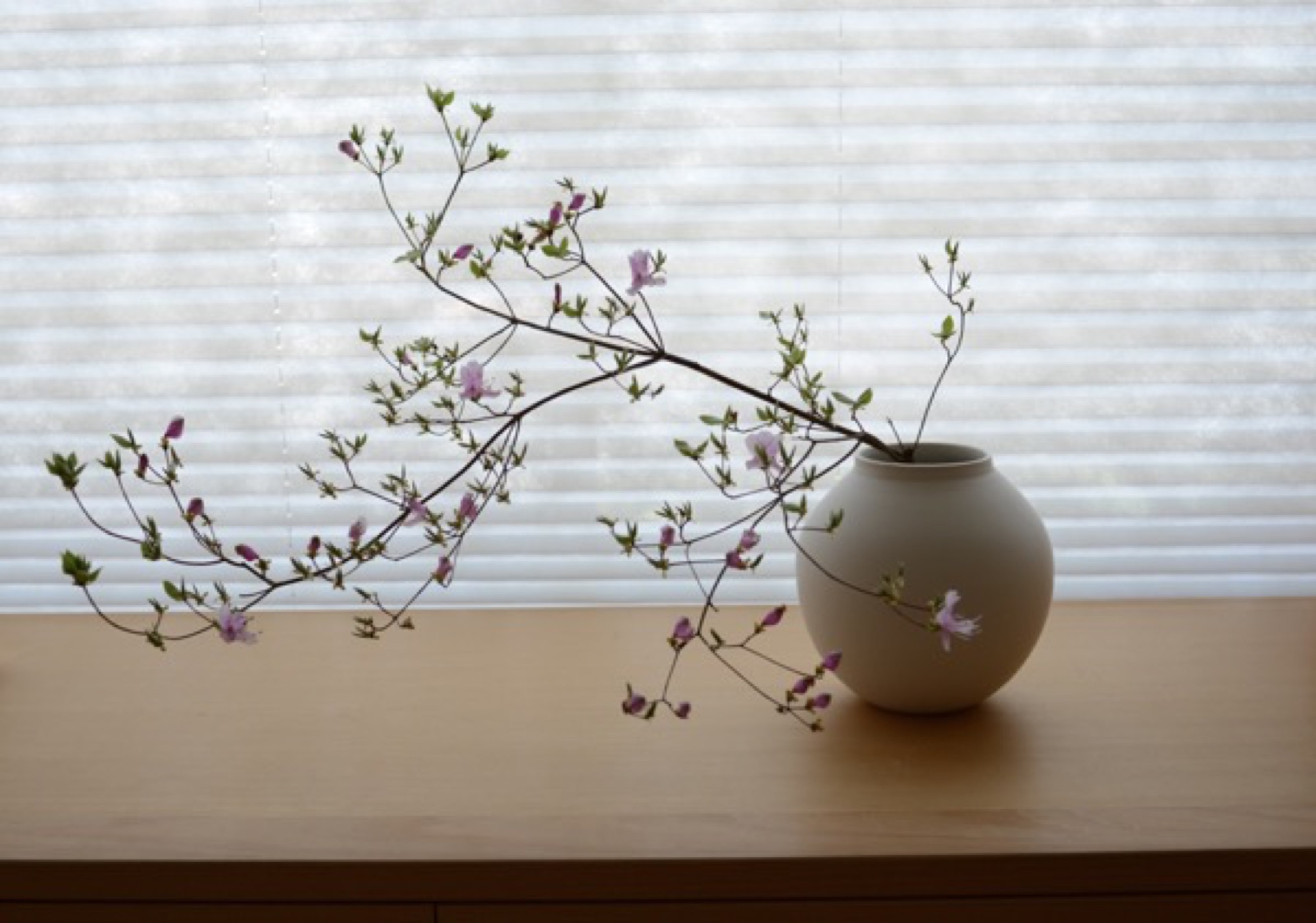
Pictorial Road Trip—Peaks and Lakes in Colorado
Denver filmmaker and photographer Grant Lemons experiences seasonal Colorado landscapes from behind his lens
Born in Salem, the rainy capitol of Oregon, as he calls it, filmmaker and photographer Grant Lemons currently lives in Denver, Colorado, where his sense of adventure awakened. From here, he ventured out into Colorado’s beautiful—and at time mysterious—landscapes of fall and winter.
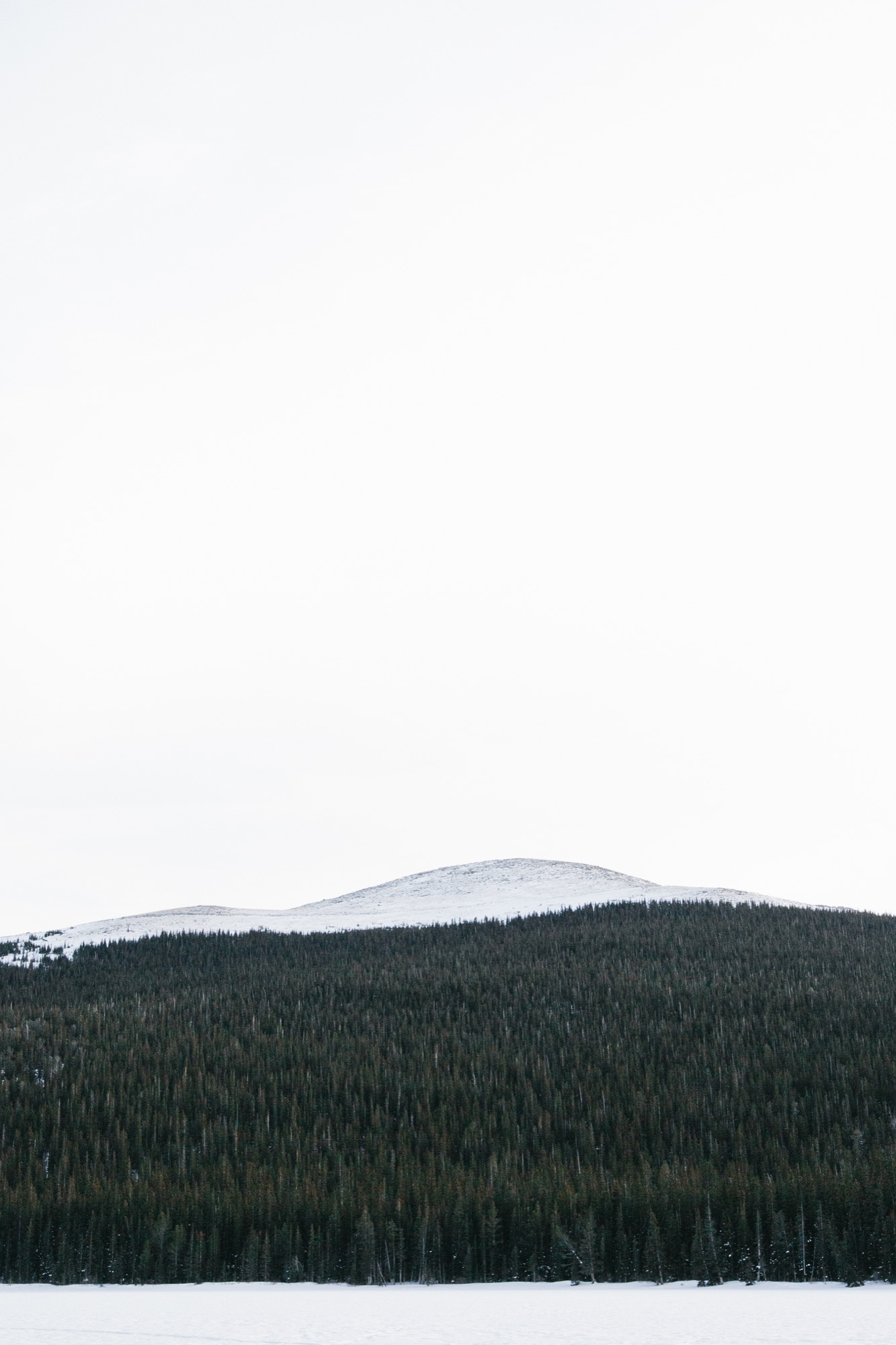
Lemons majored in journalism at the University of Oregon and plans move to Portland this summer.
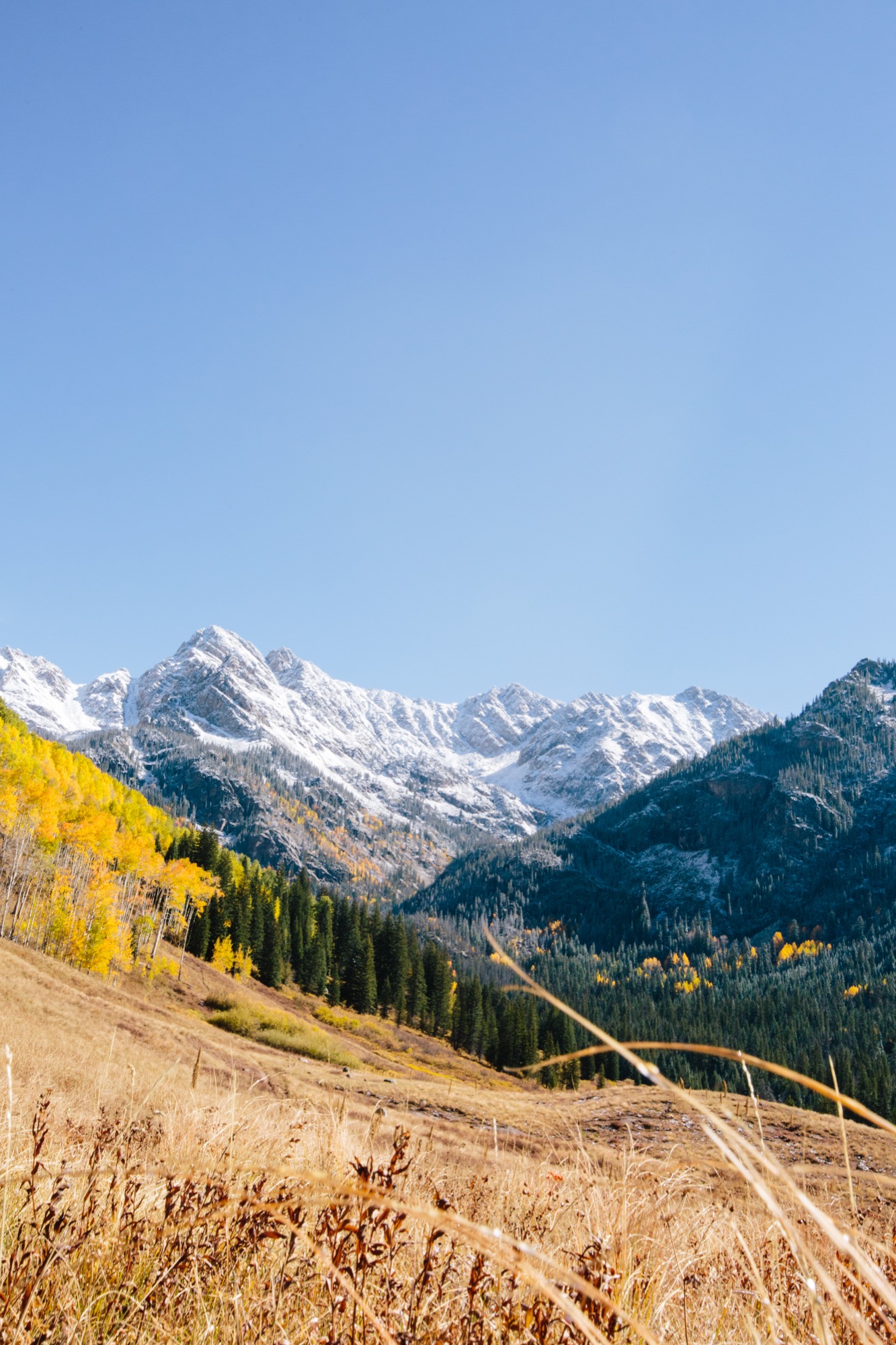
A conversation with filmmaker and photographer Grant Lemons
AM Who are you, in a nutshell?
GL I’m a high-energy guy who loves to capture new places and people... all while listening to hip-hop. I try to run whenever possible, too.
AM When and how did you know you wanted to pursue photography?
GL Simply put, making videos drove me to photography. Like many other people in my industry, I obsessed over telling stories with my camcorder at a young age. Over time, as new gear came and went, and I fell in love with the craft of making films and this passion for the technical aspects began to translate to photography. That initial pivot toward taking photos only happened a couple years ago, and now I find that I spend my days doing somewhere around 70% photo and 30% film. The photo bug bit me, and I've been hooked ever since.
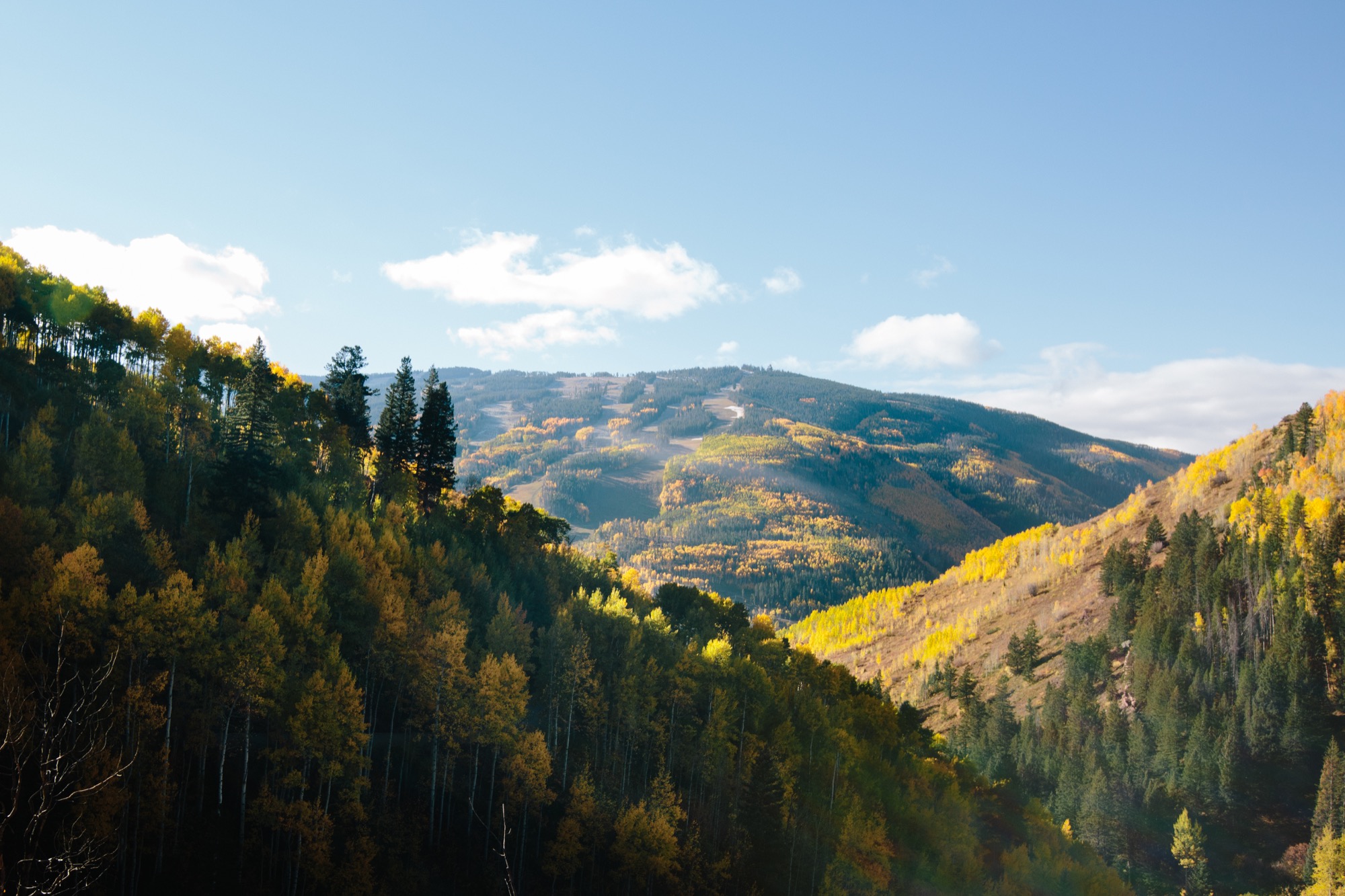
AM How did you learn to be a photographer?
GL Ironically, I never took a photography class while in school. Instead, I learned about the documentary approach to film and to telling stories the entire time. I really learned photography by spending as much time as possible with people who are ten-times the photographer I am. I went on adventures with them and experienced their differing styles. I'm always looking for more opportunities like that. YouTube tutorials are a plus, too.
AM What inspires your work?
GL My friends, my family, and the everyday environments that I find myself in. I try to find inspiration at every possible turn. Additionally, moving to Colorado spurred a real yearning for adventure within me. It's a surreal feeling capturing all you can at 10,000 feet and above.
AM What do you hope people experience when they look at your photography?
GL Wanderlust is an overused word for the feeling many people get when looking through photographs. With that being said, what I hope people get out of my work is a sense of exploration in a really broad sense of the word. No matter where you are, there are interesting moments and places to capture. That's what I seek to do every day when I can, no matter what place I find myself in. I hope when people see my work, they feel motivated to do the same—whether it's in the city or the mountains.
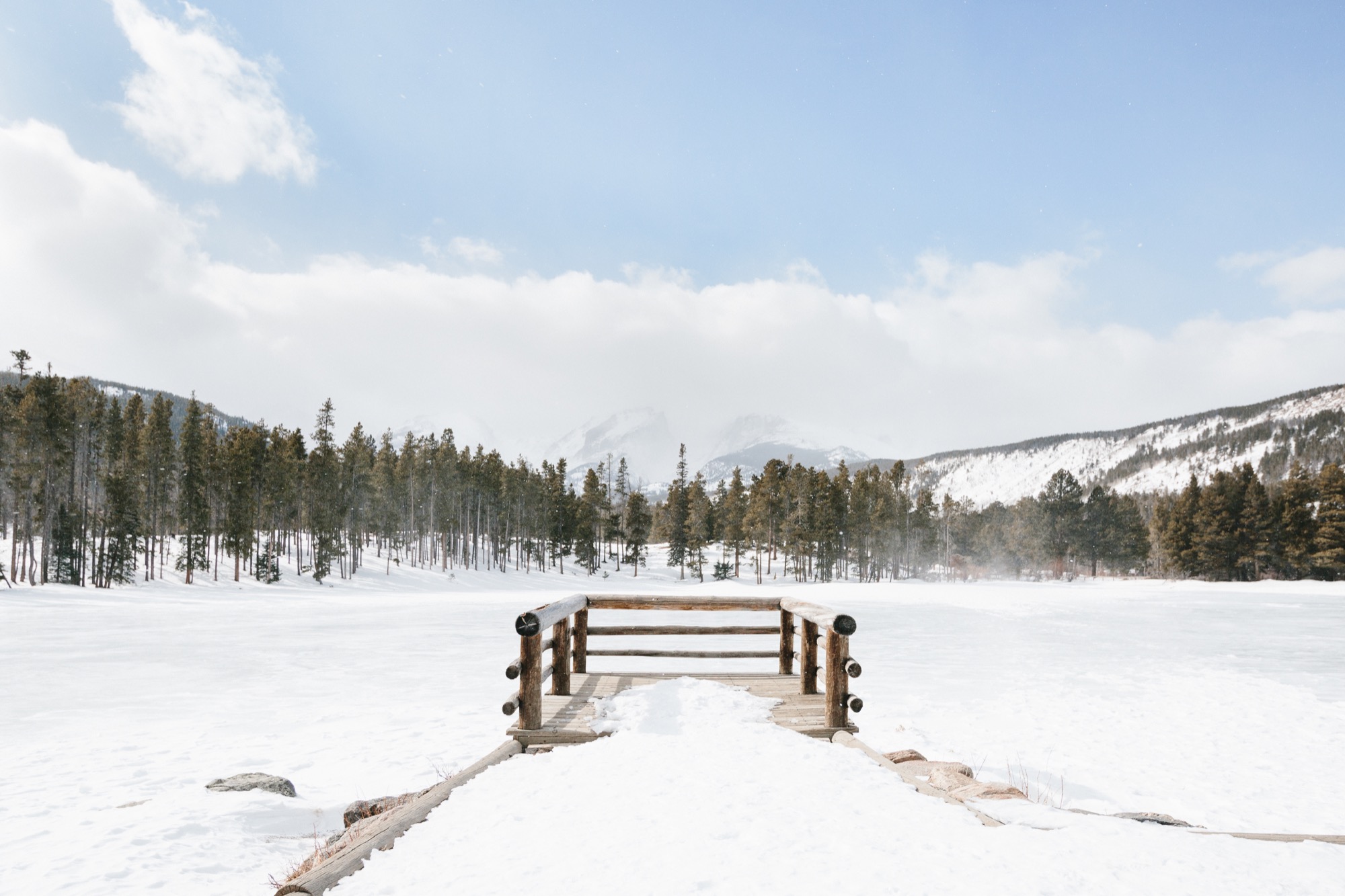
AM What makes you an alpine modernist?
GL At my very core I am a simple person. I don't keep many possessions in my orbit, and I enjoy a strong cup of coffee every morning while the sun rises. As it stands right now, my ideal day is an early wake up at 5:00 AM, heading west to the Rockies, and snow-shoeing in fresh powder to capture the early morning light shining on the mountains.
AM What do the mountains mean to you?
GL Growing up in Oregon, we held the mountains we do have in the state with high esteem—and we do have some remarkable peaks. When I visited Colorado for the first time the enormity and sheer amount of peaks that surrounded me blew me away. Here in Colorado, the mountains represent everything that is good in life, and it would be hard to escape them. Having the wild right at my doorstep with the Rockies took things to the next level for me, and the mountains are a constant blend of fun, adventure, and wonderment.

AM What is special about photography in the mountains?
GL Unlike other environments or subjects, time moves differently in the mountains. On one hand, I feel acutely aware of time and its shifting presence on the landscape in front of me. On the the other hand, I have no grasp on how time is moving when I begin to get in the flow of it all. Hours peel away. It's both a calming and challenging experience when considering the conditions that can come up in the winter, too. A lot of paradoxes, to be certain. It's one of the most rewarding landscapes to conquer and capture.
AM What’s your favorite place in the world?
GL At this point in my life, Portland is my favorite place in the world. An energy kicks into my system every time I touch down there, and it's stacked to the brim with people creating cool things. I really feel like I'm a part of the city in every way. My hometown of Salem, Oregon, is on the come-up, so I have to give it a big shout out too.
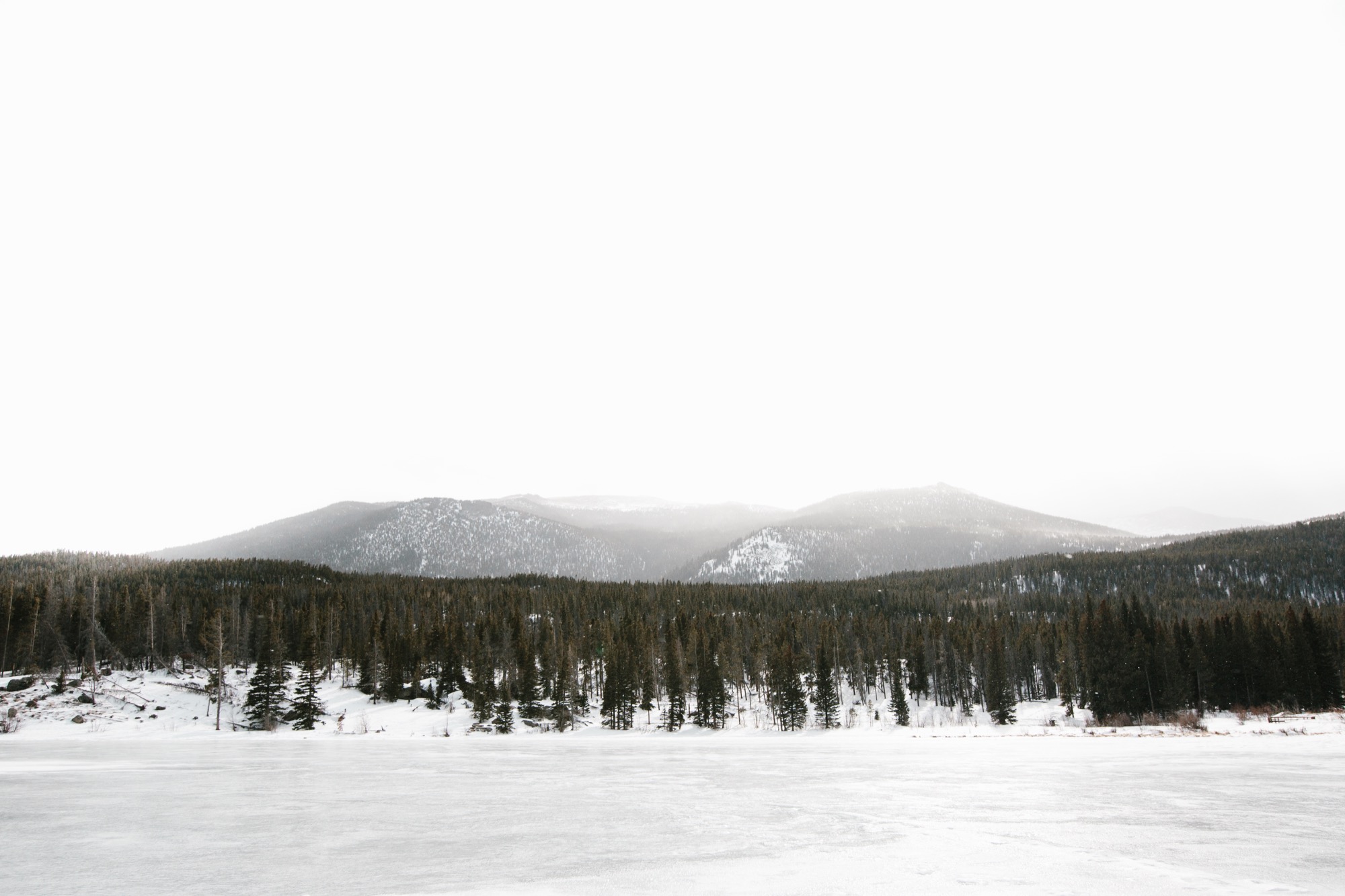
AM What are you working on these days?
GL I'm prepping to capture a short music tour in Europe in March. Recently, I've been lucky enough to have extra time to work on passion projects, which coincidentally, leads me to the mountains. I'm trying to use every day as an opportunity to capture a different Coloradan moment as my time to move away approaches. I'm really thankful to be around for another (somewhat) snowy winter. △
Up and Away: 10 dream tree houses
These ten small structures make childhood dreams come true.
Who says that grown-ups can’t have tree house goals? When the demands of daily life become too much to bear, a special hideout in the sky can be your place to escape, cool off, or brainstorm in peace. Just one look at these inspirational mini-getaways and you may find yourself looking for a sturdy tree to scale.
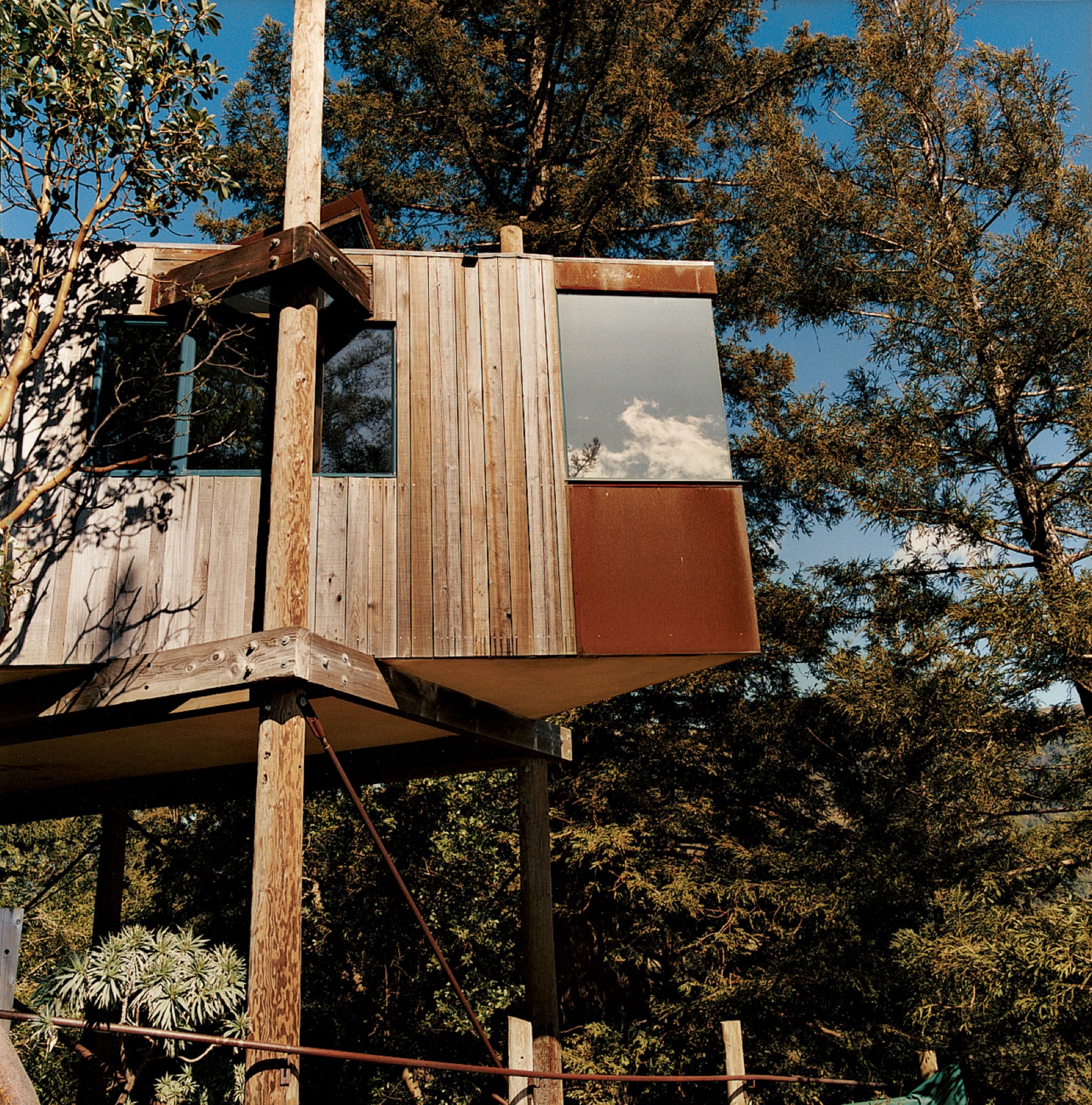
Designed by acclaimed Big Sur architect Mickey Muennig, The Post Ranch Inn consists of a series of freestanding units that showcase Muennig's contemporary organic vision. The tree houses feature Corten panels.
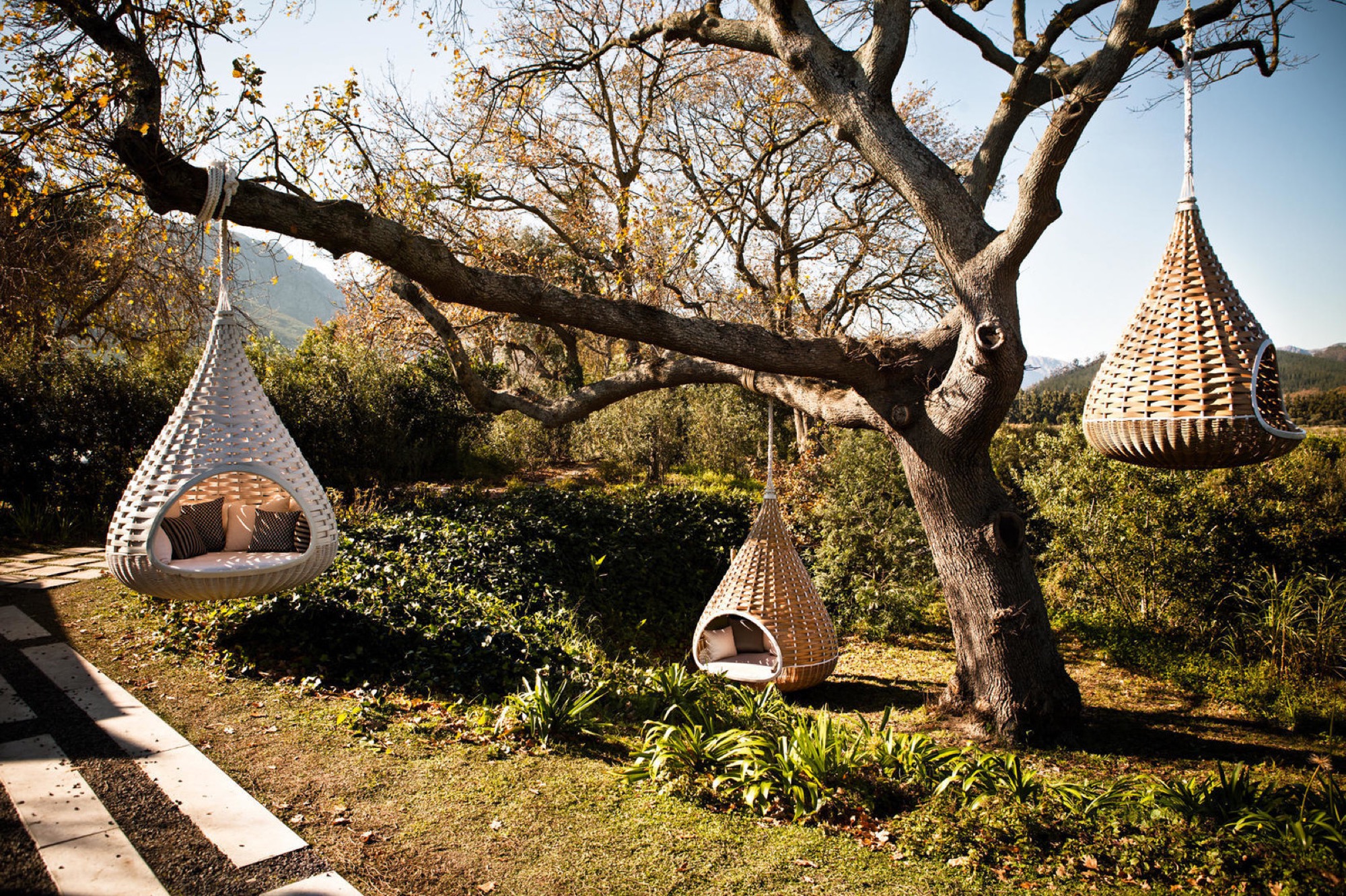
Dedon’s Hanging Lounger, designed by Daniel Pouzet and Fred Frety, can be an instant mini-tree house escape. All you need is the right tree to hang it from.
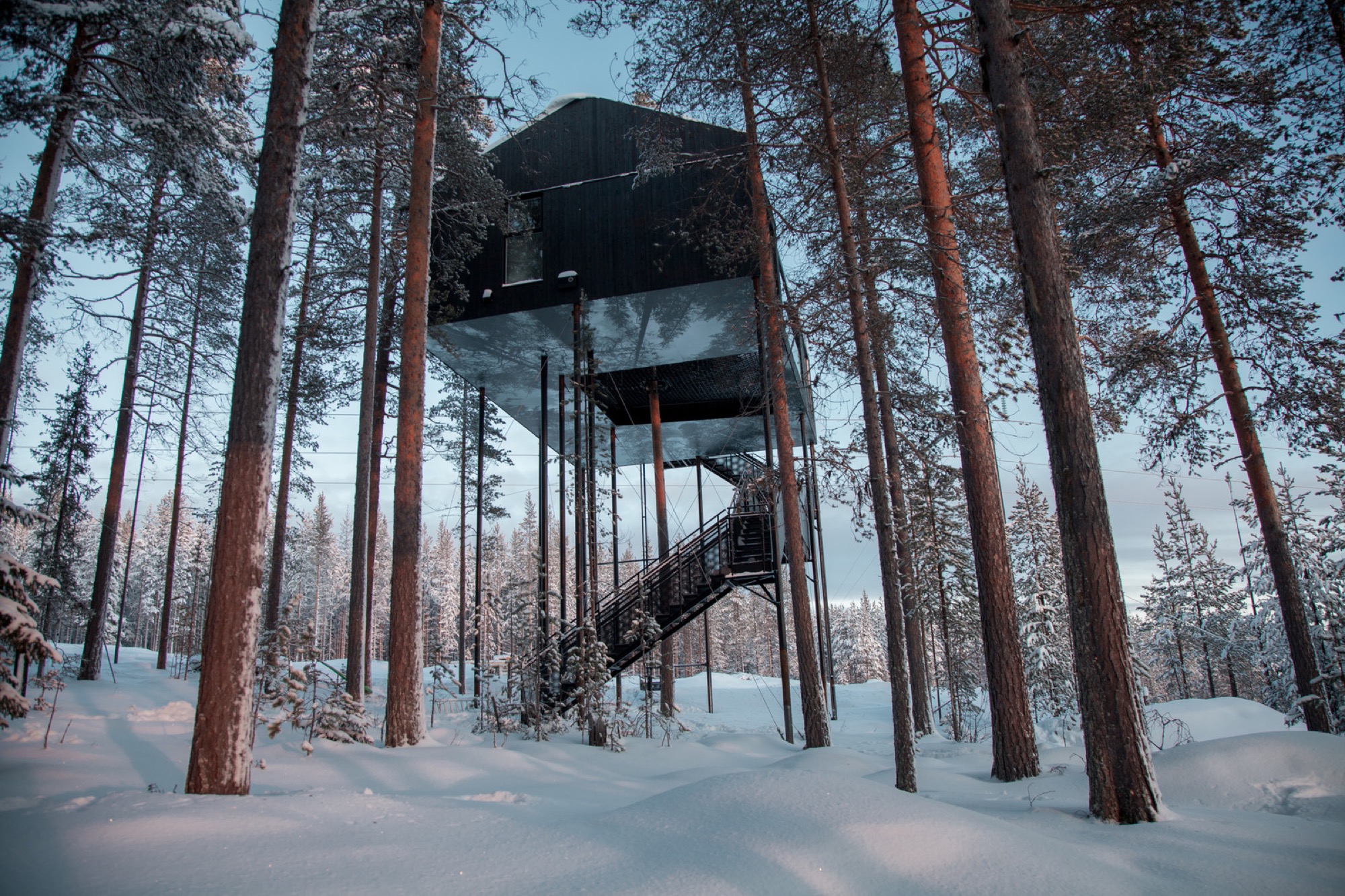
Treehotel’s 7th room in Sweden is a cabin that’s propped up in a pine canopy where guests can book a stay. To reduce the load of the trees and minimize the building's impact on the forest, 12 columns support the cabin. One tree stretches up through the net, emphasizing the connection to the outdoors.

Japanese architect Takashi Kobayashi of the Tree House People has been declared a "tree house master" by Design Made in Japan. Seamlessly integrating nature and design, this tiny tree house is certainly not just for children.

Inspired by the principle of biomimicry, Free Spirit Spheres’ goal is to "create new ways of living that are well-adapted to life on earth over the long haul." Based outside of Vancouver, the company specializes in tiny spherical tree houses that are works of art. You can even book an escape to spend the night in one at their forest hotels!
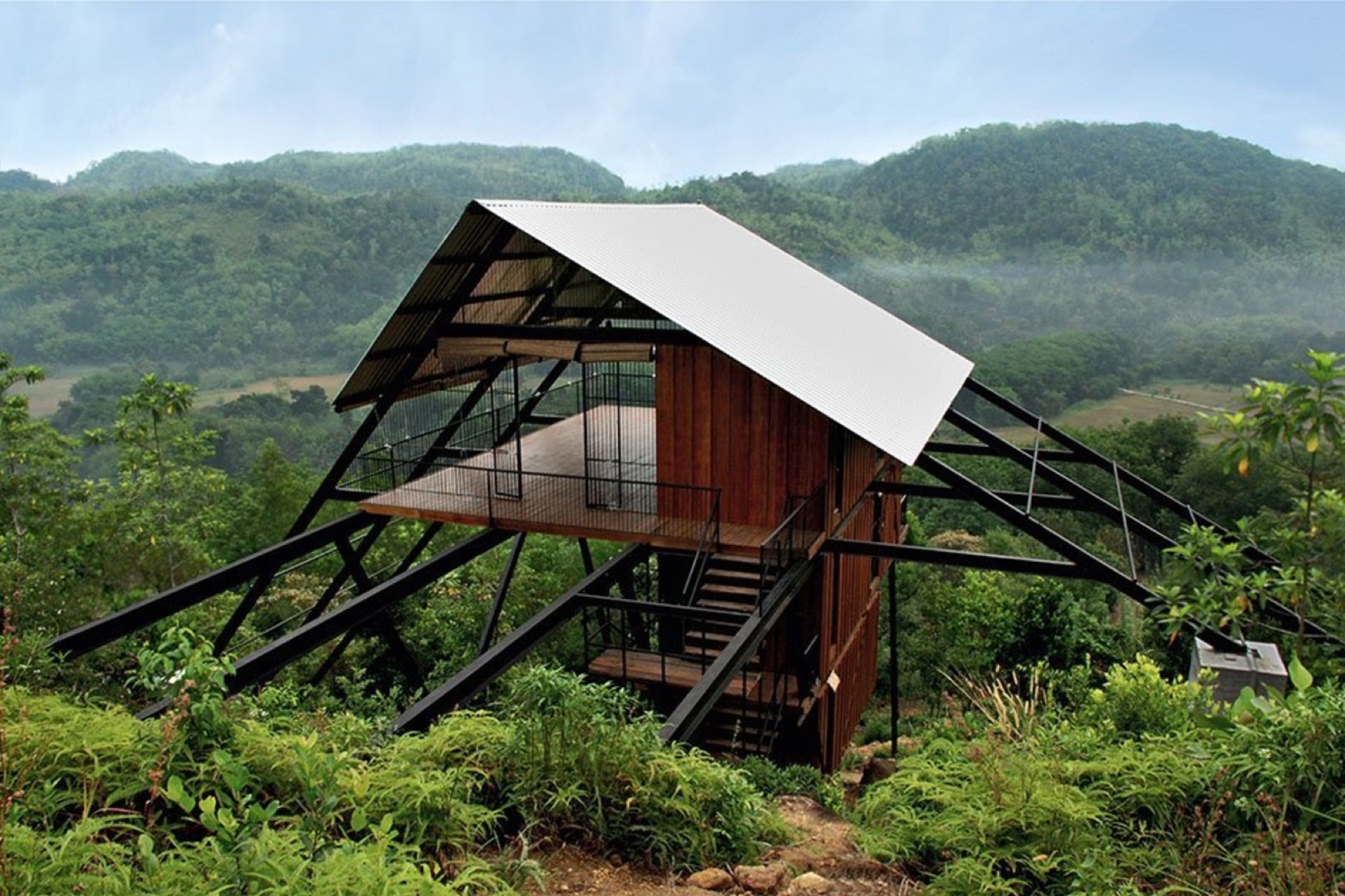
With the view from the Estate Bungalow in Matugama, Sri Lanka—designed by Narein Perara—you might just climb in and never want to leave.
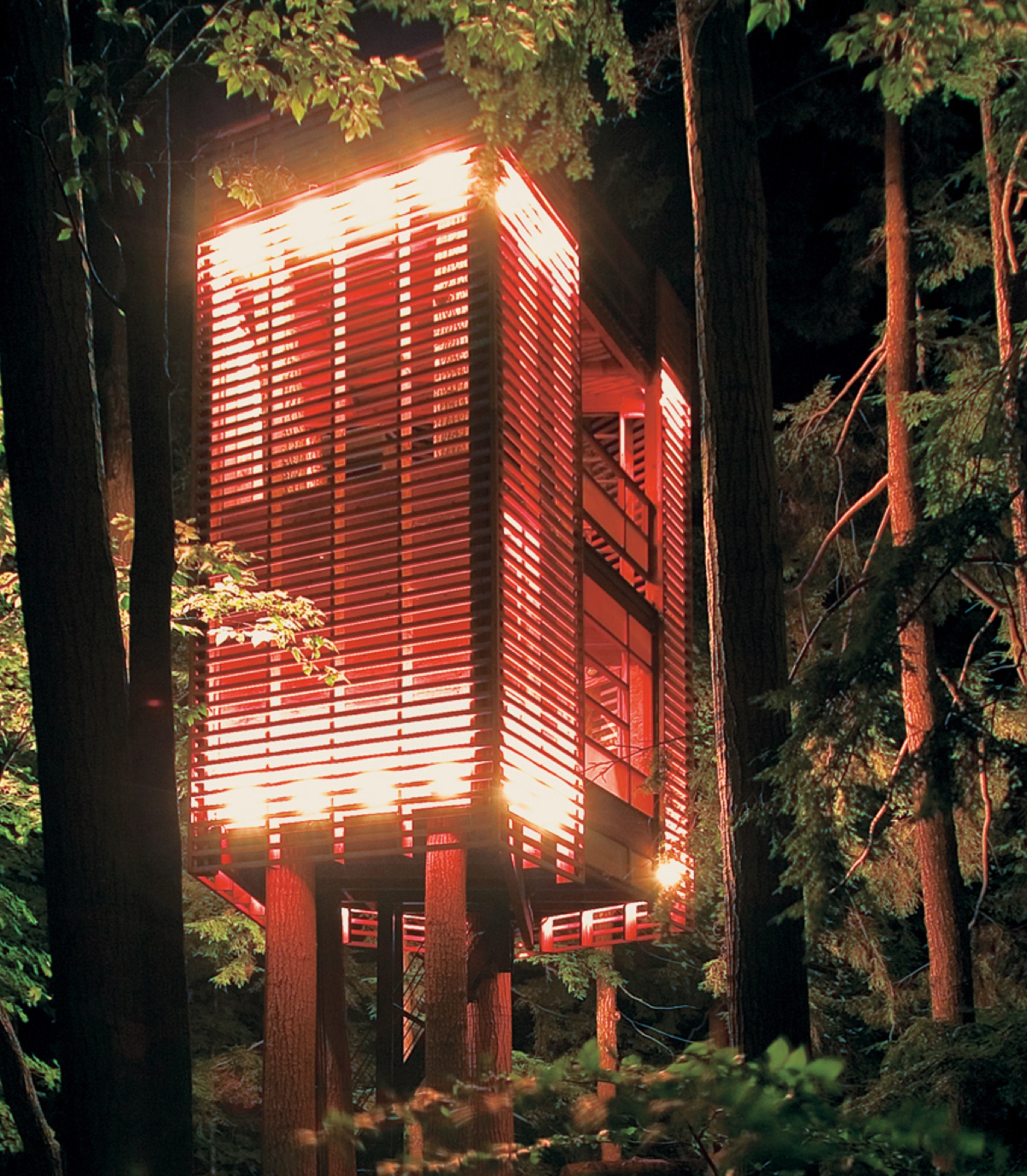
"I had to let the trees decide how the tree house would be," explains Lukasz Kos, a Toronto-based designer and cofounder of the architecture firm Testroom. The low-impact 4Treehouse is a lattice-frame structure that respects and responds to the nature surrounding it, appearing to levitate above the forest floor of Lake Muskoka, Ontario.

At only 172 square feet, this tiny tree house in the hills of Brentwood, California, was designed by Rockefeller Partners Architects and serves as a refuge, gallery, and guest cottage.

A little more on the traditional side, this tiny backyard tree house by Sticks and Bricks makes you want to disappear for a few hours with a pot of tea and a good book.
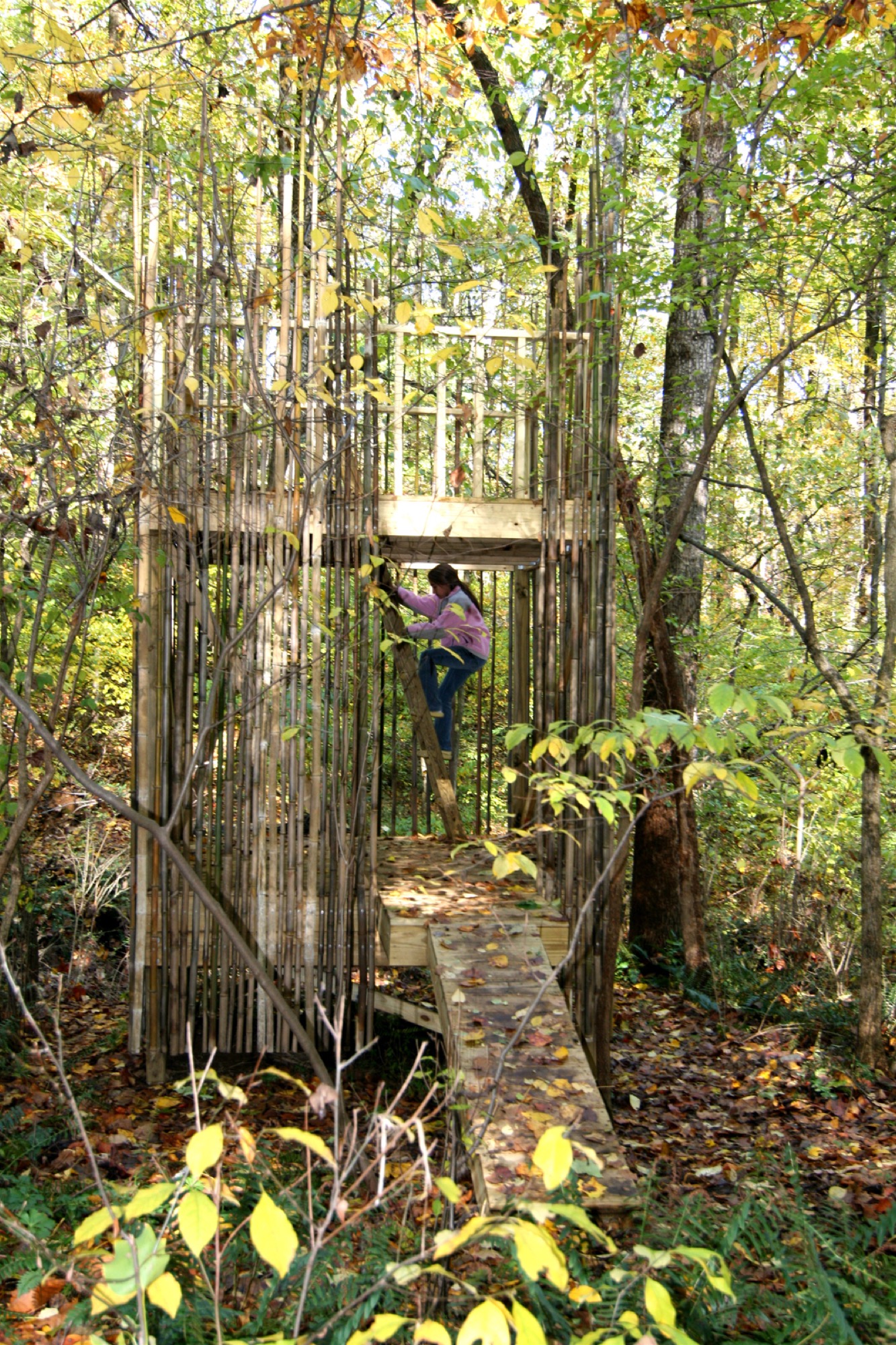
This 128-square-foot tree house outside Baltimore was designed by architects Laurie Stubb and her husband Peter. "The outdoors here are a big playground," she says. "We had always wanted to build something for the girls that looked natural." So, in the summer of 2008, they designed this structure both for the children and for themselves. "We wanted it to have a use after they're gone—a place we can sit in and read or have a drink and entertain company." △
Editor's Choice: Journey to Japan
The Beauty of Use
Hidden in the Japan Alps, a Czech-born artist makes woodstoves that match the simplicity of Japanese interiors. Read more »
The Skyward House
Japanese architect Kazuhiko Kishimoto designs a human-scale house for a retired teacher. Read more »
Repair With Gold
The Japanese tradition of wabi-sabi. Read more »
A Platform for Living
A weekend refuge in Japan’s Chichibu mountain range consists of a simple larch wood structure and two North Face tents for bedrooms. Read more »
Zen and the Art of Knife-Making
Using skills derived from the ancient craft of samurai sword-making, a blacksmith in the Japan Alps makes knives so delicate and dangerous they turn chopping into an artful act of passion. Read more »
In Search of Tenkara
The founder of Tenkara USA travels to Japan and brings back the traditional method of fly-fishing with a long rod and without a reel. Read more » △
The Swiss Art of Alpine Luxury
Jonathan Ducrest’s photo essay portrays the luxury hotel 7132 in Vals, Switzerland, with its iconic thermal baths designed by Pritzker Prize-winning Swiss architect Peter Zumthor.
Jonathan Ducrest’s photo essay portrays the luxury hotel 7132 in Vals, Switzerland, with its iconic thermal baths designed by Pritzker Prize-winning Swiss architect Peter Zumthor. The moment we pulled up to the 7132 Hotel (named after the village’s postal code) in one of their chauffeured Mercedes, I thought I was in the latest Bond movie. The sleek redesigned entrance, dark lighting, and thick blue carpeting have this feeling of 1970s heydays, where James would meet one of his assets. The main building contrasts the square, monochrome design of the hotel’s famous thermal baths.
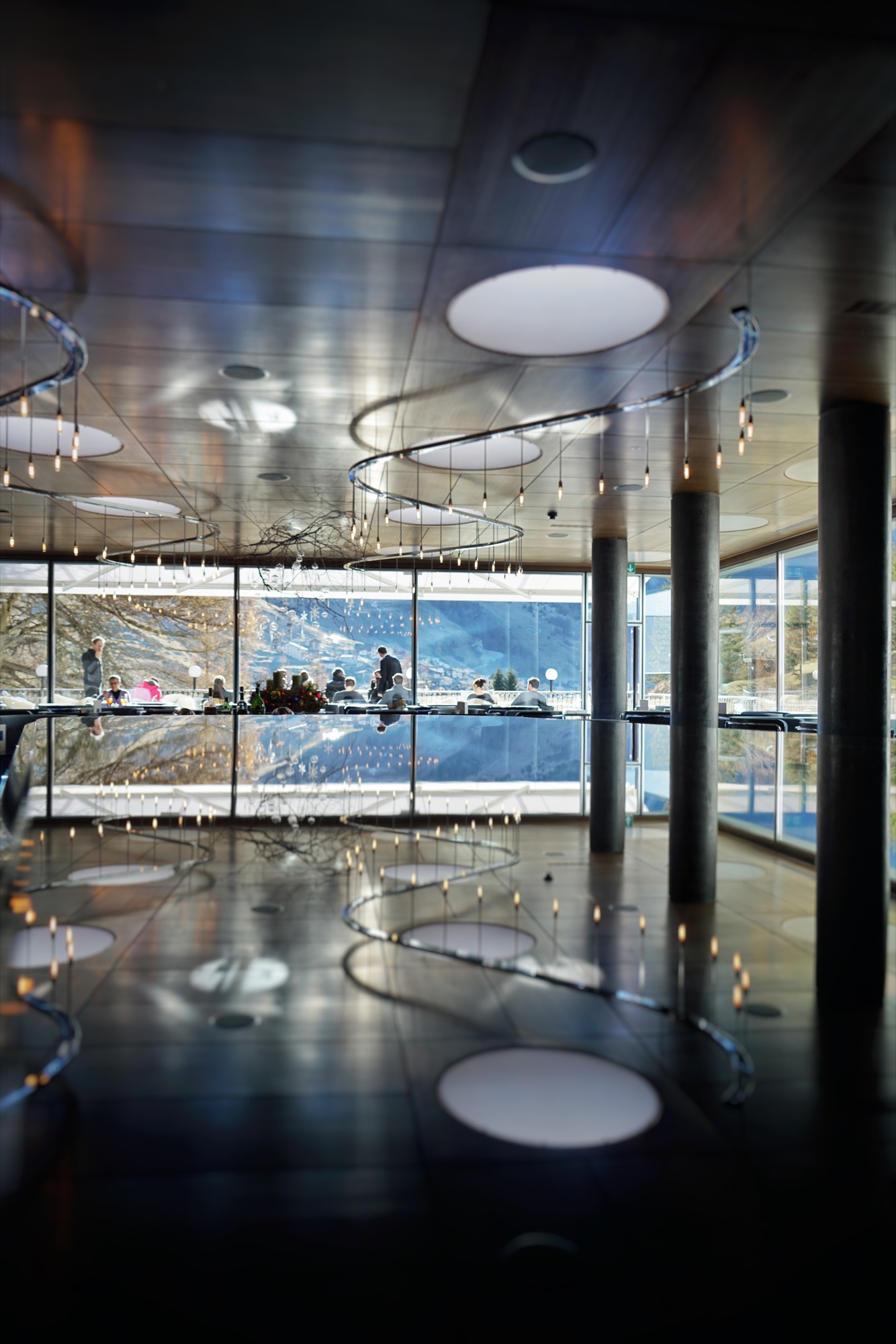
Zumthor’s thermal baths
Nestled at the end of a small valley in the Swiss Canton of the Grisons, the village of Vals became a must-see destination in the late 90s, when the thermal baths designed by Peter Zumthor opened.
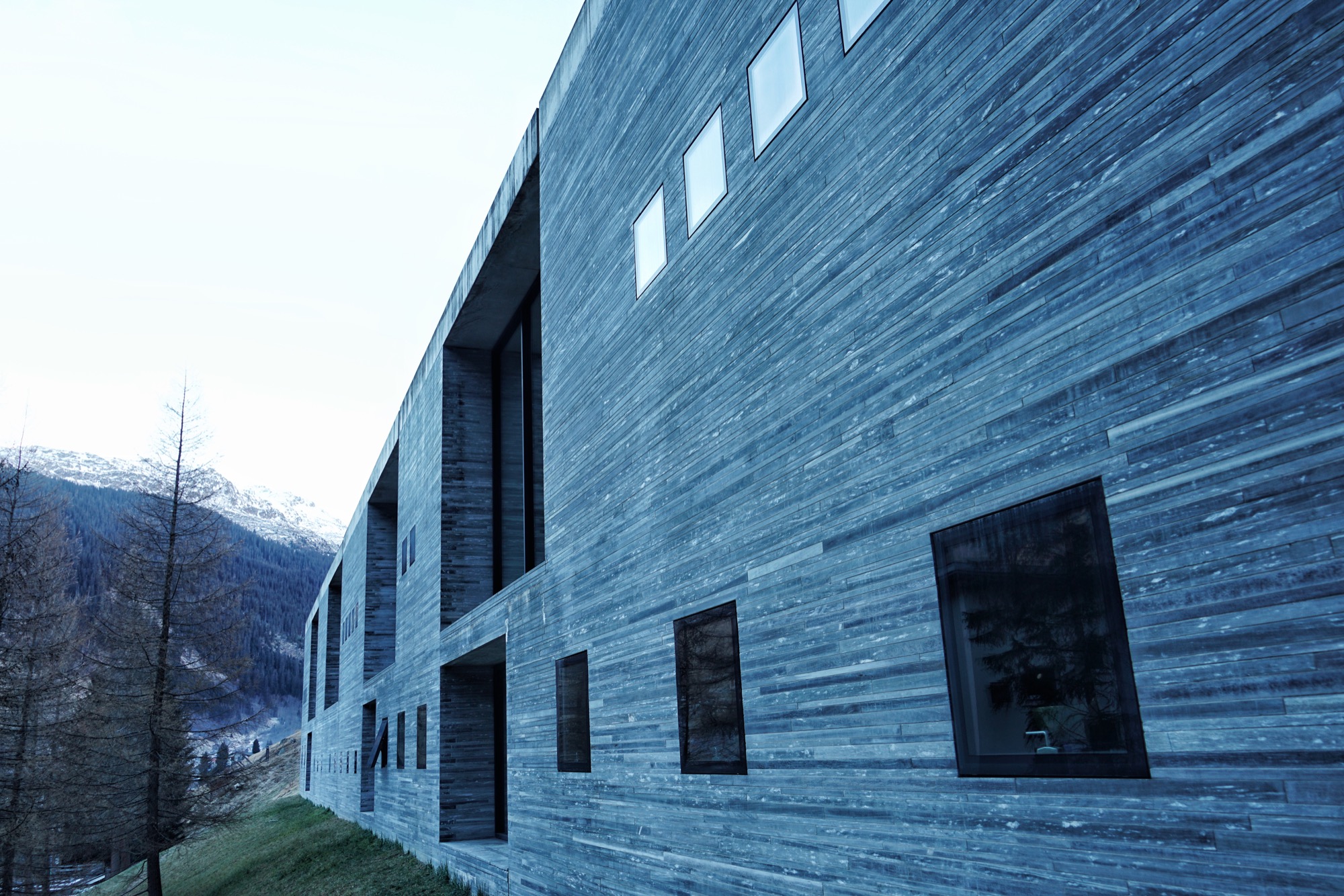
Built using only locally quarried slabs of quartzite, the minimalist spa evokes a cave and gives the impression to pre-date the hotel, which was originally built in the 60s.
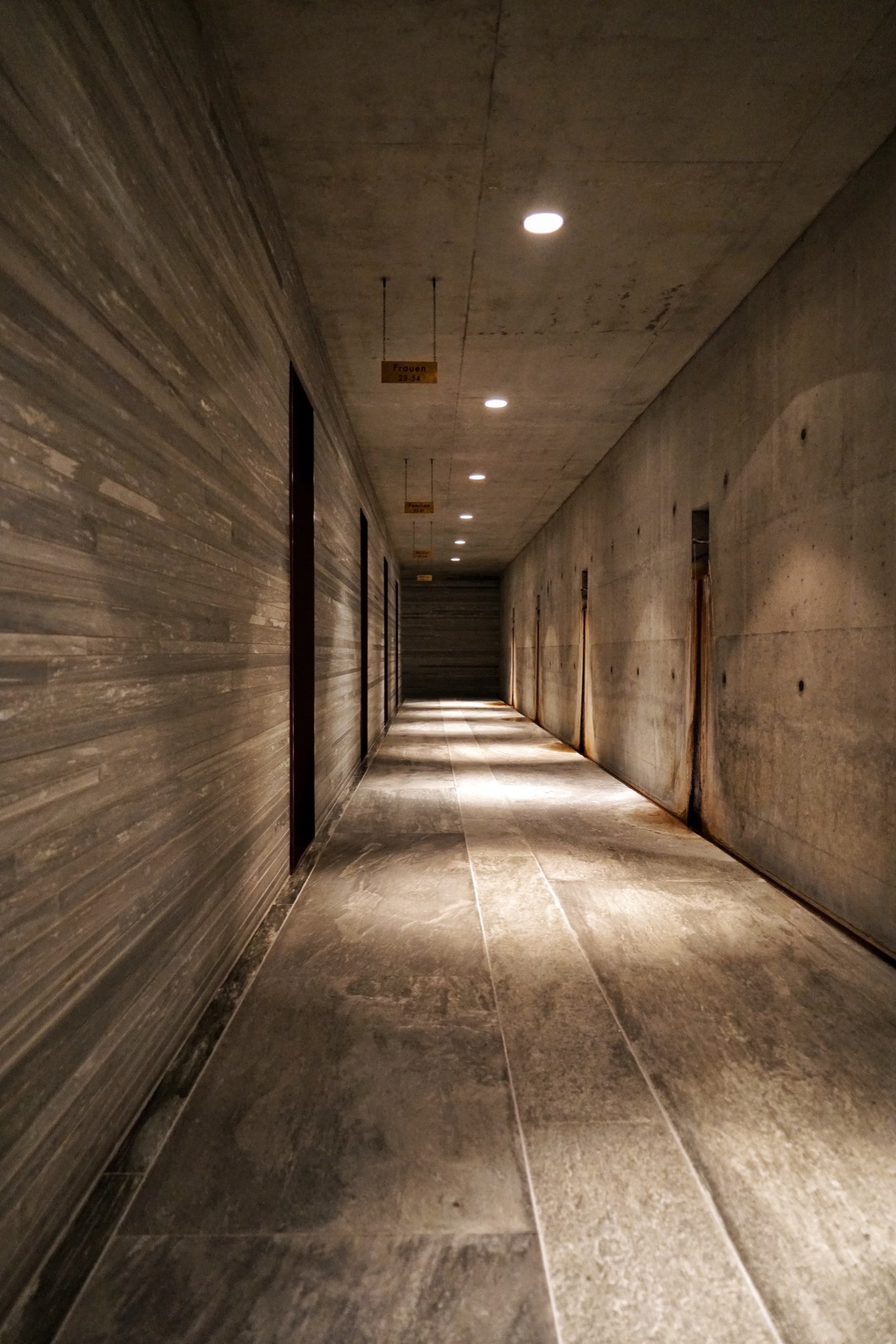
After walking through a dark, tunnel-like hallway and tapping the bracelet I was given at check-in onto the brass turnstile, I reached a larger concrete hall. On one side, thick leather tapestries curtain off the changing rooms with their glossy red lockers. On the other side, rusty pipes coming out of the wall are dripping water from the thermal spring.
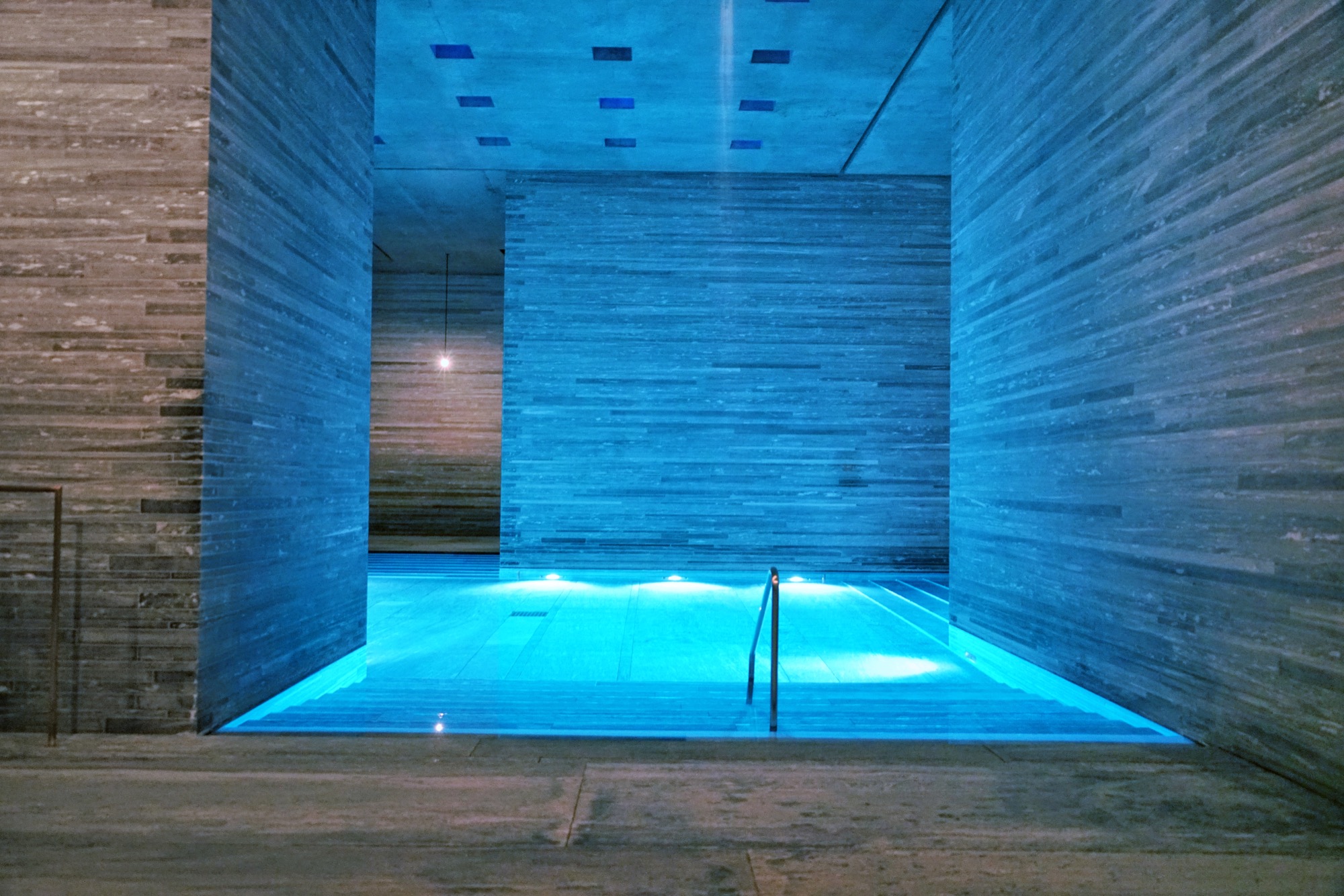
I stepped out on the other side of the changing room to find myself on the upper level, overlooking the main indoor pool in the center of the structure.
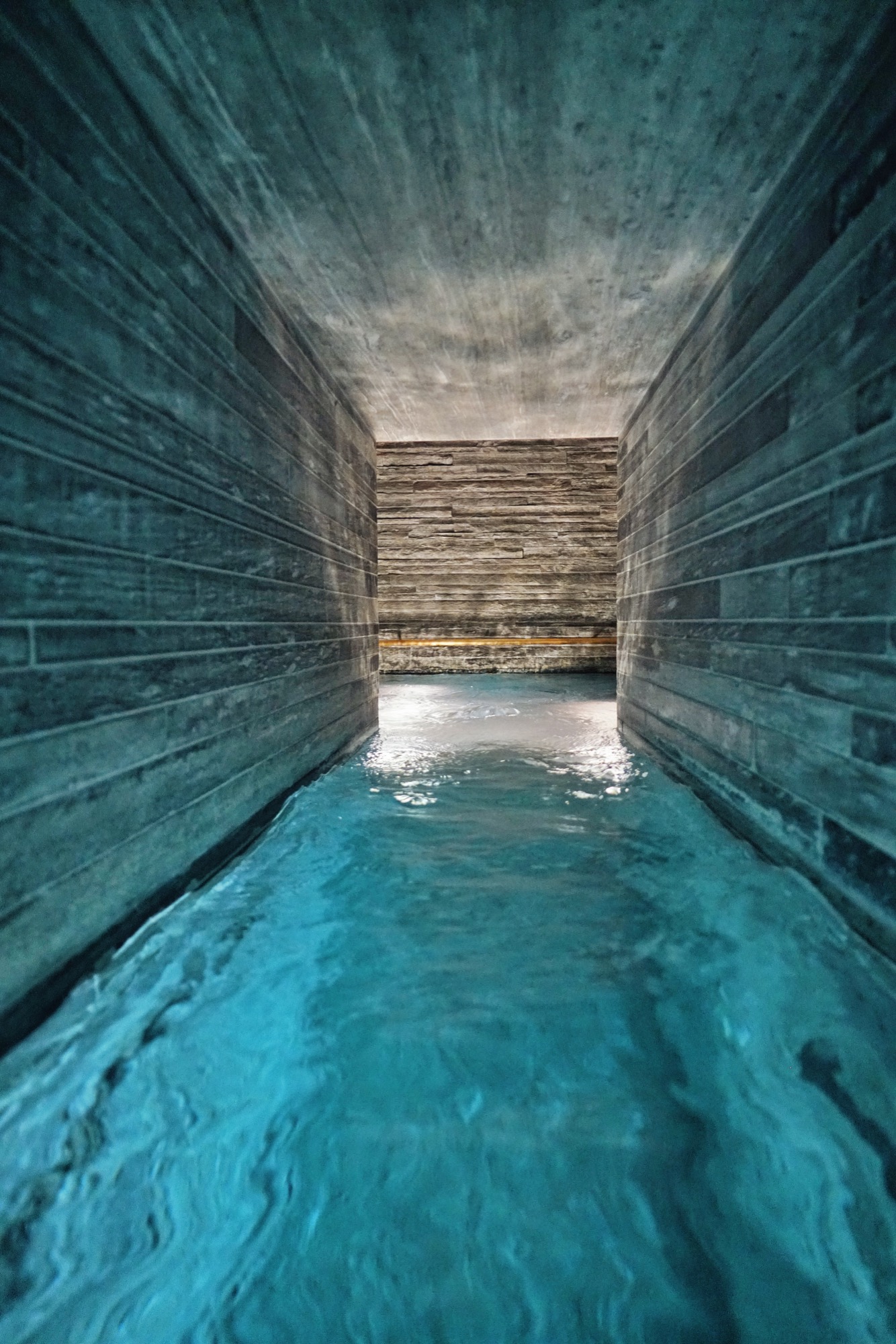
Smaller pools with different water temperatures, including one with floating flower petals, pushed me to explore every corner. An outdoor pool is accessible from the inside. Lounge chairs facing gigantic windows invited me to disconnect from my digital life and stare at the pine trees and the mountain across.
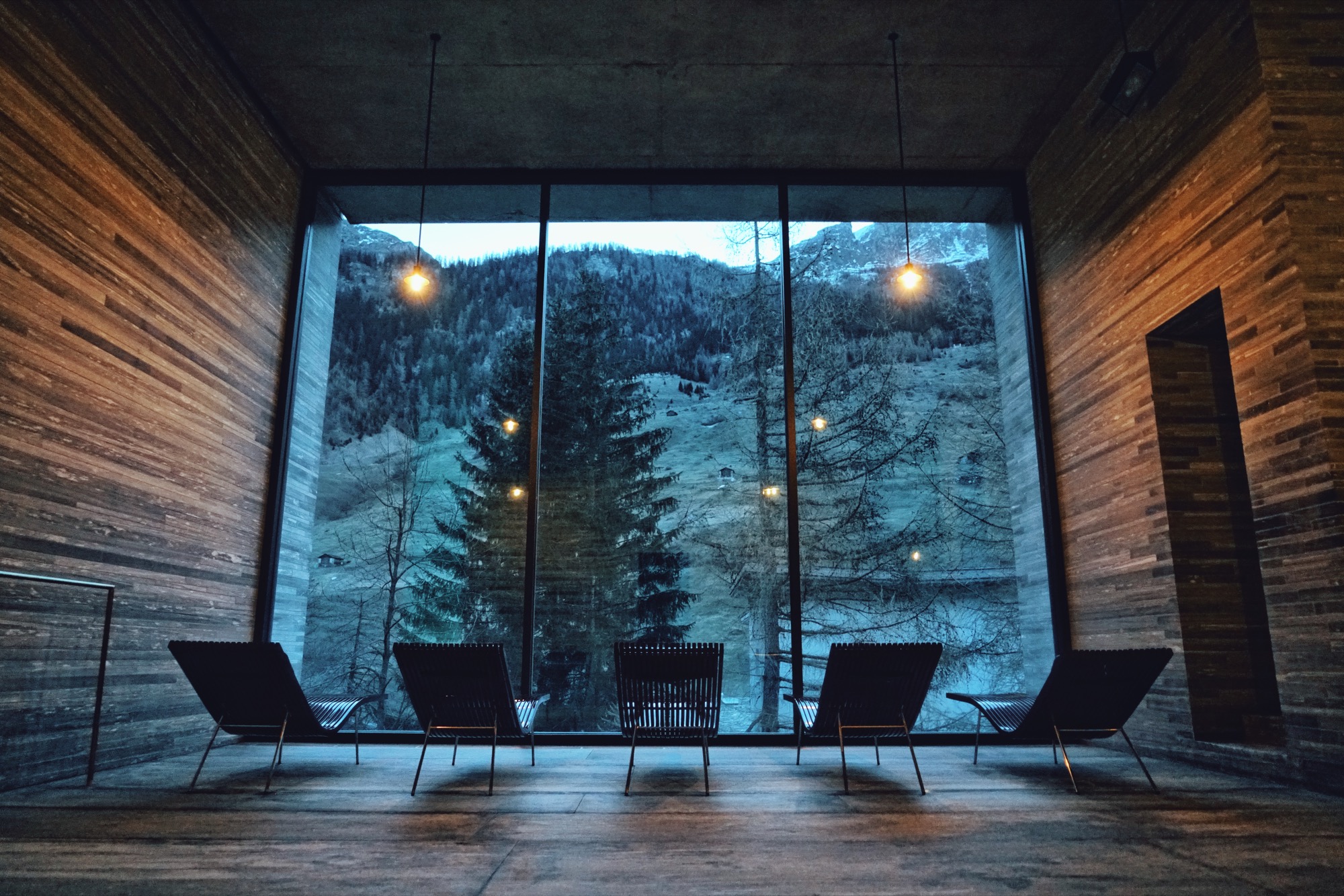
The hotel
Since the village of Vals sold the hotel and spa to a private investor in 2012, many of the rooms have been redesigned, including a dramatic penthouse suite at the top of the main building. One of the luxury hotel’s five structures is called the House of Architects and features rooms designed by Tadao Ando, Kengo Kuma, Thom Mayne and, naturally, the master of Swiss minimalism himself, Peter Zumthor. The room I stayed in was designed by Japanese architect Tadao Ando. Its large Swiss oak panels enveloped me like a cocoon.
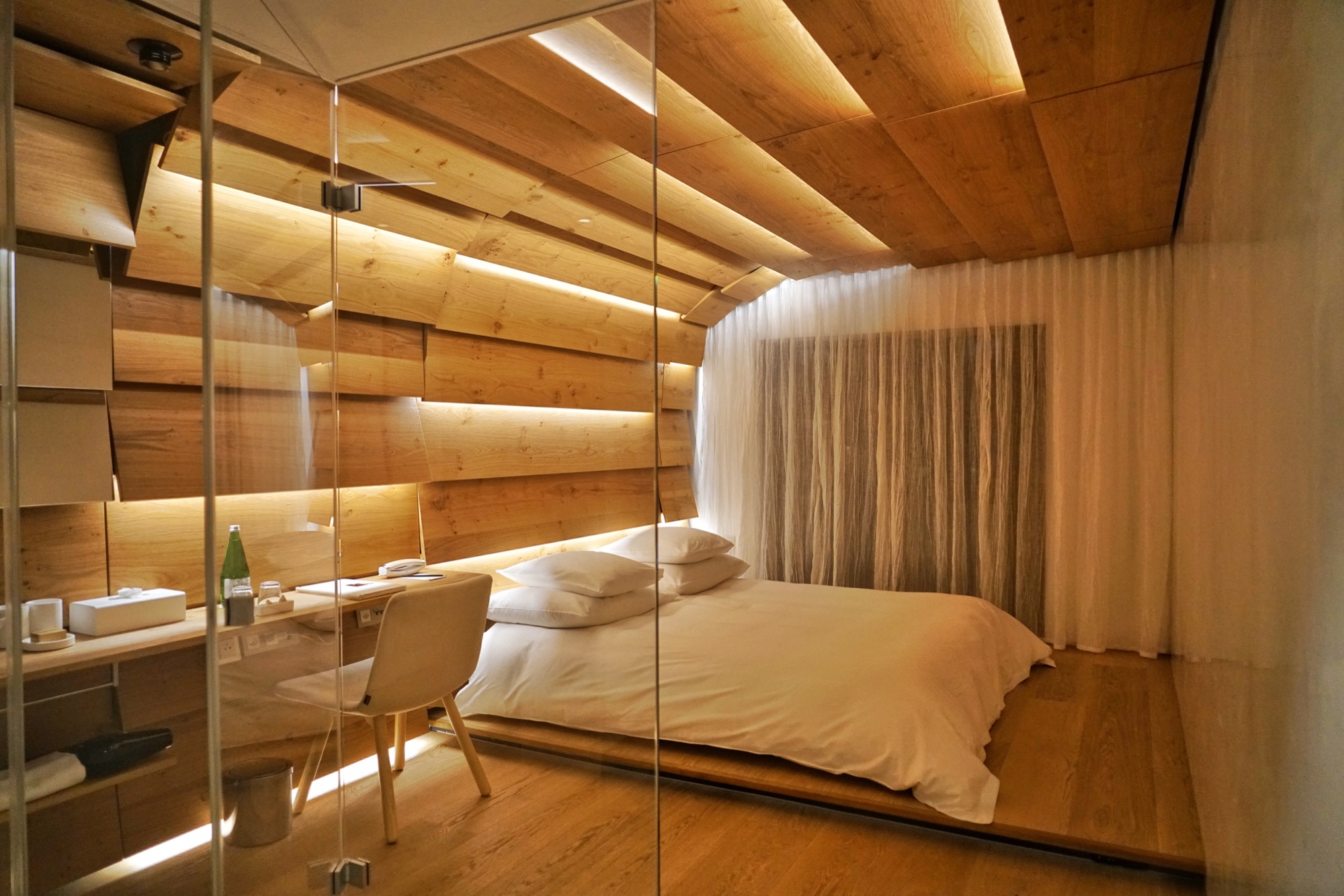
The lobby bar, where you can sip on an Aperol spritz, and the terrace, where you can take your afternoon tea cuddled under a thick sheepskin blanket, act as the hotel’s living room, where it’s easy to socialize with fellow guests.
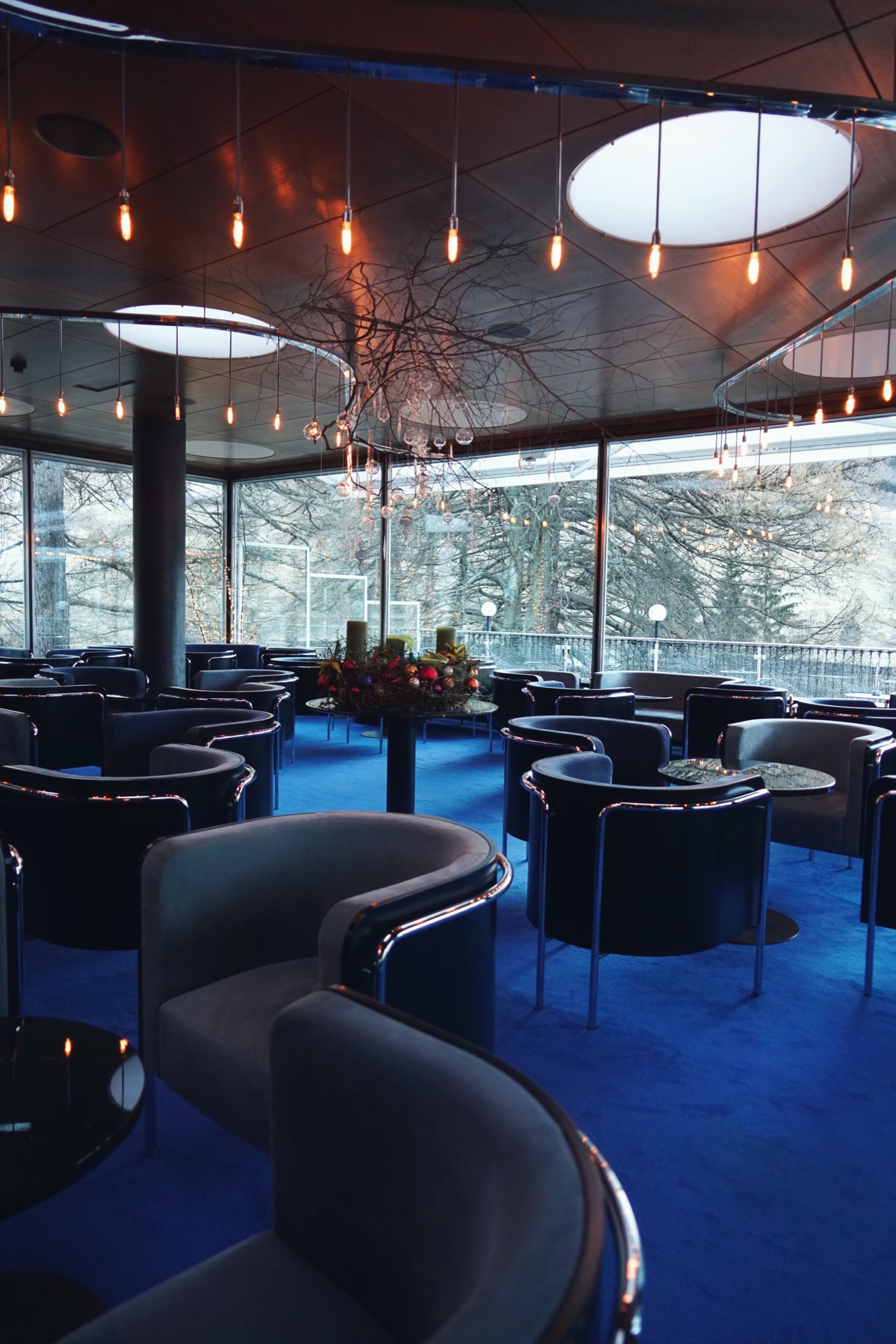
I devoured the regional cheeses and cured meats from the breakfast buffet after my swim in the outside pool under the stars at dawn.
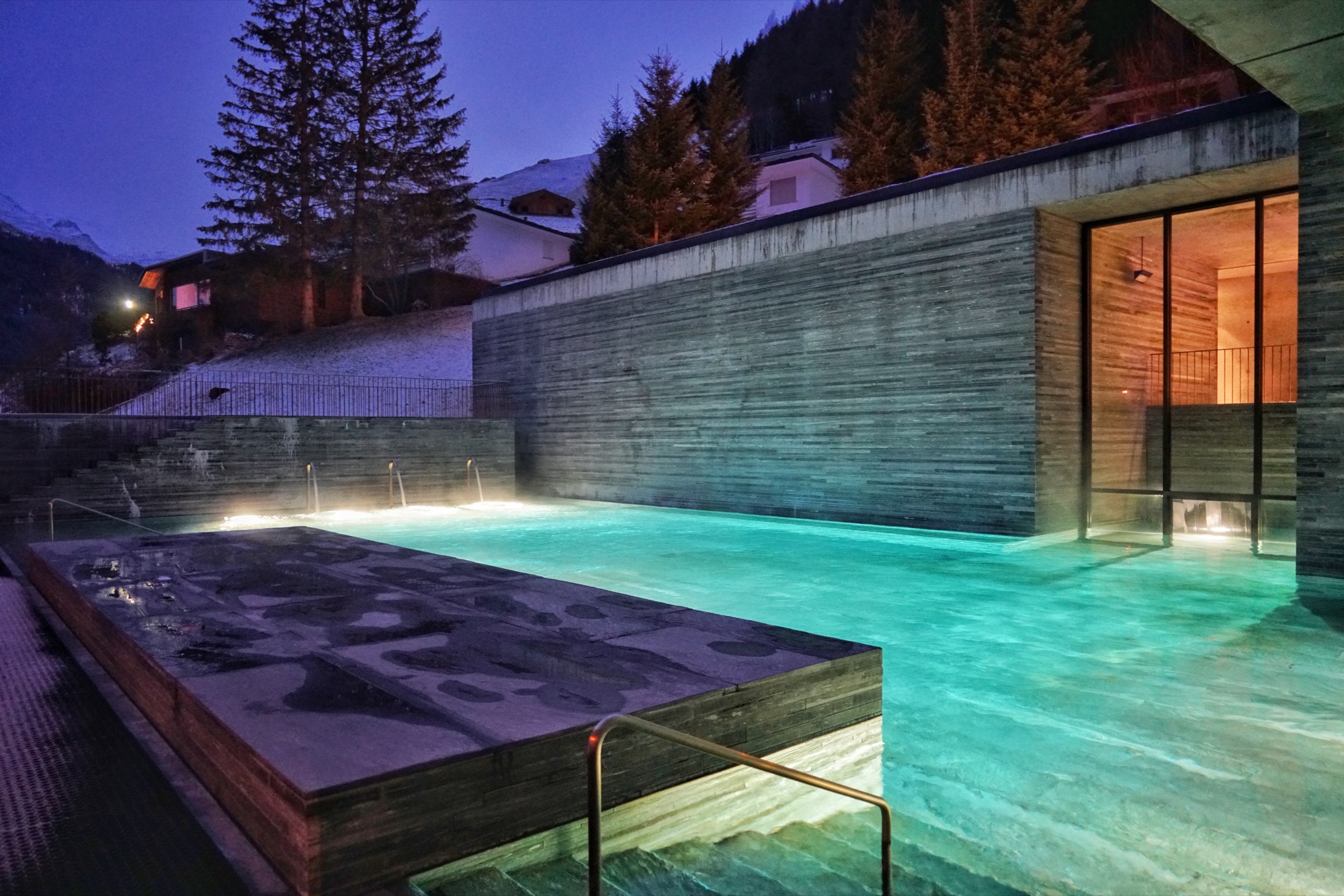
The village is a quick stroll from the hotel. I had the opportunity to visit Vals both in winter and in summer. It’s a completely different experience. Do both, if you can. △
Waking Up to Adventure
Zack Giffin, professional freeskier and cohost of the television series Tiny House Nation, builds himself a mobile 112-square-foot (10-square-meter) ski-in, ski-out chalet so winsome it wipes out the ski bum stigma.
Zack Giffin, professional freeskier and cohost of the television series Tiny House Nation, builds himself a mobile 112-square-foot (10-square-meter) ski-in, ski-out chalet so winsome it wipes out the ski bum stigma.
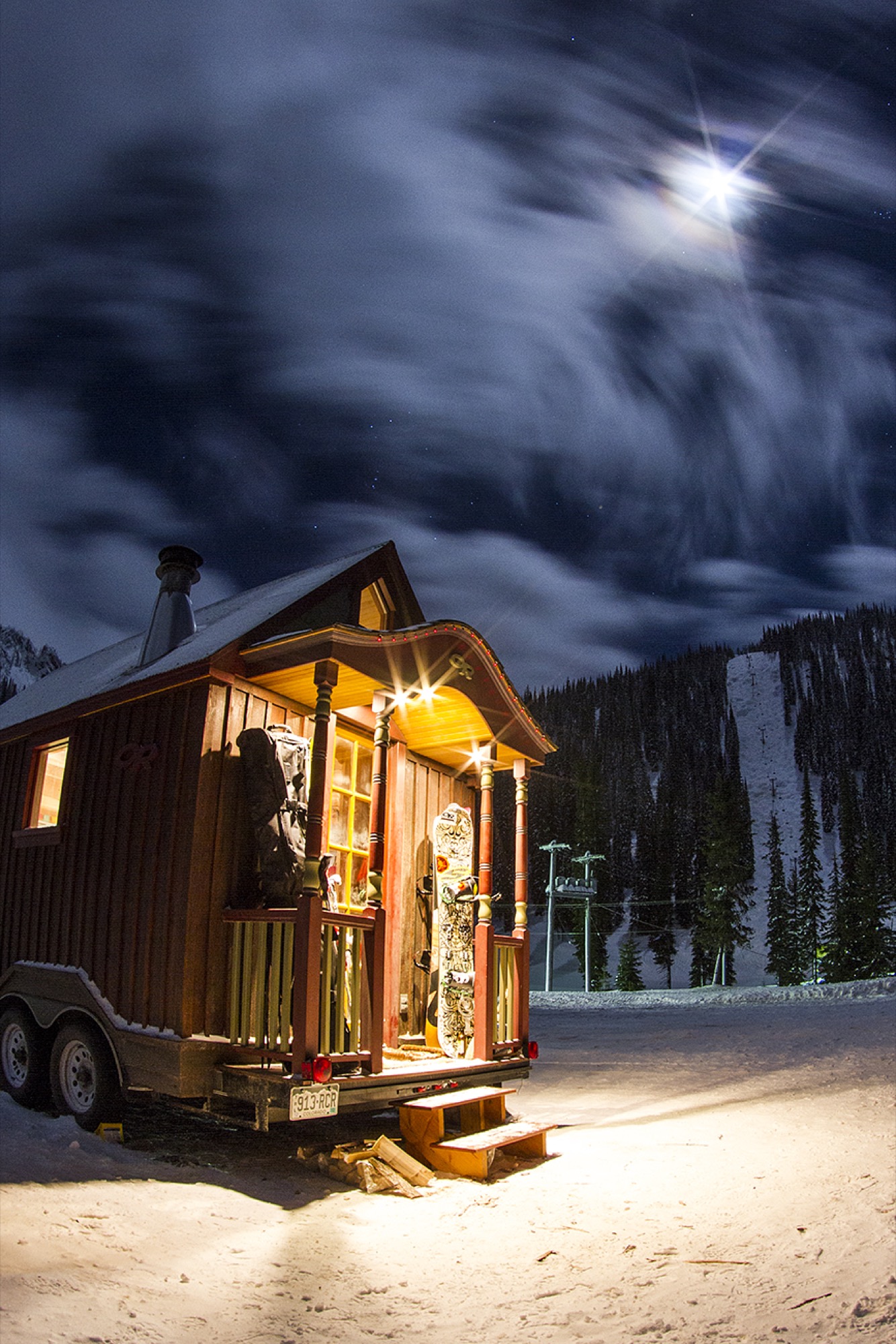
“My love for the mountains comes from my family. My whole identity was to be that mountain kid,” Zack Giffin says about growing up in Gold Hill, Colorado. His parents had moved to the tiny mountain community ten miles above Boulder to raise their three sons (Zack is the middle child) to revere the outdoors as much as they did. His mother, a university professor, was an avid backpacker. His father, a ceramics artist and prolific inventor, was a fisherman and a rock climber.
The parents’ plan worked. Giffin blossomed into a professional skier, hungry for adventure and romantic evenings in the mountains.
Young Giffin embraced another passion of his father’s: working with wood. Like Giffin Senior, Zack is not a carpenter by trade. Nevertheless, “My dad instilled in me that you can make things yourself, and that you are the only one you can really rely on.”
That paternal sagacity resonates with Giffin whether he builds tiny houses or is about to drop down the face of a glacier. “The development in both those areas is in learning how to believe in yourself, to trust you’re making the right call.” He’s had mentors on the snow and in the shop, but he, like everyone, came to a point when there was no one to reference. “When you are on your own, that’s when a lot of growing up happens.”
“My dad instilled in me that you can make things yourself, and that you are the only one you can really rely on.”

Alone
The tragedy that changed Giffin’s life in an instant happened neither on the big mountain nor on television. It happened in the home he shared with a roommate in Boulder. It forever altered what home meant to him. “I had a gnarly incident with a friend,” Giffin reveals, his voice suddenly somber. The young man who had been like a little brother to Giffin, accidentally shot himself to death. “It was pretty dramatic. I was in the house, and all of a sudden I no longer felt the security of home in that space.”
He no longer wanted to live there. “It was this catalyst in my life for making a change. There was sadness, and I really wanted to pursue my dream of being a skier.” All at once grasping life’s preciousness, Giffin bought an RV and persuaded his little brother to move to Mount Baker, Washington—a place he was “absolutely in love with” at the time. “That was a big shift, and I experienced a lot of stigmatism.” He’s talking about being perceived as “the guy who lives in an RV.” No soul asked him about his motivation to uproot and chase his dream. The following winter, Giffin pushed himself yet nearer the fringe of venal bourgeoisie. He moved into a van that he outfitted with a wood stove.
Boyfriend material
Then, he fell in love with fellow snow gypsy Molly Baker, who is also a professional skier. “She was so cool and totally would have done it, but I had experienced that stigma and couldn’t bring her into that world with a good conscience,” he admits. “No girl wants to go back to her parents and explain that her new boyfriend actually lives in a van.”
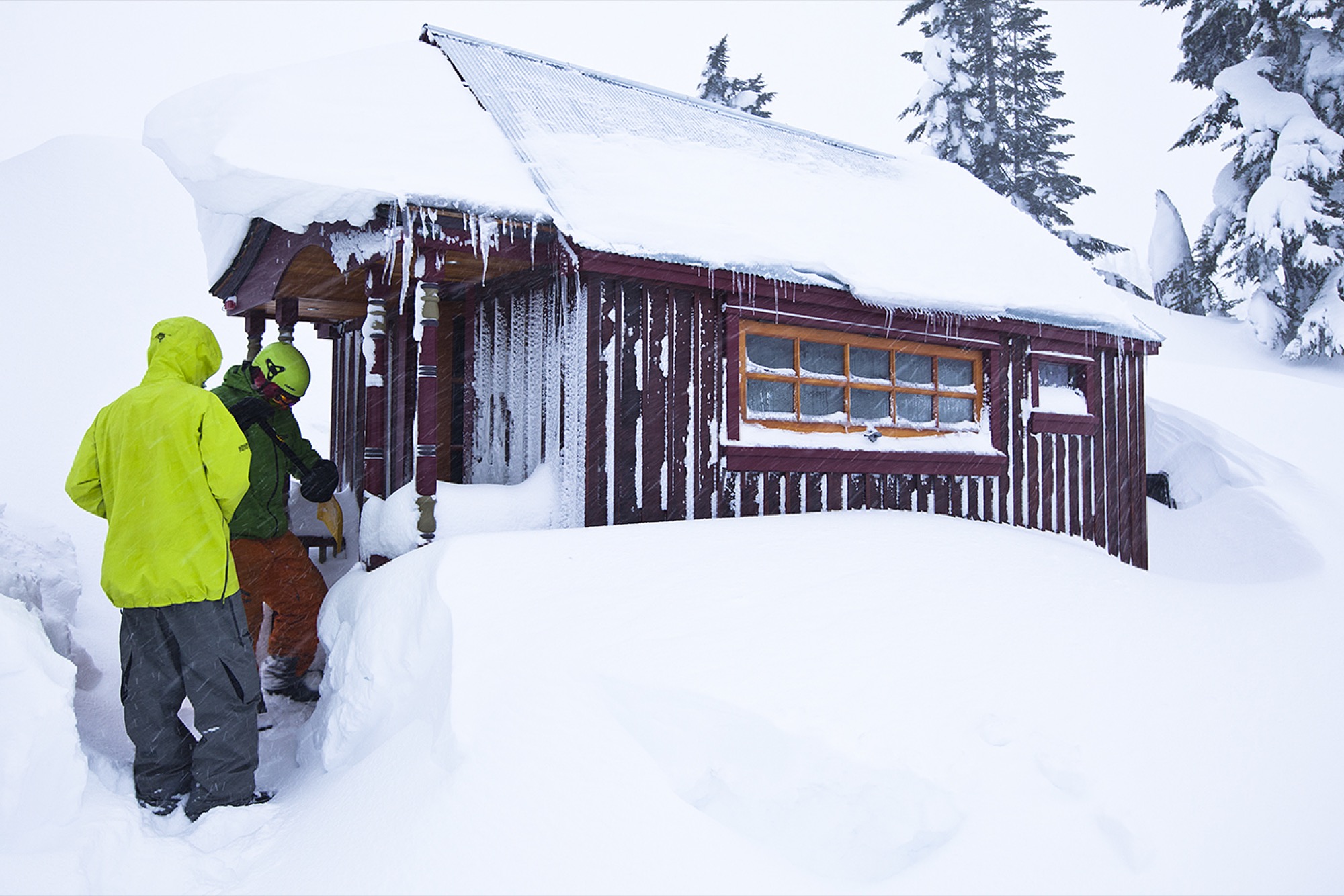
So he built a 112-square-foot (10-square-meter) tiny house on wheels for Baker and himself. It became more than a vehicle to keep living expenses low. Giffin once again owned a place he wanted to come home to and could take pride in. “It’s human nature. It’s a disorienting feeling to be out there, floating around, and not have this idea of where home is,” he says. “With a tiny house, you can provide that for yourself with a lot less money and without this ridiculous classist stigma.”
Looking back on how differently people reacted to his RV or van compared with the tiny house, Giffin is astounded. “I would park my RV at a friend’s, and the neighbor would come over within a day, asking me how long it’s going to be there,” he remembers. “Now, the neighbors still come over. But now they want a tour. They want to meet the person who’s built such a cool thing.”
“No girl wants to go back to her parents and explain that her new boyfriend actually lives in a van.”
Returning time, restoring pride
Keen on helping others feel that sense of pride, Giffin, in his mid-thirties, now builds tiny houses all across the country on his television show Tiny House Nation. The movement hits a nerve with the nation. Along with irrepressible concerns about the environment and the economy, Giffin senses a growing disdain for global materialism, amplified in increasing average home sizes. Living minimally speaks to all those fears. “I see that pendulum swinging back in the tiny house movement.”
He passionately wants to help people get out of the trap of imbalanced wages versus home prices. “So many people in my generation are going through school and have all these dreams and passions, and then economic reality forces them into jobs that have nothing to do with what they studied,” he says. “As time goes on, that turns into their reality, and hopes get left behind.”
Leaving behind material things and abundant living space instead of dreams, on the other hand, has one tremendous reward: returned time. “I love to watch people make that transition, because it’s not just about the physical detachment from the things that were controlling your life, it’s also this big decision that takes a lot of courage. And you can be so proud of yourself for making it through to the other side.”
Free-skier
Freedom from being forced to work longer hours to afford a bigger house is one important appeal of tiny-house living. The other one is mobility. When Giffin is not filming, he pulls his ski chalet on wheels right up to the mountain. “The desire to wake up where your next adventure is, this immediacy, is a universal understanding within the ski culture,” he says. “With skiing, half of the process is the commute. Only unbelievably rich people get to stay right at the mountain.”
Or, you’re living in the parking lot.
“The desire to wake up where your next adventure is, this immediacy, is a universal understanding within the ski culture.”
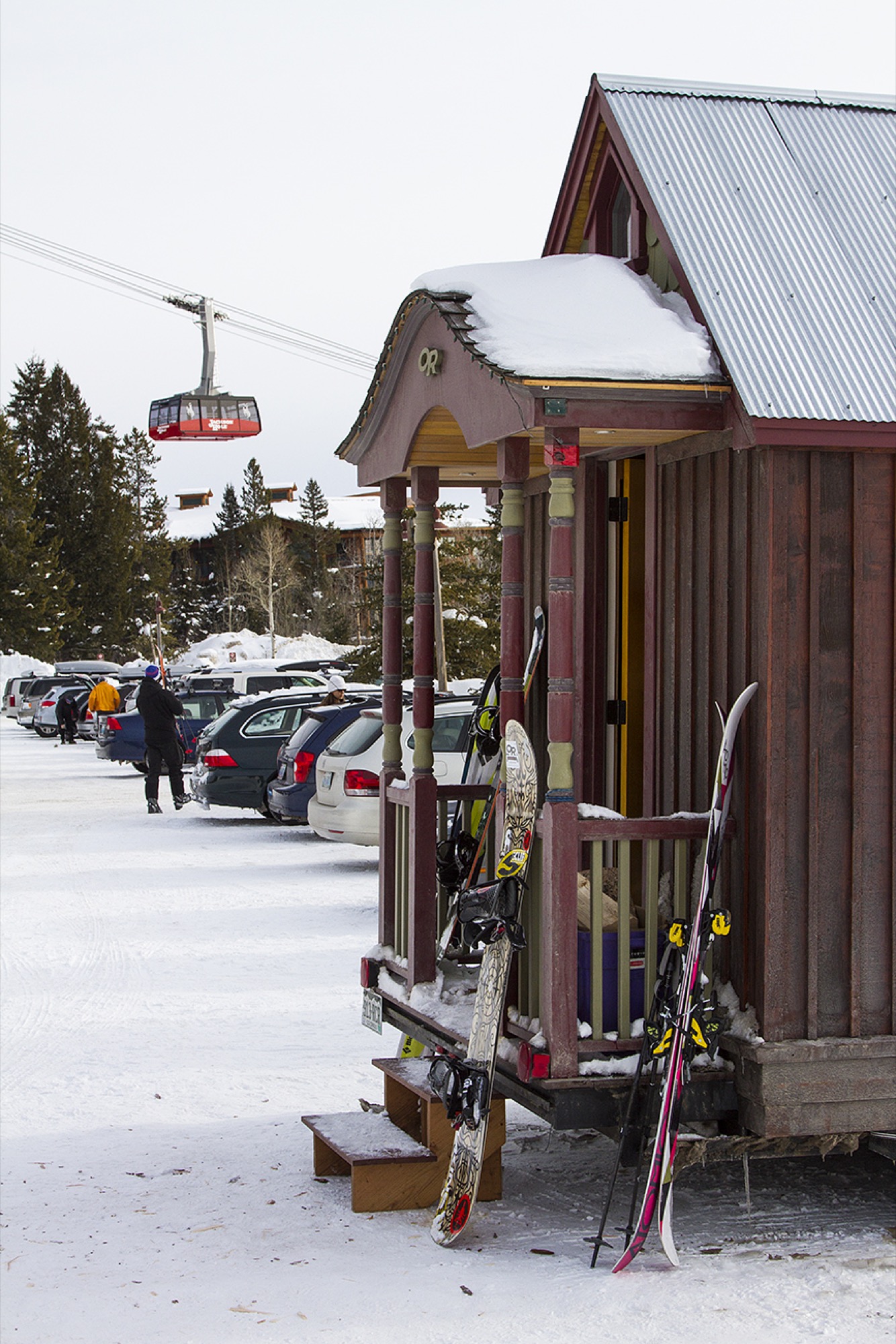
Giffin values being on the mountain before anyone else, and, at the end of the day, not being stuck in traffic, sitting in the car in his wet gear. Instead, he skis right up to the place he calls home. “One of the most beautiful things about tiny-house living are these incredibly romantic situations. You’re collecting all these little tidbits of extra time. It’s the end of a beautiful ski day, and it’s such a satisfying feeling to be in a place you love, that feels like home, and that’s in the mountains. But you have to fill that time or you are going to experience this crazy thing called boredom. And that’s just beautiful. It turns into my time for reading books, stretching, playing guitar, and having intense conversations with Molly . . . or a dance party. All these things lead into a quality of life worth living for.” △
“One of the most beautiful things about tiny-house living are these incredibly romantic situations. You’re collecting all these little tidbits of extra time.”
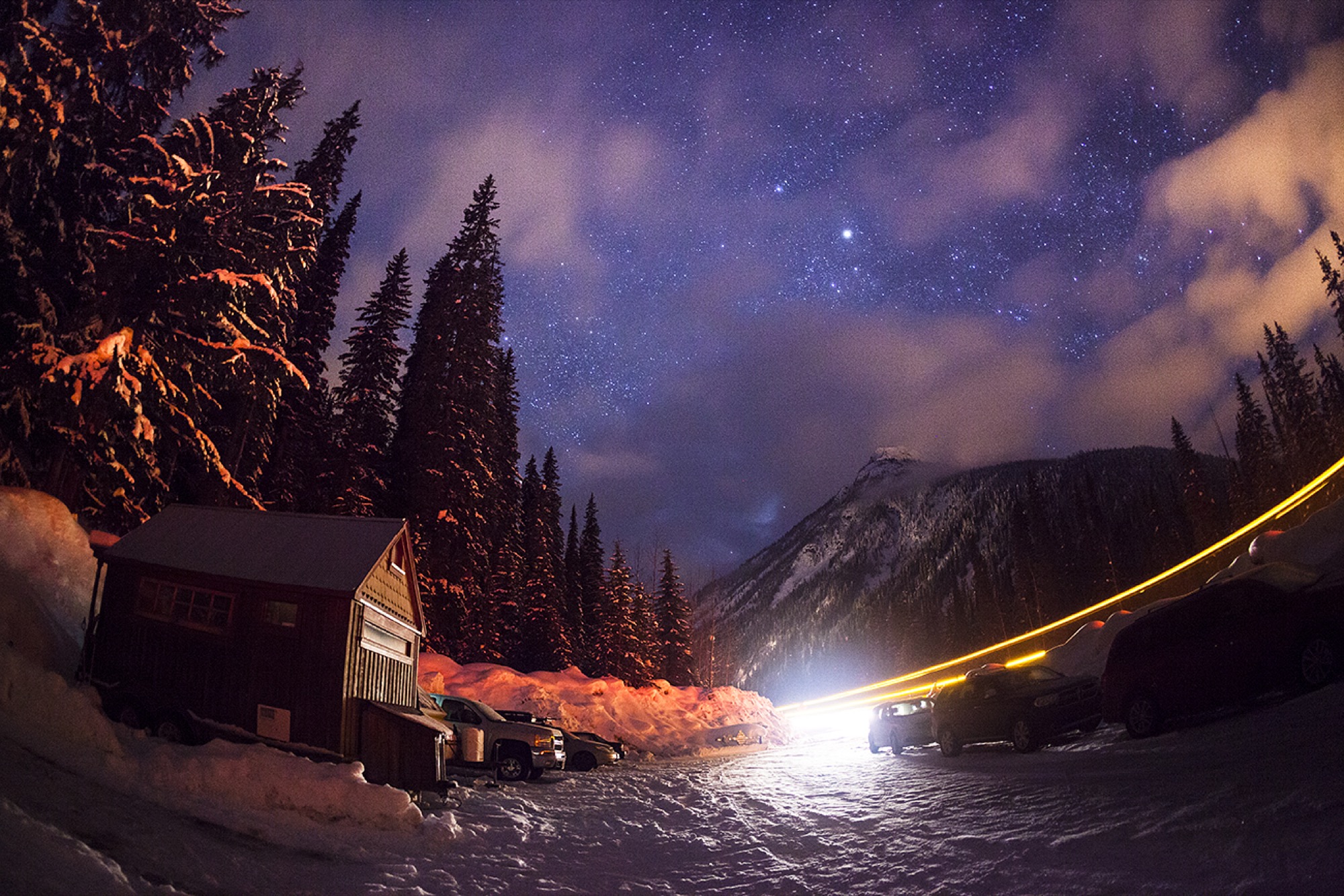
This story was originally published in winter 2014/15, in our printed Alpine Modern quarterly.
Alps // 40
An unfiltered, low-speed journey across Swiss peaks in words and images by Boulder photographer Jamie Kripke
Slowing down gives us more time to look. Having more time to look changes how we see. I wanted to slow down.
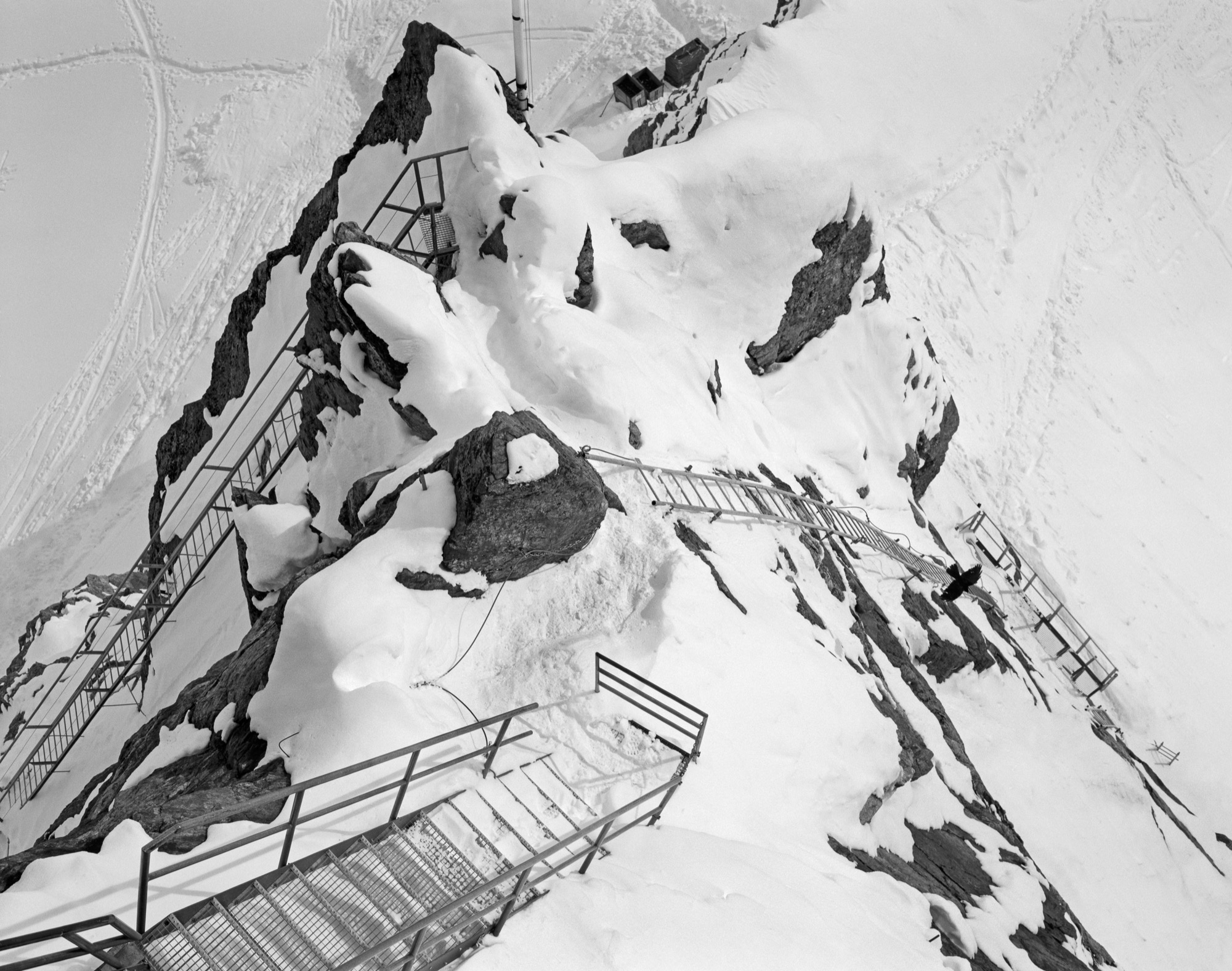
Using alpine touring skis, a small backpack, a folding medium-format camera, and twelve rolls of black-and-white film with ten exposures per roll, I set out to traverse and photograph a high route across the Alps. Each piece of equipment for this trip was chosen for its simplicity as well as its limitations—and for the extra time, attention, and patience it requires.
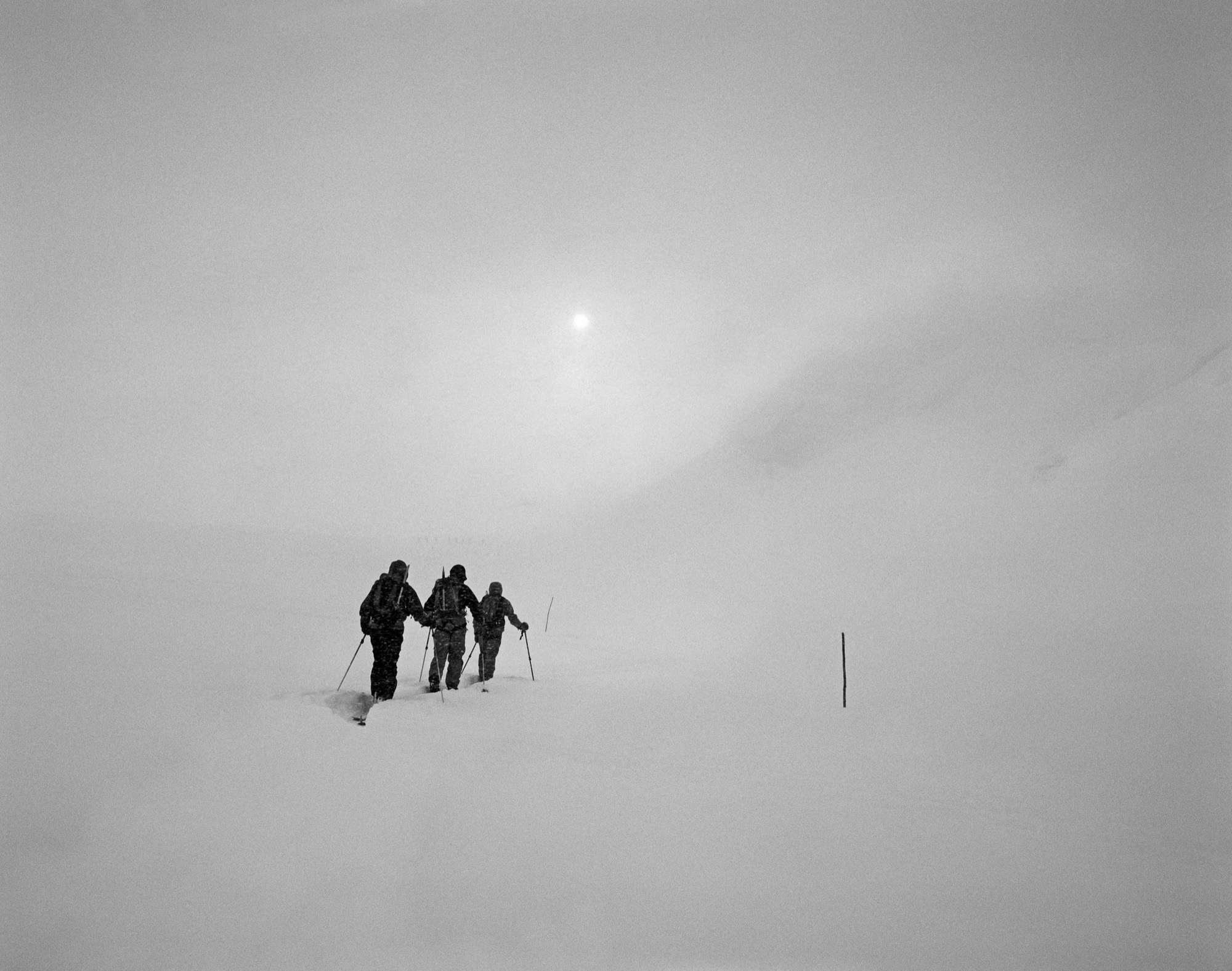
Traveling up and over mountains by skis has a way of shifting time away from something that is measured in minutes, hours, and days. Ascending one step at a time through untracked snow, the units become ski lengths, pole plants, breaths, sips of water, bites of food, daydreams, changes in weather or light.

The physical limitations of low-speed film in a mechanical camera call for a heightened attention to composition, exposure, and technique. Every frame becomes its own unique experience—one that builds gradually with each precise movement of the camera, each small adjustment for focus, aperture, or shutter speed.
"Every frame becomes its own unique experience."
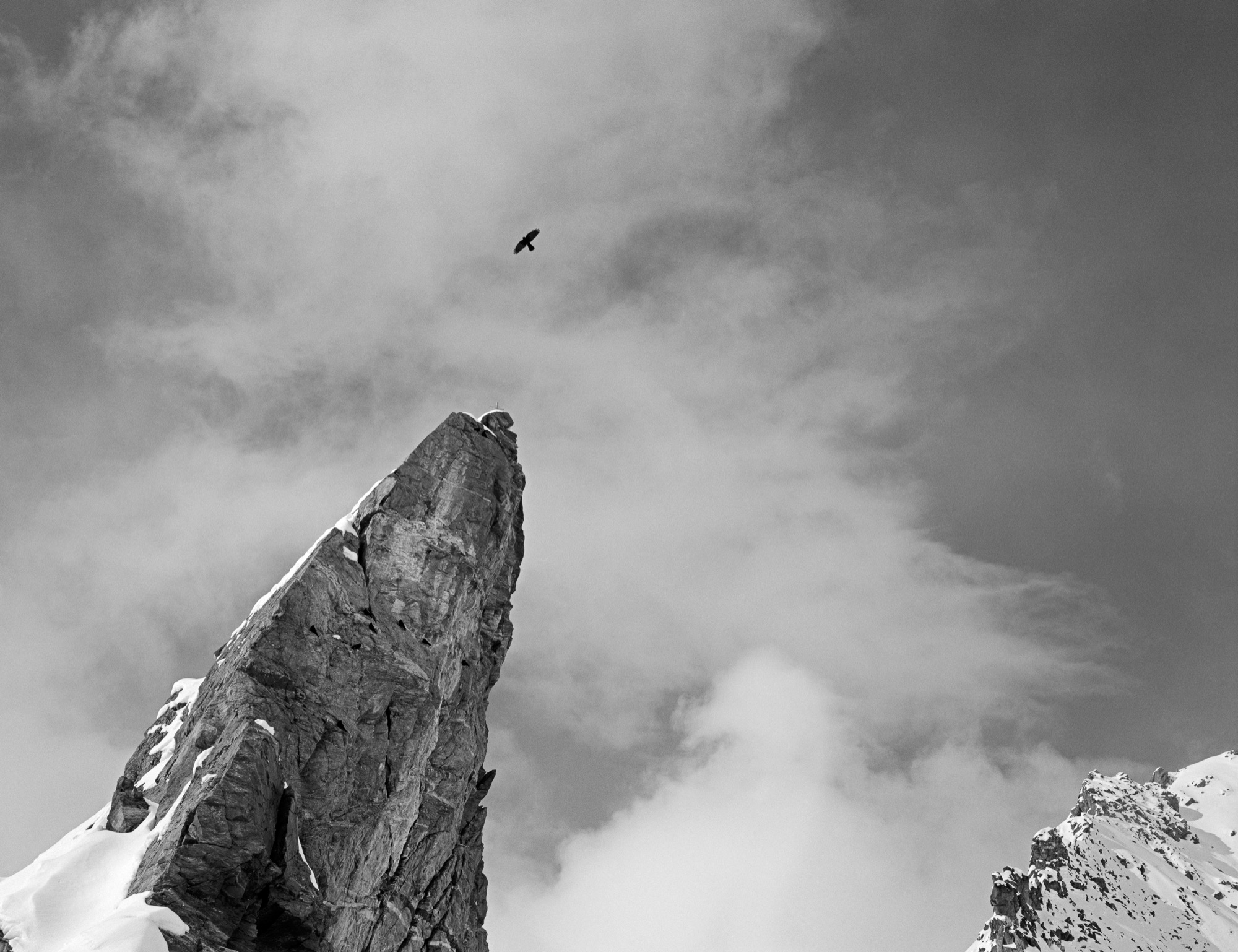
Once I’ve settled on an image, I take a deep breath and try to be as still as possible. High in the Swiss Alps, in the space between the breath and the click of the shutter, time slows to a stop.
"High in the Swiss Alps, in the space between the breath and the click of the shutter, time slows to a stop."
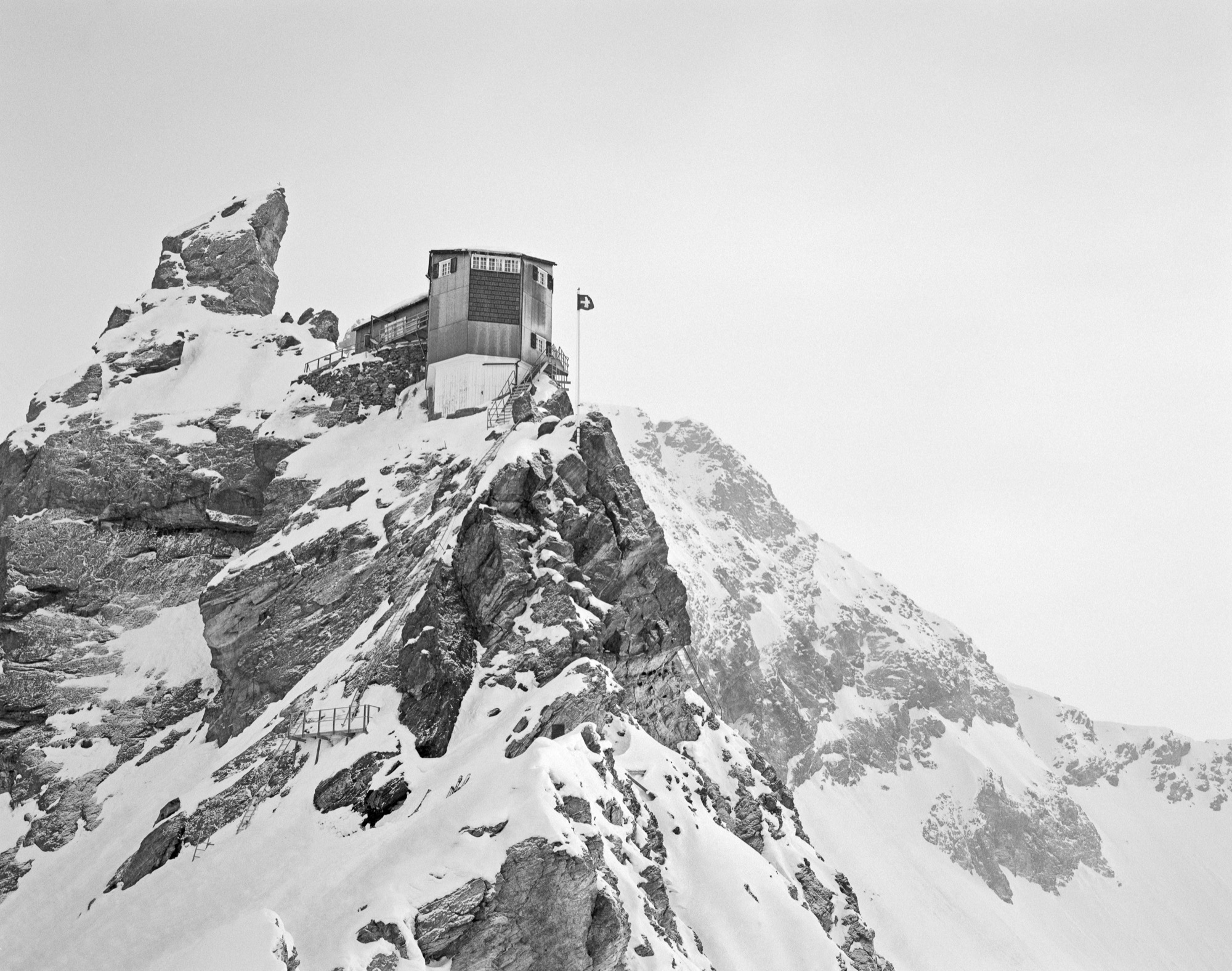
These images were made over the course of eight days, and selected from a total of 120 images, where just one exposure was allowed for each image. They have been minimally altered from their original form in order to stay true to the tonality of the film, and are the pure, unfiltered, timeless compositions that I’d been looking for. △
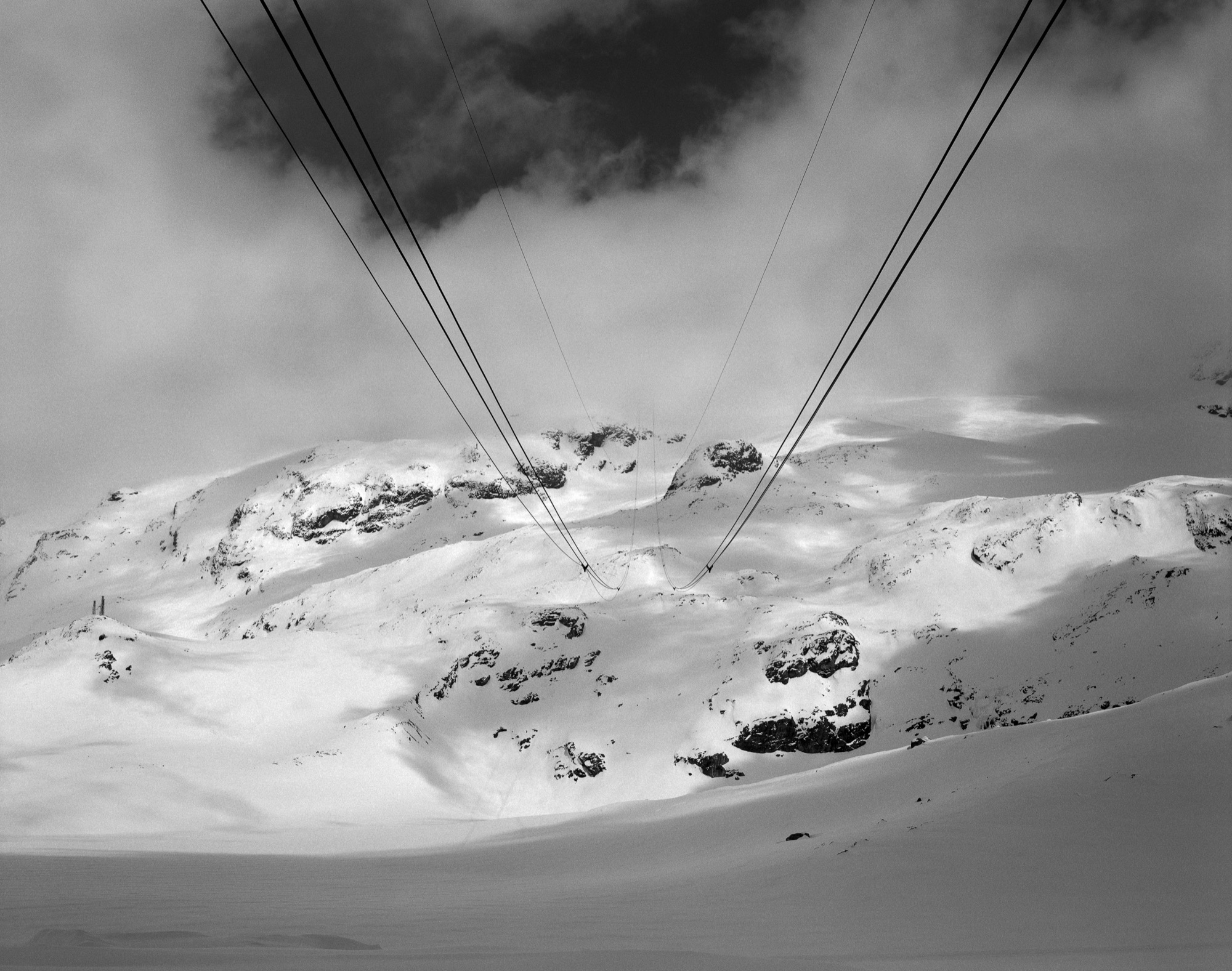
Fifteen and Focused on the World
Only fifteen years old, Joe Goldberg travels to explore the world through his camera lens. The photographer hopes his photos will inspire others to get out and see for themselves.
Upon returning from a life-changing trip to Costa Rica when he was only eleven years old, Joe Goldberg (joe_goldberg on Instagram) decided to spend his bar mitzvah money on his first camera. Now fifteen, the high schooler, who lives with his parents in Washington, D.C., expresses his teenage self through the art of photography.
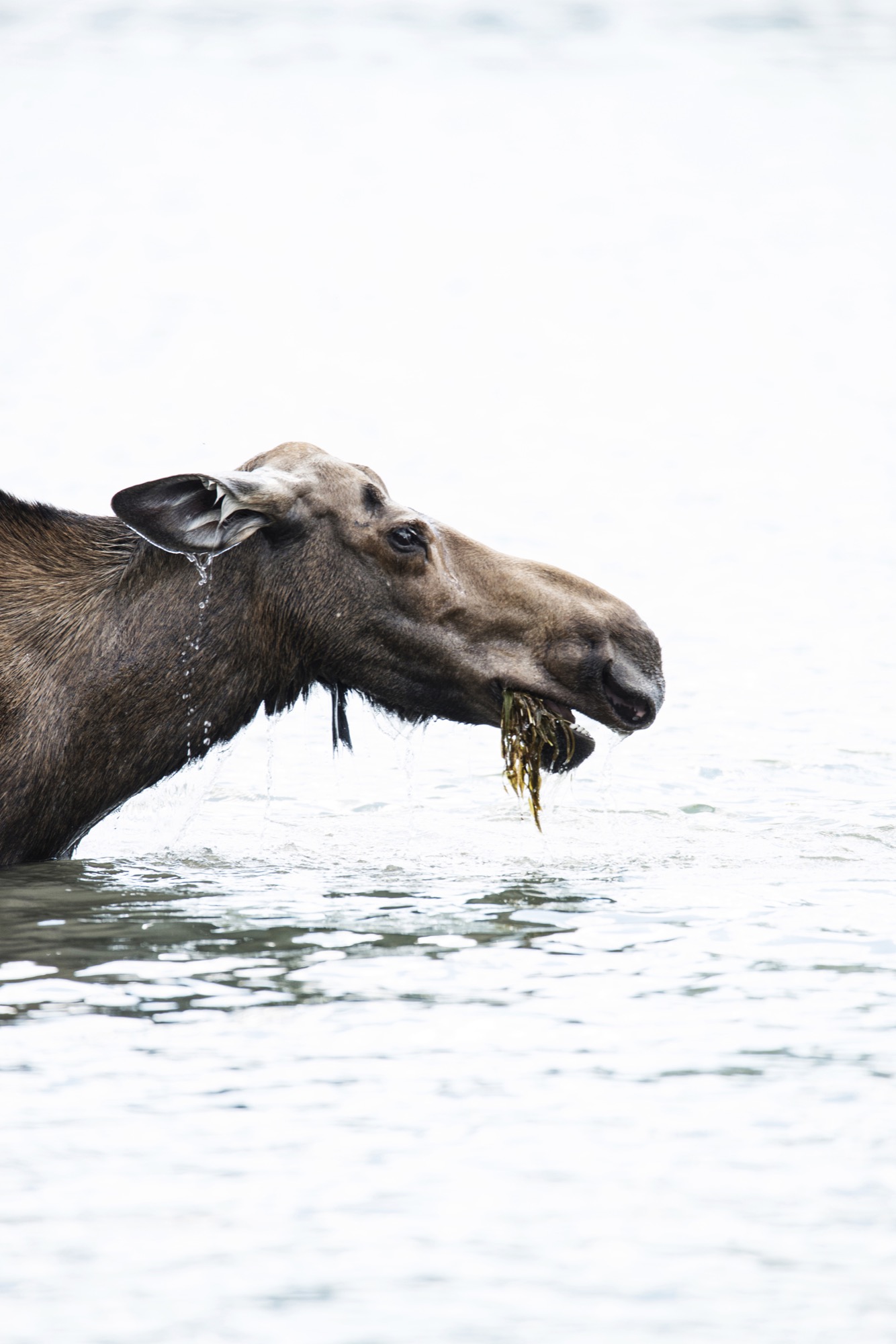
What’s more, the young adventurer wants to inspire others to travel and explore the world, too. At an age when his peers may search for their raison d'être on the Internet, this millennial gets out and uses photography to bring life into perspective.
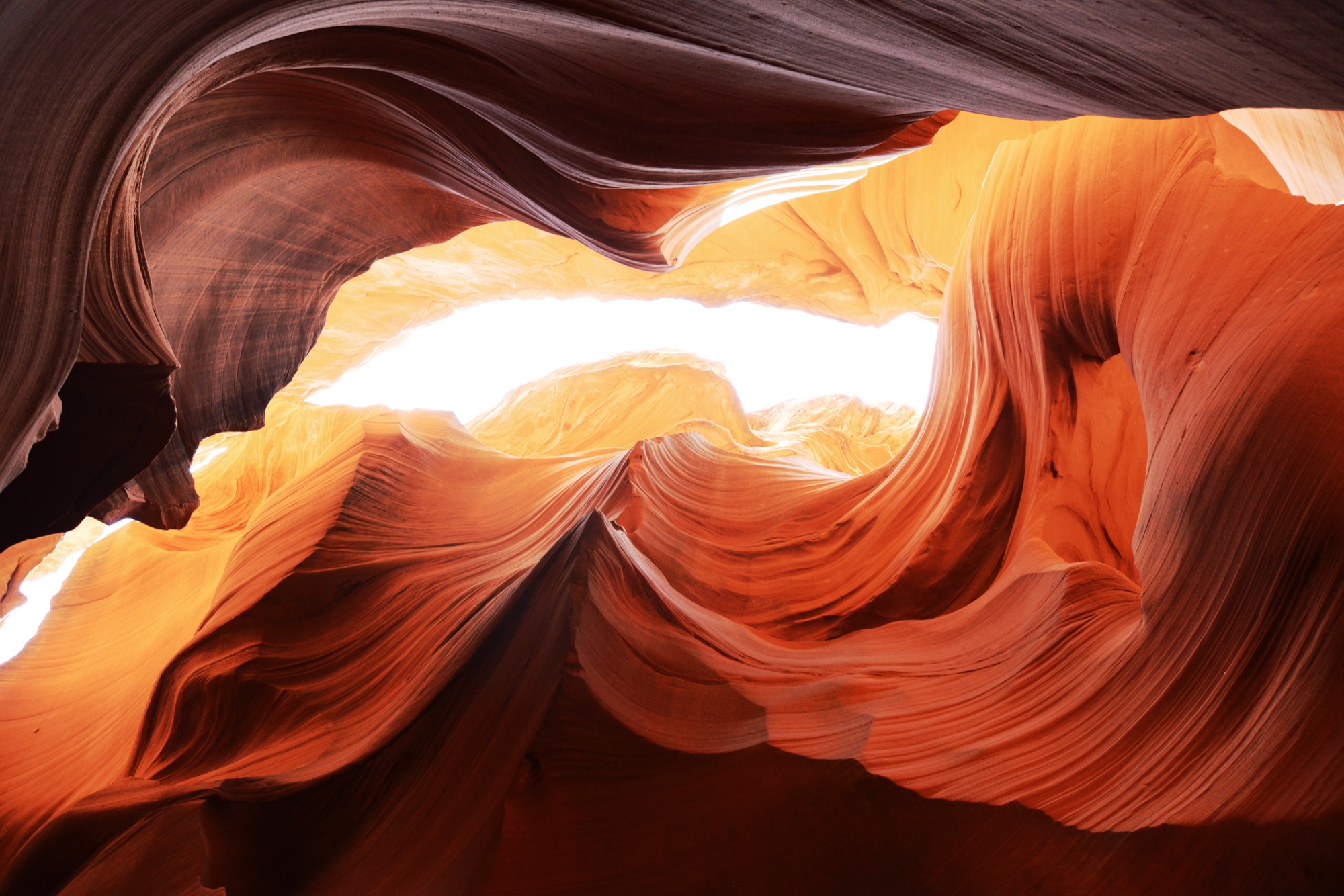
A conversation with teen photographer Joe Goldberg

AM Who are you in a nutshell?
JG I am a fun and energetic fifteen year old who loves to travel to the wildest places, take photos, and explore.
AM How did you find your way to photography?
JG I was eleven years old when I went to Costa Rica and really discovered some of the most natural beauty in the world. I then realized capturing memories with photography is a really cool thing. I realized how passionate I am about photography, so I decided to purchase a camera with the money I received after my bar mitzvah.
"I then realized capturing memories with photography is a really cool thing."
AM What does being fifteen mean for your creative work?
JG I think the role my young age plays in my creative work is having this constant urge as a young kid to travel and see things most people won’t be able to see in a lifetime.
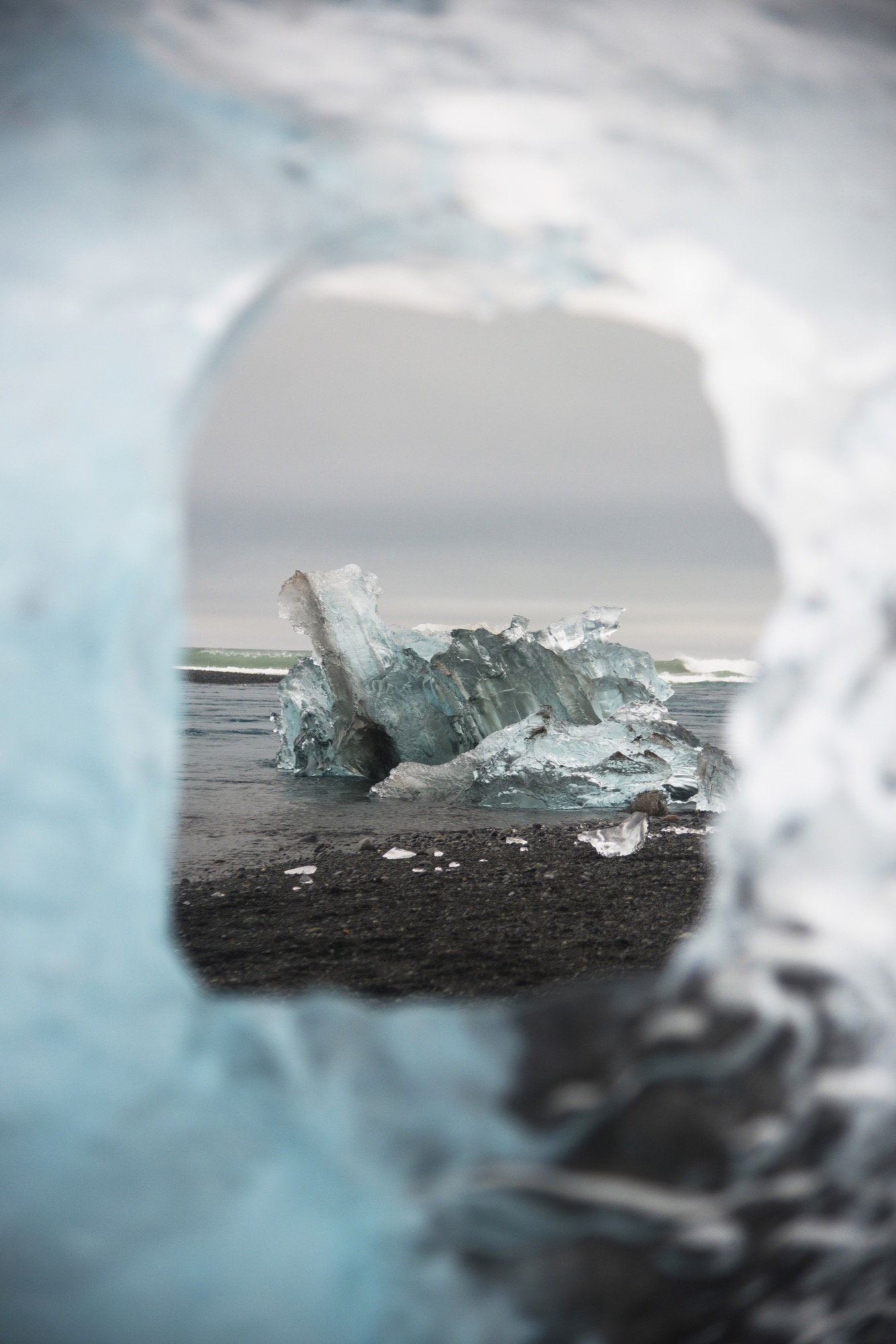
AM How do you balance school, teenage life, and your work as a pro photographer?
JG I attempt to get the best grades I can, so I can afford to miss a couple days of school here and there when I travel. I hang out with friends and family when I can. And when I get the chance to go out on an adventure, I will take the opportunity and then return to my normal, everyday life in Washington D.C.
AM What do the mountains mean to you?
JG The mountains play a big role in my photography. Probably, because I believe mountains make for the coolest photographs. My favorite activity also has to do with mountains, which is hiking. To see those insane views after a strenuous hike is one of the best feelings!
"I believe mountains make for the coolest photographs."

AM What inspires you in your work as photographer?
JG What inspires me is being able to share the beauty of the world with everyone. I love to capture memories and to look back on these incredible experiences I have been lucky enough to have. I love to hear how impressed people are with my work, which is a really big motivation to bring back the best work I can from these adventures I take. I also use my photos to try to encourage people to go out and explore.
AM What’s your favorite place in the world?
JG My favorite places I have been to have to be Iceland and Alberta. Alberta because the number of lakes and the abundant wildlife just blow my mind. You never know what to expect in the Canadian Rockies, and that is why I decided to go back over the summer after having gone during Spring Break. My other favorite place has to be Iceland. Every five minutes, you see a totally different landscape. I would love to return soon.

AM What’s most important to you in life?
JG The most important things in my life are my family and friends. However, being able to see the beauty in this world and pursue my dreams of being a the best professional photographer I can be is also something very important to me.
AM When are you the happiest?
JG I am the happiest when I am in nature, experiencing the amazing sights the world has to offer.
AM What are you up to next?
JG I just finished traveling to Iceland in October. Iceland is a place I wanted to go to for years now. The waterfalls, wildlife, volcanoes, glaciers, geysirs, unique landscapes, and the incredible Northern Lights are the reasons why it was on the top of my bucket list. △
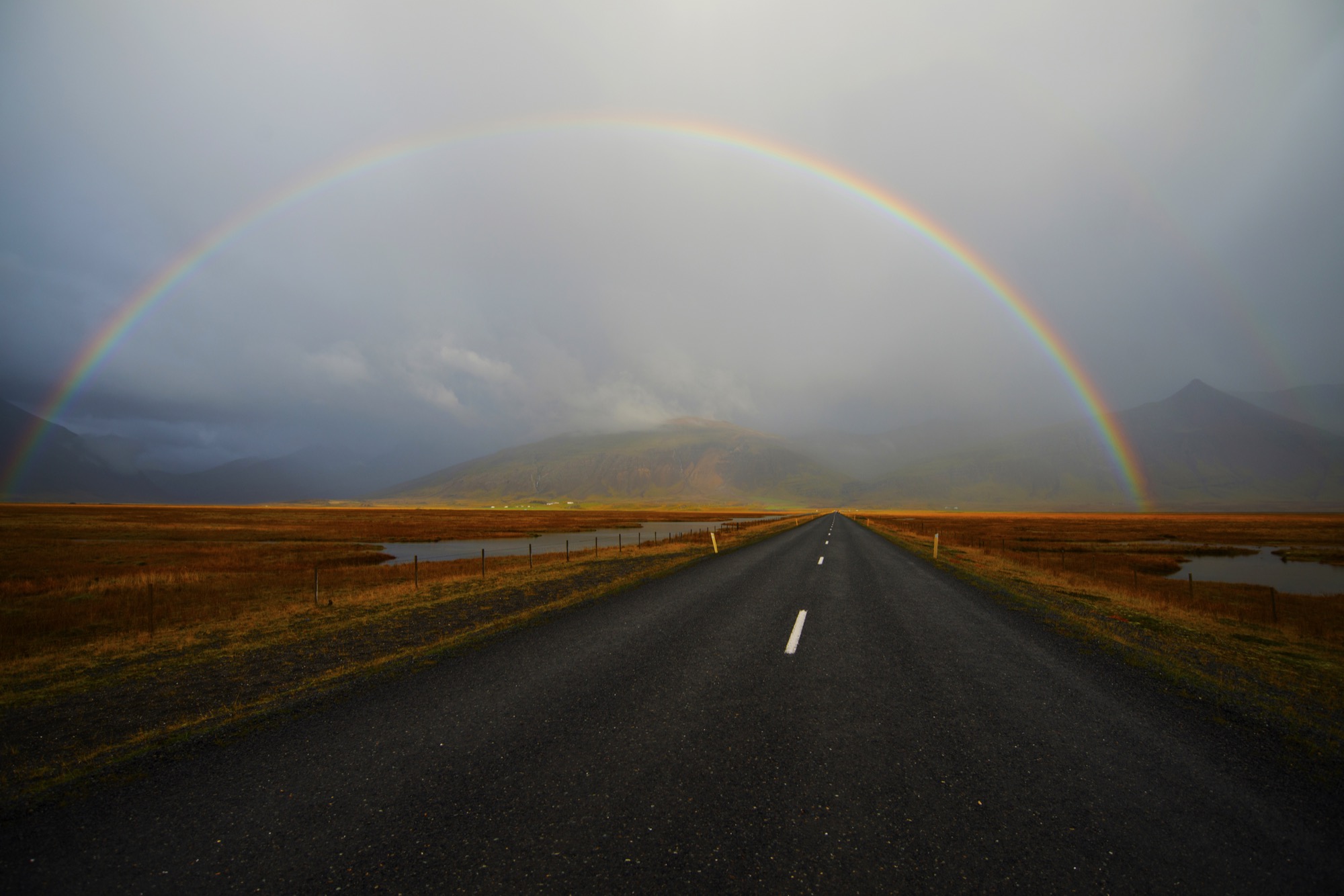
Monochromatic Reminiscion
Belgian travel and wildlife photographer Martin Dellicour comes eye to eye with the history of Earth embodied in a herd of muskoxen on the high plateaus of Dovrefjell, Norway.
Belgian travel and wildlife photographer Martin Dellicour comes eye to eye with the history of Earth embodied in a herd of muskoxen on the high plateaus of Dovrefjell, Norway.
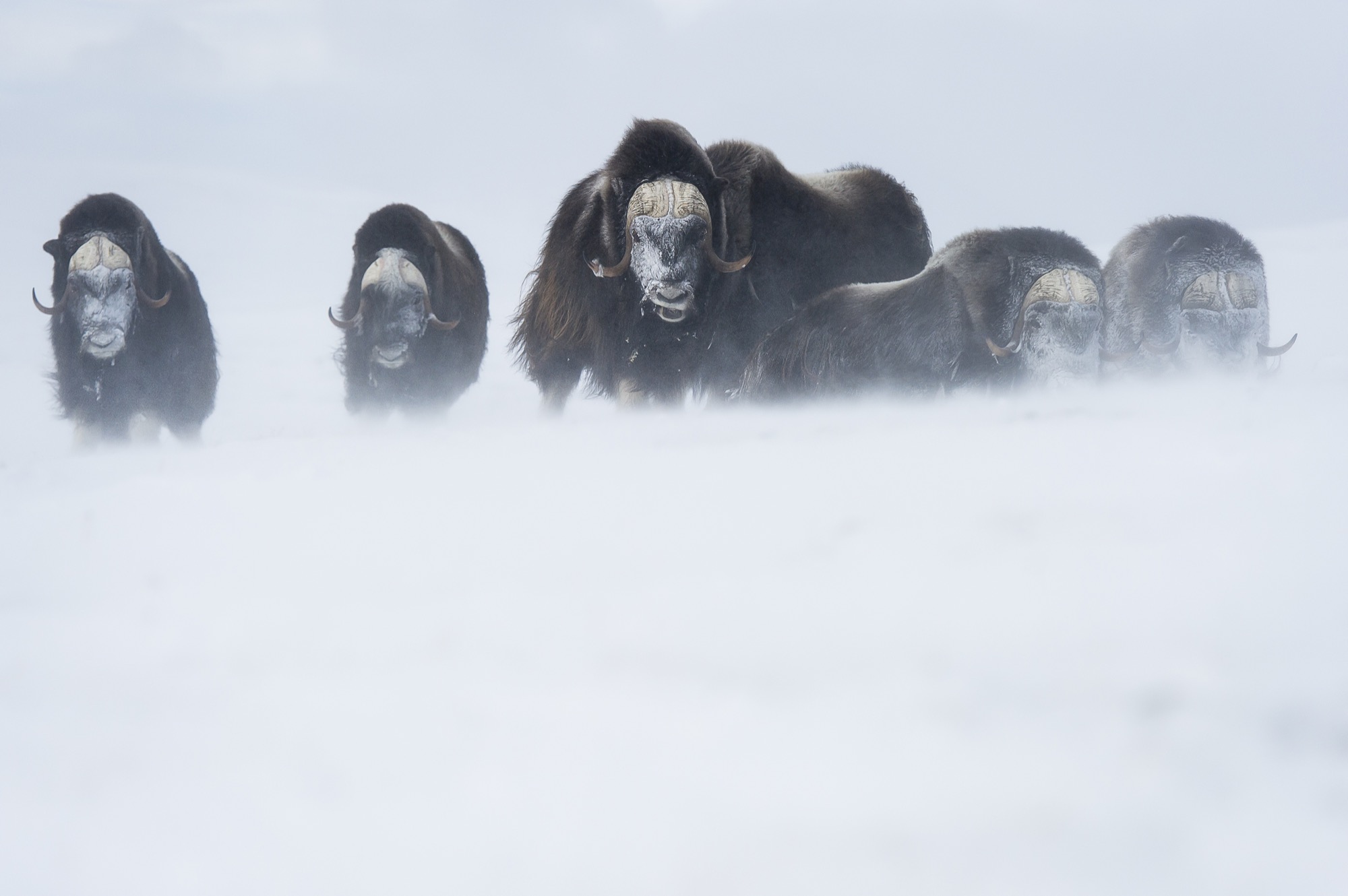
Growing up in Ardennes, Belgium, visual artist and photographer Martin Dellicour developed an appreciation for the aesthetics of nature early on. Dellicour remembers childhood as taking place outdoors, simply observing. At age fifteen, Dellicour’s parents gave him his first camera, a Nikon F–501, which he regards as “a revelation where the decision of being a photographer was secretly made.”
After studying at the school of art in Liège, Belgium, Dellicour worked independently, producing travel photography, graphic design, and videography. Four-teen years ago, he opened his own creative agency, Studio Breakfast, and later the graphic design atelier C'est Beau.
Pictured is Dellicour’s heedful dance with a herd of majestic muskoxen in Dovrefjell-Sunndalsfjella National Park, Norway—a winter landscape he describes as “an amazing and wild place.” The snow has a power of its own to Dellicour, one that can “change our perception to focus on the simple, essential things, and see the many questions of everyday futility.”
These muskoxen have a similar effect on Dellicour. “When you are in front of them, you feel like you’re facing the history of Earth. Out of time.” Paired with the white, minimalistic landscape, Dellicour demonstrates the transient experience of observation.
“When you are in front of them, you feel like you’re facing the history of Earth. Out of time.”
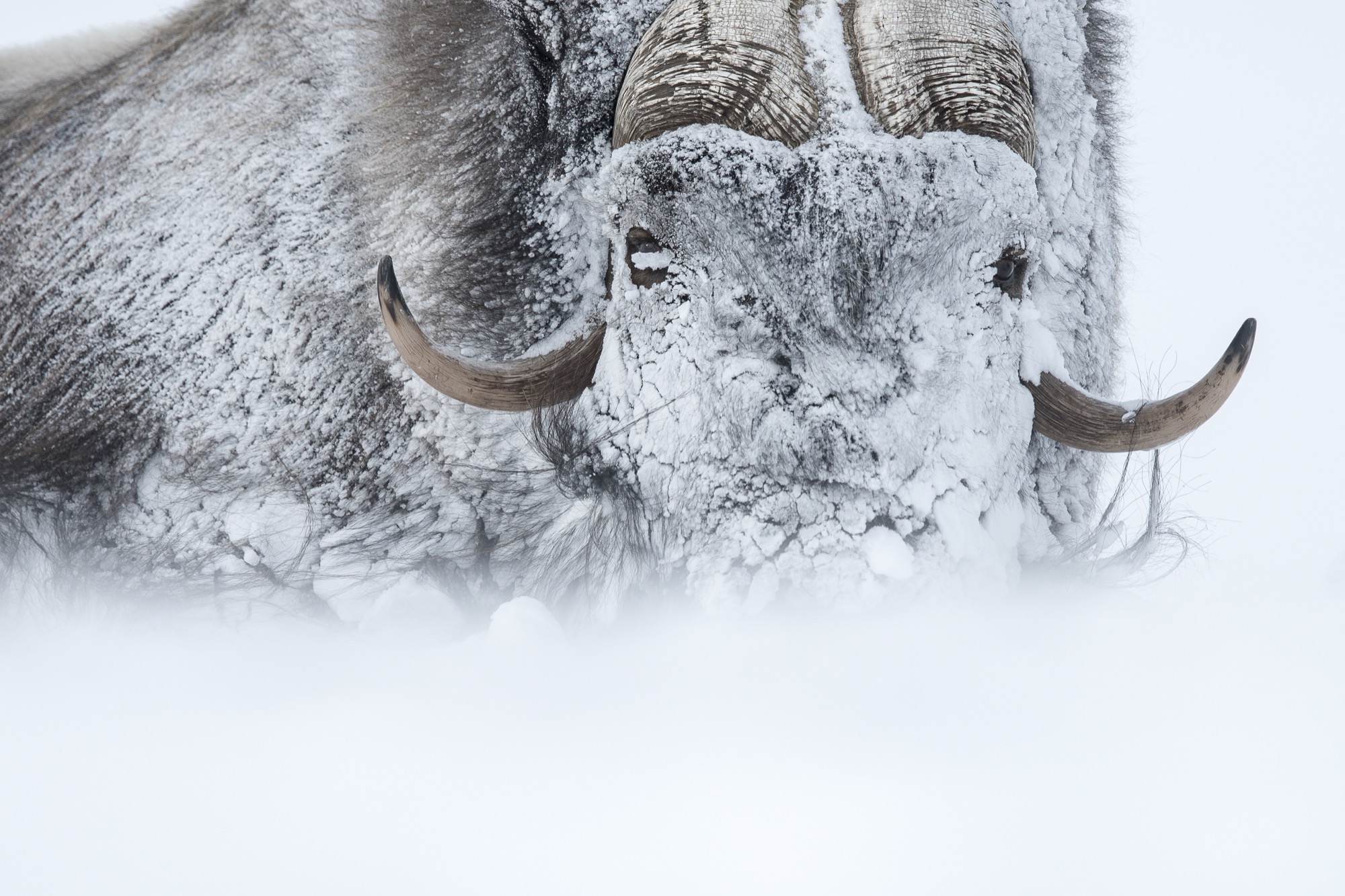
Dellicour desires to be close with nature, questioning the eyes and minds with which we observe. “It is an inner journey as much as an outdoor experience,” he says about his purpose in capturing natural settings.
“My main subjects are wildlife, nature, landscapes. But behind the subject, I am moreover fascinated by the light, the way light always surprises me in outdoor conditions.” Places visited hundreds of times appear different to the lensman every time. “Nature photography has this quality of keeping an element of unpredictability,” he says. “It’s exciting.”
“My main subjects are wildlife, nature, landscapes. But behind the subject, I am moreover fascinated by the light, the way light always surprises me in outdoor conditions.”
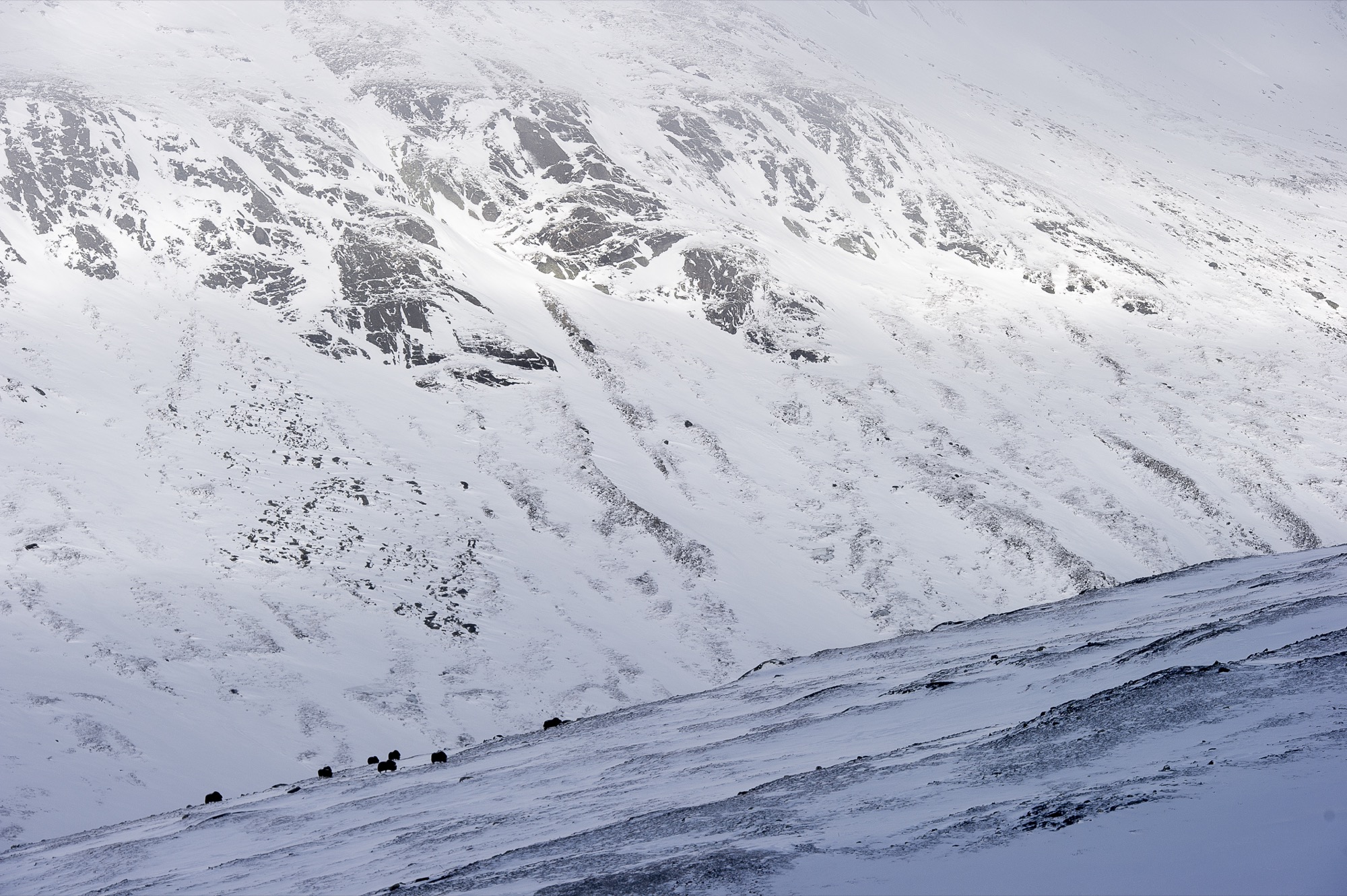
Monochromatic atmospheres characterize Dellicour’s artwork. “The subject is not always recognizable but more of a suggestion.” The indistinct interplay between the wild animals and the still landscape becomes the crux of his work, the essence of what makes him a unique artist. It’s the unpredictability and rawness that draws the viewer to question what visual experience we’re having and why.
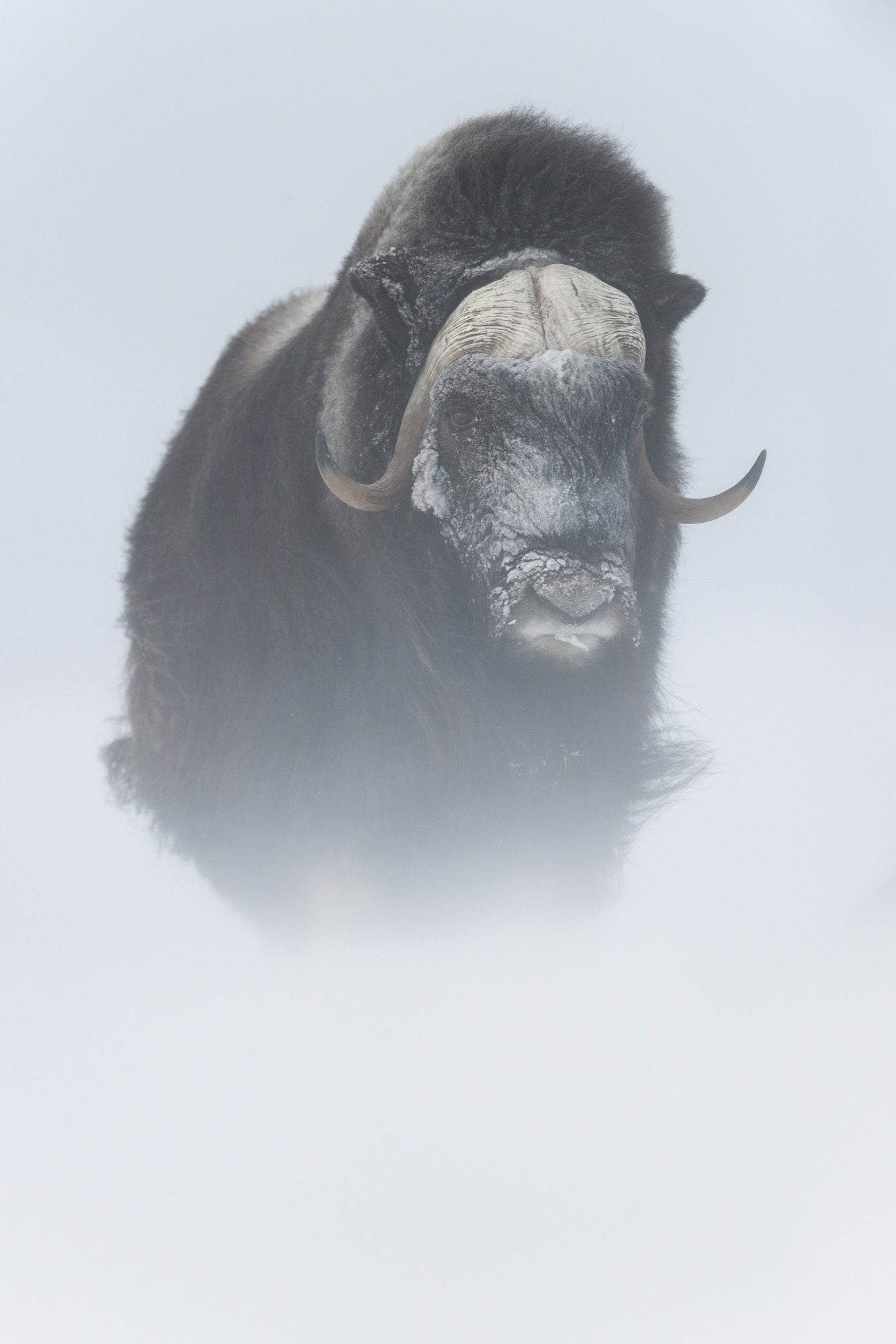
Dellicour evaluates his own work through the eyes of others. “It’s quite difficult to know if I’ve got talent or not,” he says. When he finishes one project, he’s off to the next in order to keep the creative mindset moving. Artwork then becomes a mode of transport between ideas, in hopes that others will be able to identify something inside of themselves that reacts to the visual aesthetic presented. In this way Dellicour main- tains freedom of expression, which allows viewers to write their own stories and empathize with his work.
His life, seemingly complex—ever engaging with a new subject in front of the lens, perpetually on the road—Dellicour nevertheless remains simple in lifestyle. “I try to get the best of all the little and big things that happen in my life”...walking in forests, making bread, sharing time with his wife and son. “Sometimes we can’t see the evidence,” he says, “we focus on the bad things or don’t even take the time to focus on anything.” So keeping an element of play is essential to Dellicour’s life, the balance of contemplating, creating, yet liberating via the visual arts. △
Airstream Dreams at AutoCamp Russian River
Wes Anderson meets the W Hotel at AutoCamp Russian River, where guests sleep in custom Airstream trailers and lounge at the midcentury-modern clubhouse
Nestled in the Russian River Valley, AutoCamp’s custom Airstream trailers and midcentury pavilion provide a boutique camping experience.
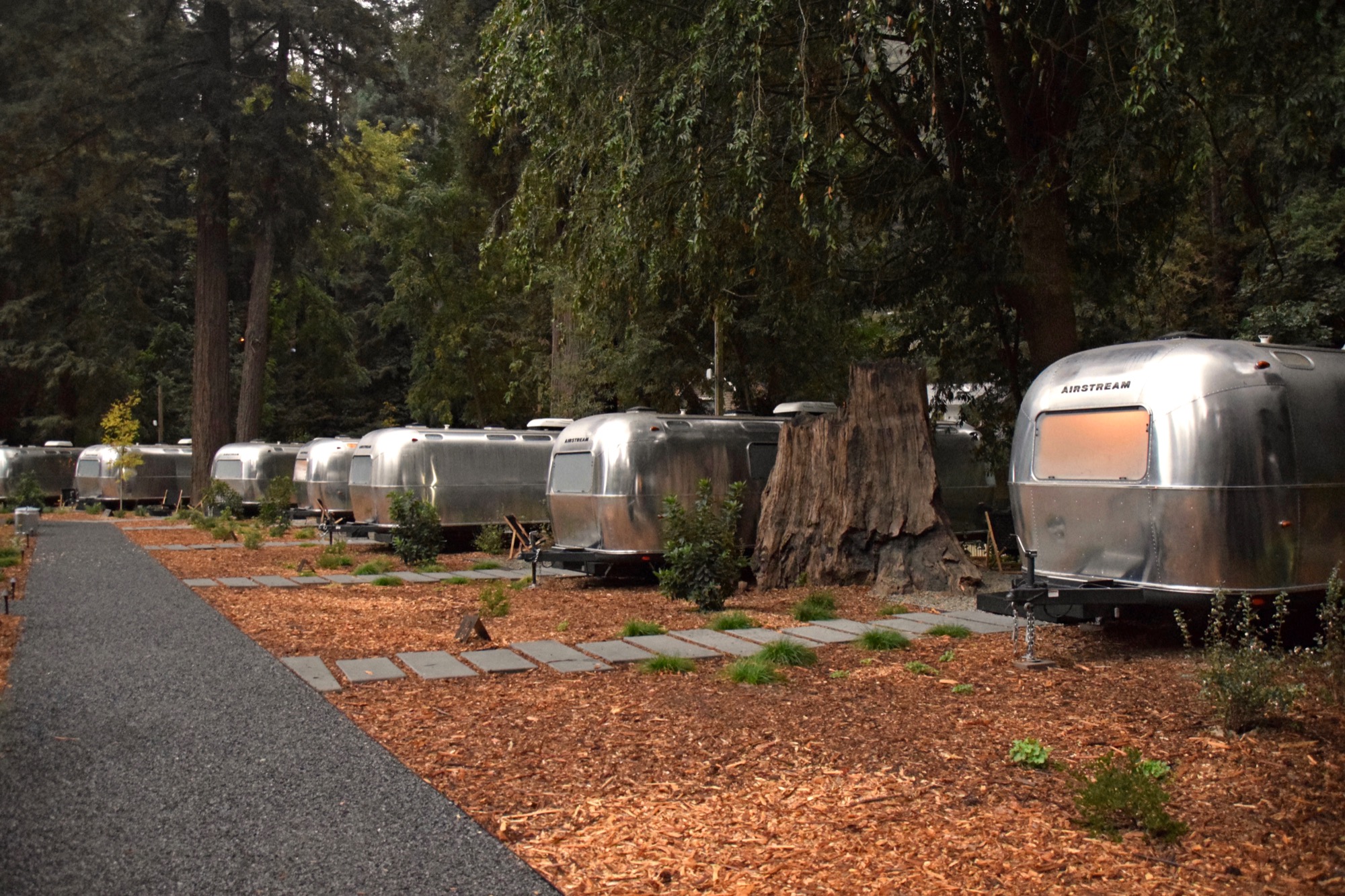
First established as a logging community in the late 1800s, the town of Guerneville, California, has grown to become an artist enclave, queer haven, and tourist destination. Seated in Sonoma County, Guerneville benefits from its proximity to wineries, redwood forests, beaches, and the bucolic Russian River, which winds along the 101. It has also been riding a new wave of revitalizations, most recently manifest in the opening of AutoCamp’s second location at the end of the town’s main strip. A cross between boutique hotel and campsite, AutoCamp Russian River is known for its Airstream accommodations, artfully furnished tents, and midcentury modern Clubhouse.
Over at Dwell.com, we had written about the Clubhouse before its opening and were eager to see the "glampsite" for ourselves, so we packed our bags for a weekend trip. What we discovered there is equal parts design and adventure. Whatever the category of trip—family outing, Airstream appreciation, or corporate retreat—AutoCamp allows you to “rough it” in style.
"A cross between boutique hotel and campsite, AutoCamp Russian River is known for its Airstream accommodations, artfully furnished tents, and midcentury modern Clubhouse."
The heart of the community
Turning off Old Cazadero Road into the parking lot of AutoCamp, we were greeted by the Clubhouse, a modernist structure designed by ANACAPA. It provides a sense of arrival and sets the tone for the experience. It also stands as metaphor for the continued renewal of Guerneville, since it sits on the very site of the clubhouse belonging to Spooner’s Resort, an ill-managed, unsavory RV park that was previously on the property.
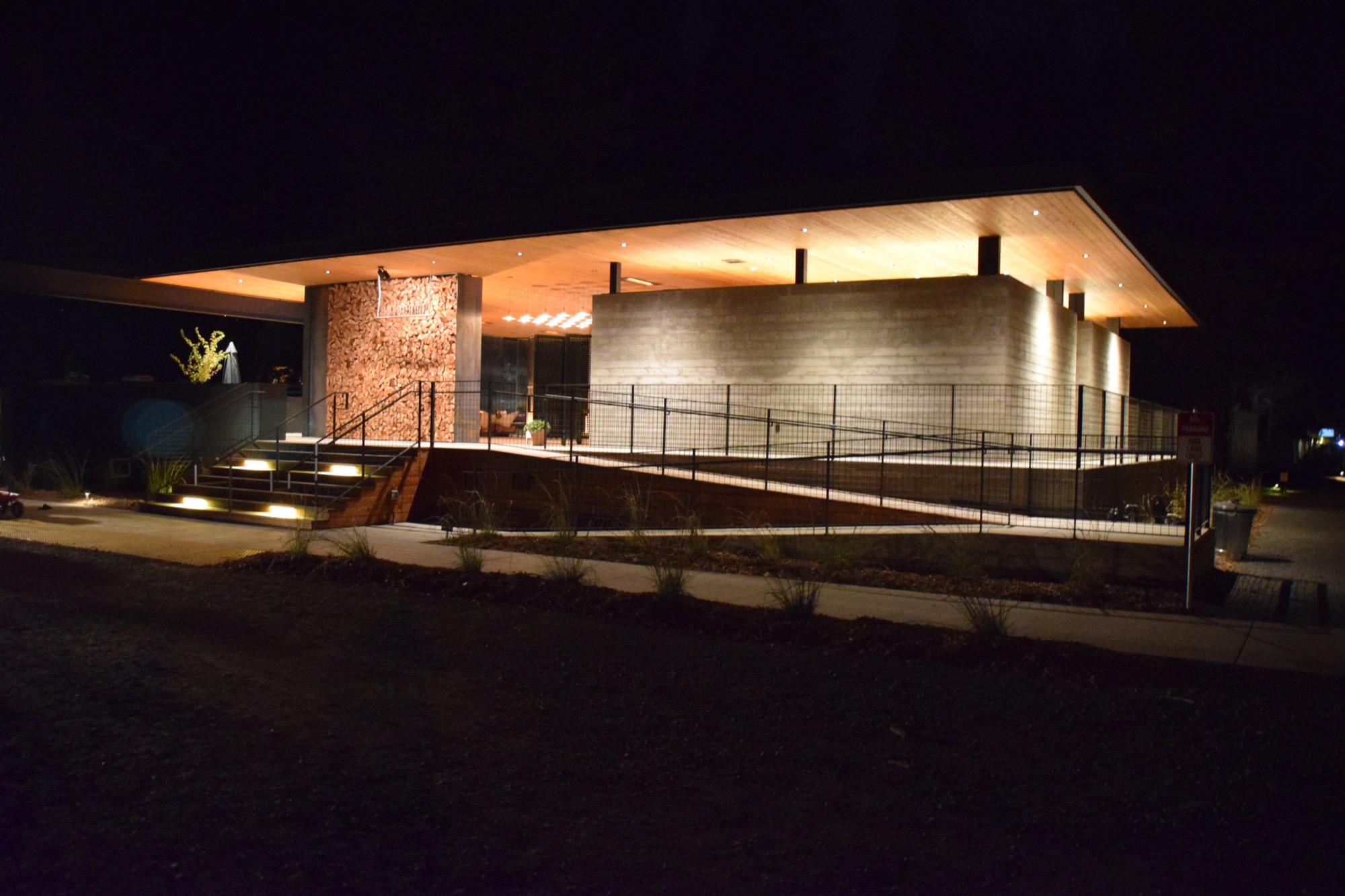
For the 3,000-square-foot structure, Dan Weber drew inspiration from midcentury masterpieces like the Barcelona Pavilion by Mies van der Rohe and the Kauffman House by Richard Neutra. The pronounced horizontal planes of the Clubhouse are a launchpad for the soaring verticality of the surrounding forest. Its robust material palette of board-formed concrete, locally harvested redwood, and blackened steel not only speaks to the natural setting, but also acts as safeguard against the periodic flooding that occurs in the area.
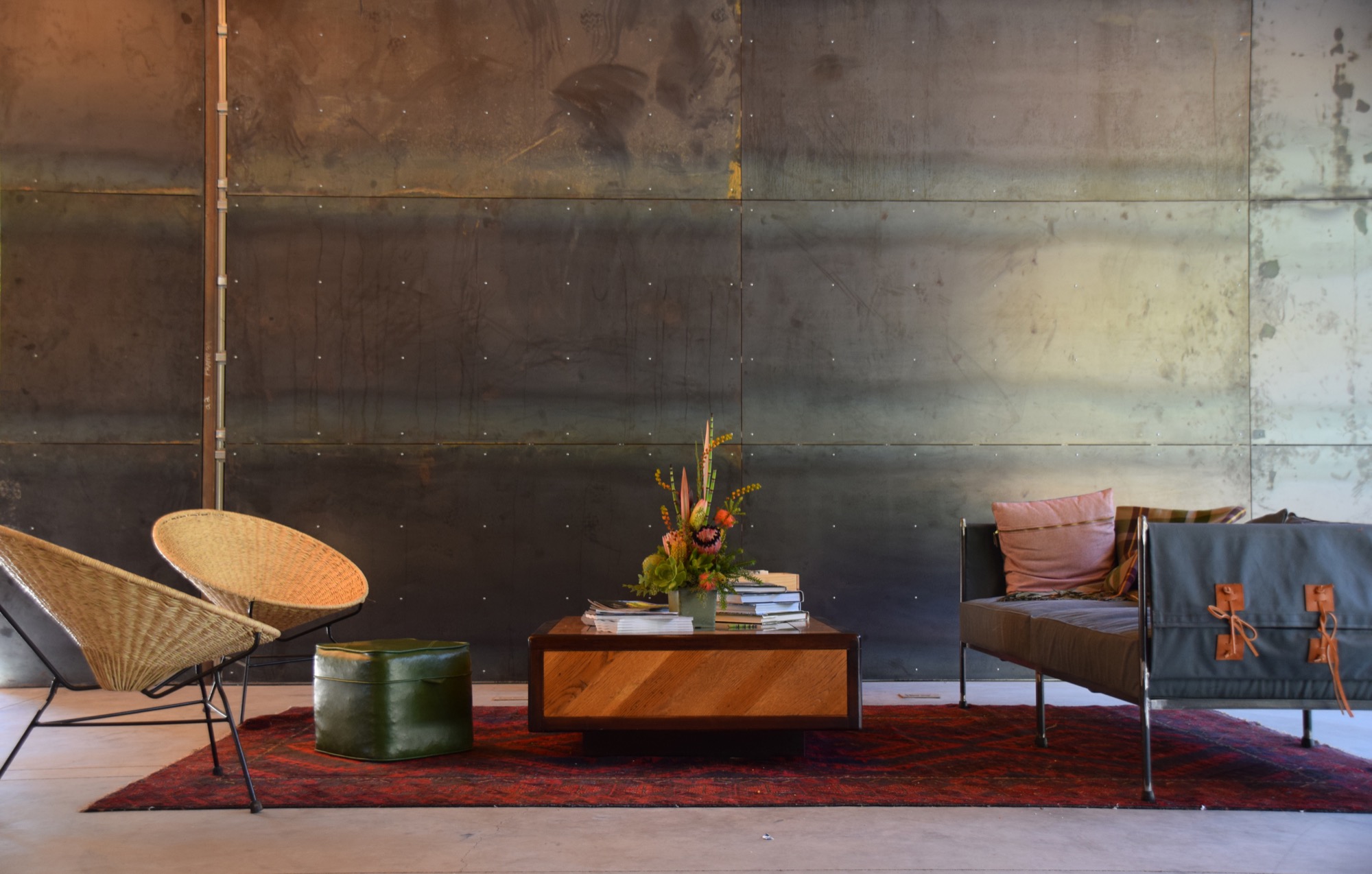
The Clubhouse evoked a persistent sense of homecoming as we jetted to and from camp. For guests, it is the reception area and rallying point: a hanging fireplace and custom-designed furniture by Alexis Moran invite you into their halo of warmth; on the north side, an outdoor fire pit offers views of the meadow and the glinting Airstreams that encircle it. There’s a lounge section stocked with books and magazines, an ideal spot for enjoying a cup of joe from the coffee bar—and for those staying in canvas tents, the Clubhouse provides luxurious bathrooms and showers. With so much traffic, the Clubhouse is the true heart of the community, a place to decompress, play a game of dominoes, and meet and swap stories with fellow travelers.
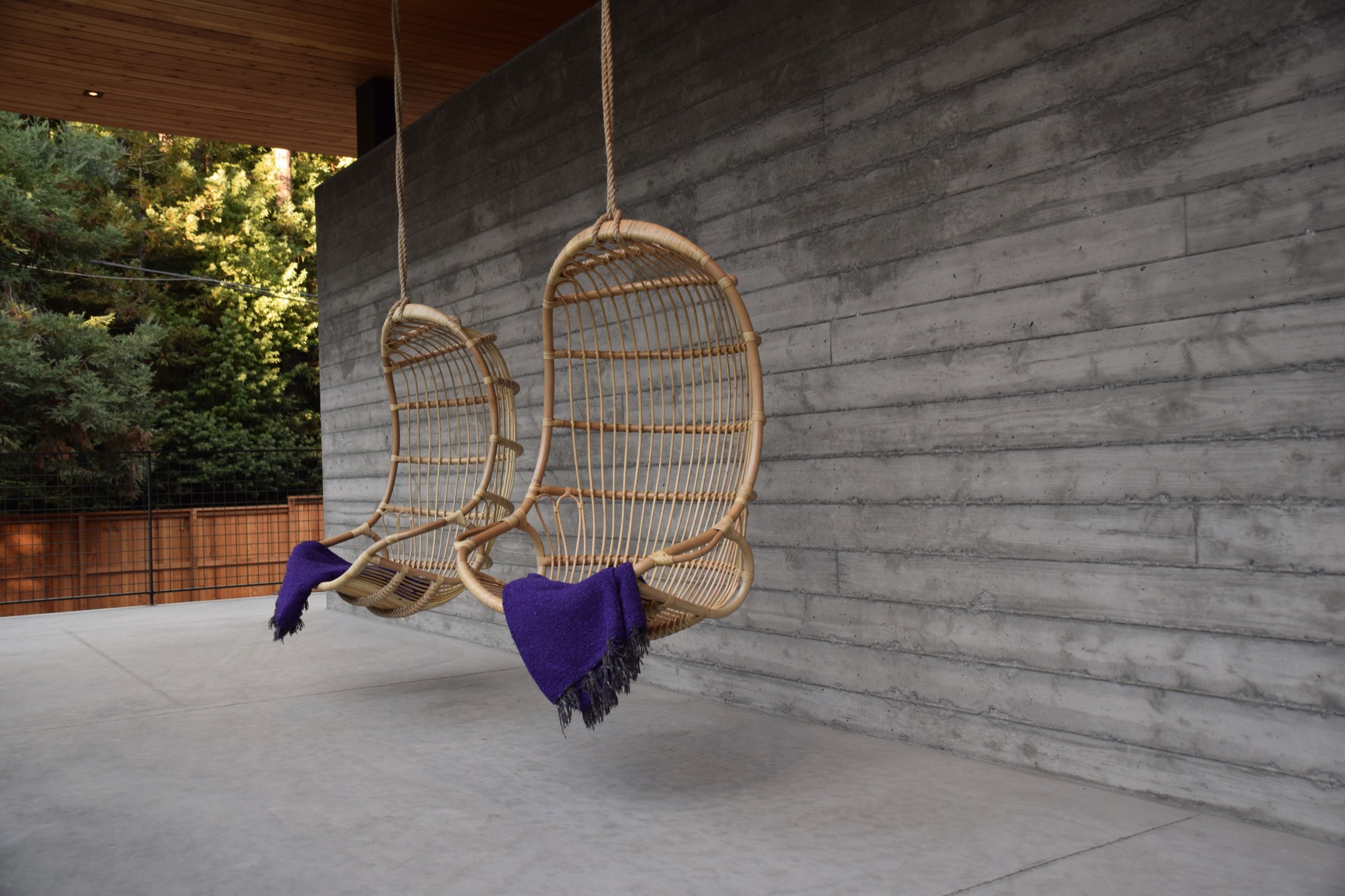
Ryan Miller, co-founder of AutoCamp, is excited about putting down roots in Guerneville. Originally from southern California and now a Bay Area resident, Miller had been driving up the coast on a road trip when he came across the town. Immediately, he knew it was something special. “It’s the tightest community,” he said. “You get the sense that something is peaking.”
The AutoCamp experience is always evolving, and there’s room for the community presence to grow even stronger. Future programming like yoga classes, ecology talks, movie screenings, kids’ activities, and maker workshops will revolve around the Clubhouse. Already, it has hosted a pop-up event with local entrepreneur and restaurateur Crista Luedtke—whom many credit for Guerneville’s transformation—serving dinner, and Phoebe Dahl of ethical clothing line Faircloth Supply Co taking over the Canteen, the Clubhouse’s general store.
Setting Up Camp
By day, the 23 Airstreams on the grounds have a striking effect, their silver bodies giving off a pearlescent glow; by night, their windows gleam in the darkness. Whether you’ve been a longtime fan of this American icon or just discovering the classic camper, staying in a custom-designed Airstream is a rare experience. Thanks to the vision of architect Dan Weber and interior designer Lauren Geremia, the accommodations strike a balance between rustic and modern, emphasizing comfort without losing their connection to the outdoor setting.
“She had a good feel for the culture,” said Miller of Geremia. “It was cool to work with someone who could facilitate so many creatives coming together.” From sourcing artwork to recruiting furniture makers like the aforementioned Moran, Geremia helped realize the warm, folksy vibe that pervades AutoCamp. We were taken with every detail: pendant lights by Schoolhouse Electric hang on either side of an indulgent Casper mattress, and vintage Observer’s books provide a bit of bedside reading. The homespun touches complement luxe elements like the marble tiles lining the bathroom and the crisp walnut cabinetry.
"Whether you’ve been a longtime fan of this American icon or just discovering the classic camper, staying in a custom-designed Airstream is a rare experience."
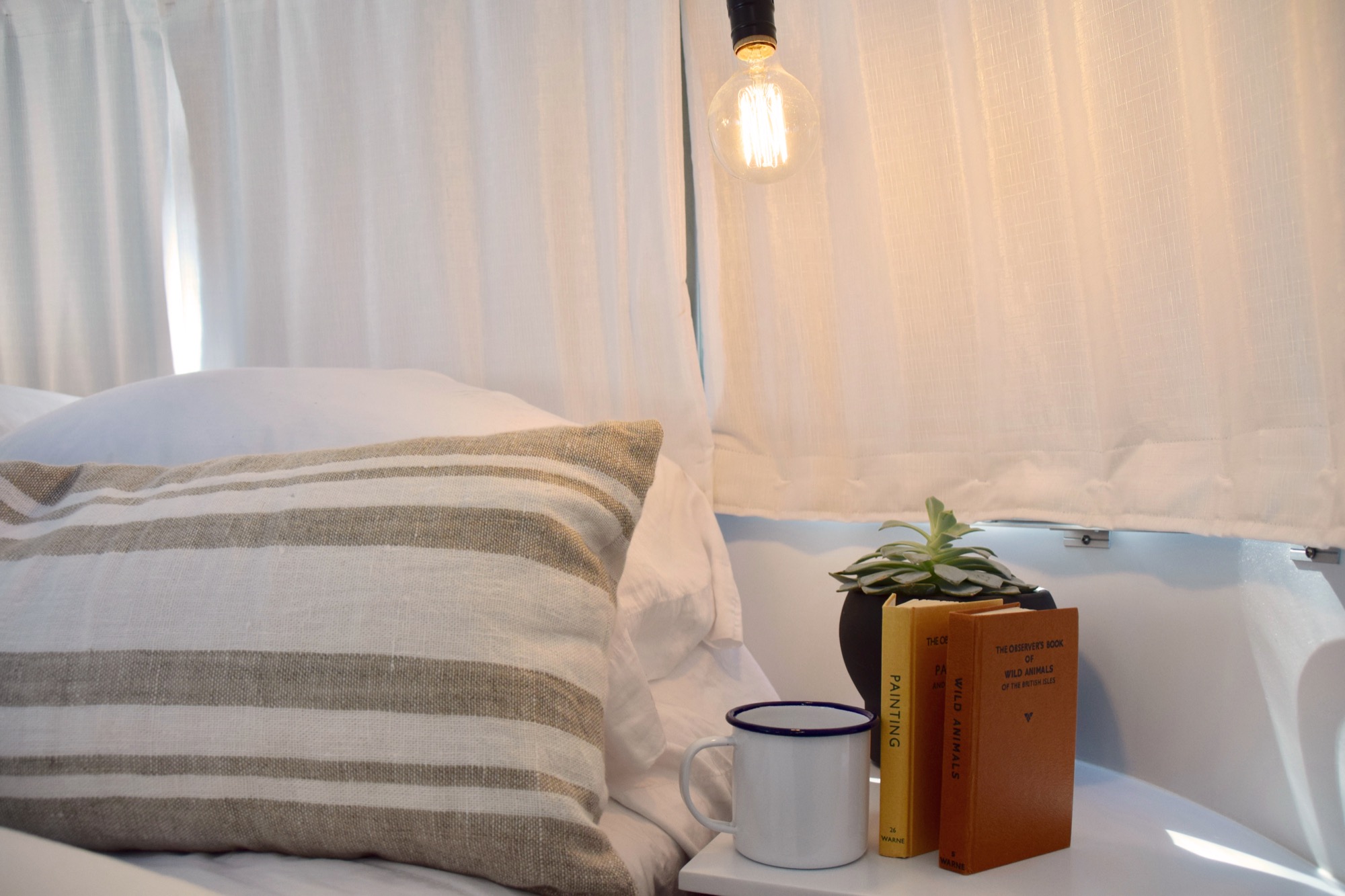
For those who prefer to hibernate at home base—or just want to relax after a day of traipsing through the woods—the Airstream is equipped with a wall-mounted flat screen TV and a Bluetooth sound system. A thoughtfully stocked kitchen and a private deck area allow you to brew coffee or fry eggs and bacon in the morning. And no campsite would be complete without a fire pit, the perfect stage for roasting s’mores (psst—if you forgot to grab marshmallows at the store, the Canteen stocks grab-and-go S’mores Kits).
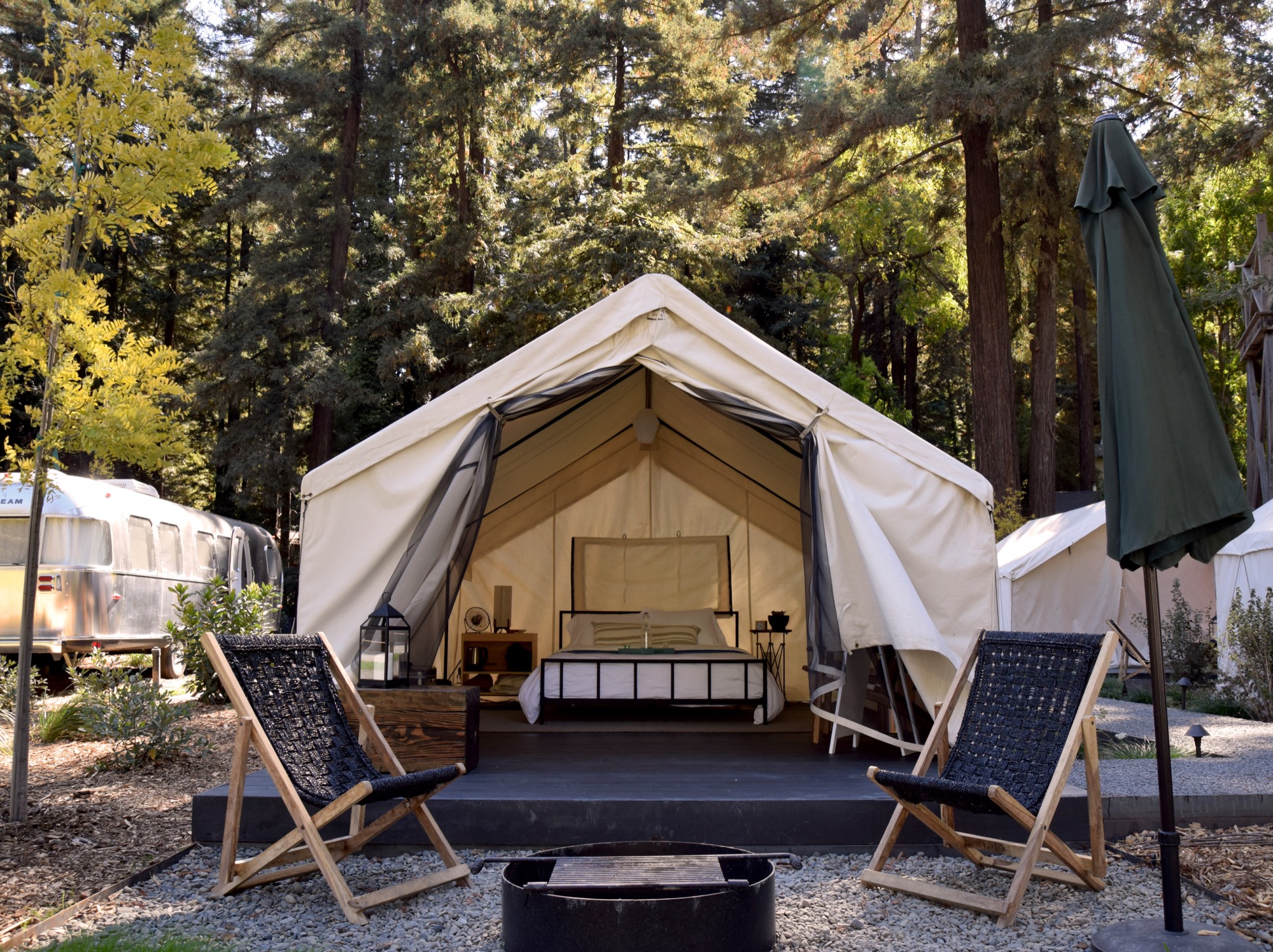
The 10 canvas tents on site, made by Wyoming-based Sheridan Tent & Awning, harken back to Guerneville’s heritage as a logging town. Geremia’s stylings—think Wes Anderson meets the W Hotel—create a cozy-chic atmosphere that caters to families, friends, and romantic couples alike. AutoCamp originally had a funky, vintage style, but over time, says Miller, “We found ourselves in a clean, modern aesthetic and layering textiles.”
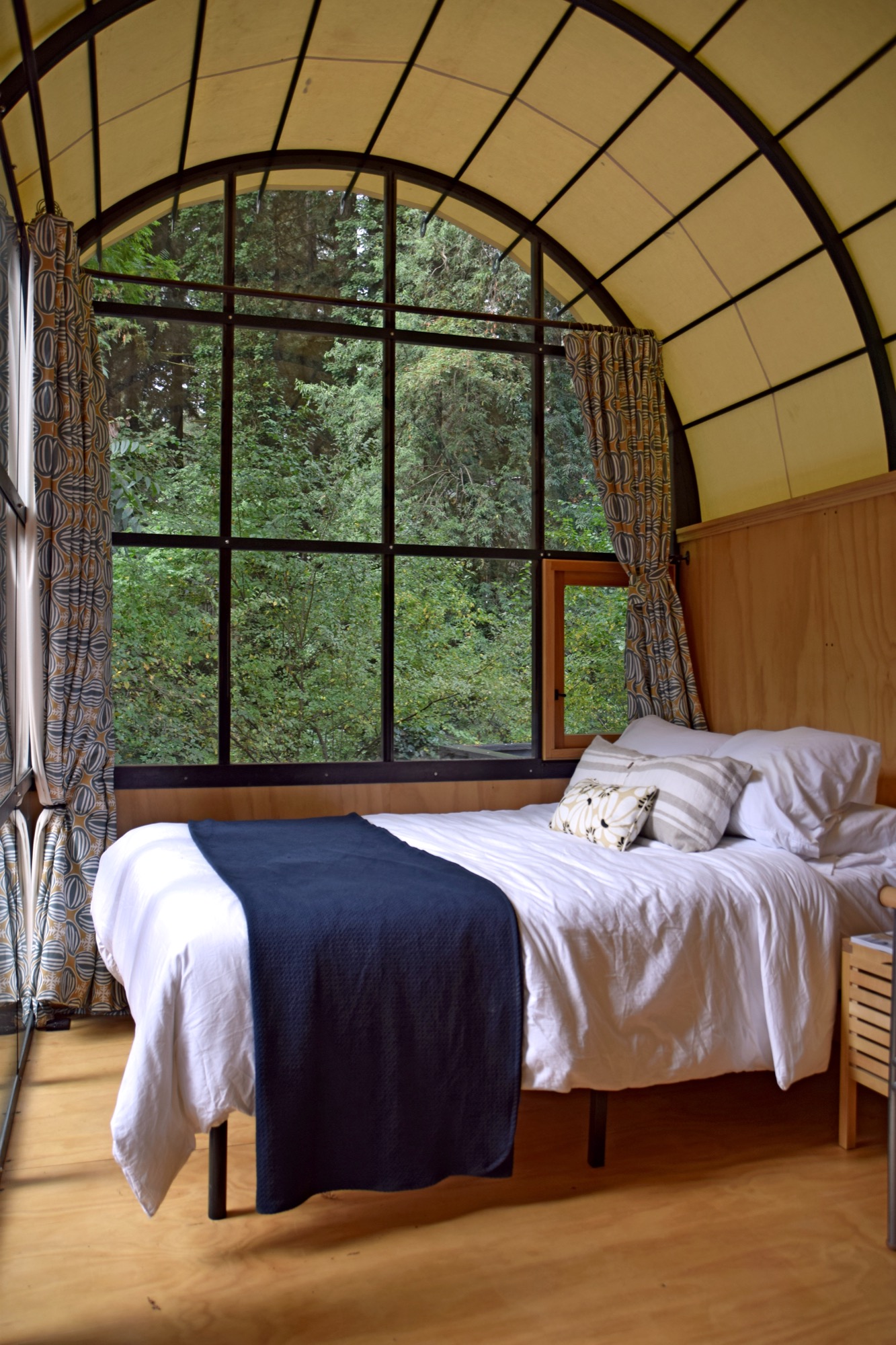
An accessible cabin built by Shelton Huts, run by Mattie Shelton and Evan Walbridge in Santa Barbara, rounds out the grounds. A steel structure wrapped in canvas with plywood floors and walls, the hut has a glass facade that offers a lush view of the banks of Hulbert Creek, which runs along the west side of camp. Custom fabric curtains designed by architect Jeff Shelton, Mattie’s father, provide shade and privacy.
"Think Wes Anderson meets the W Hotel."
Launchpad for Adventure
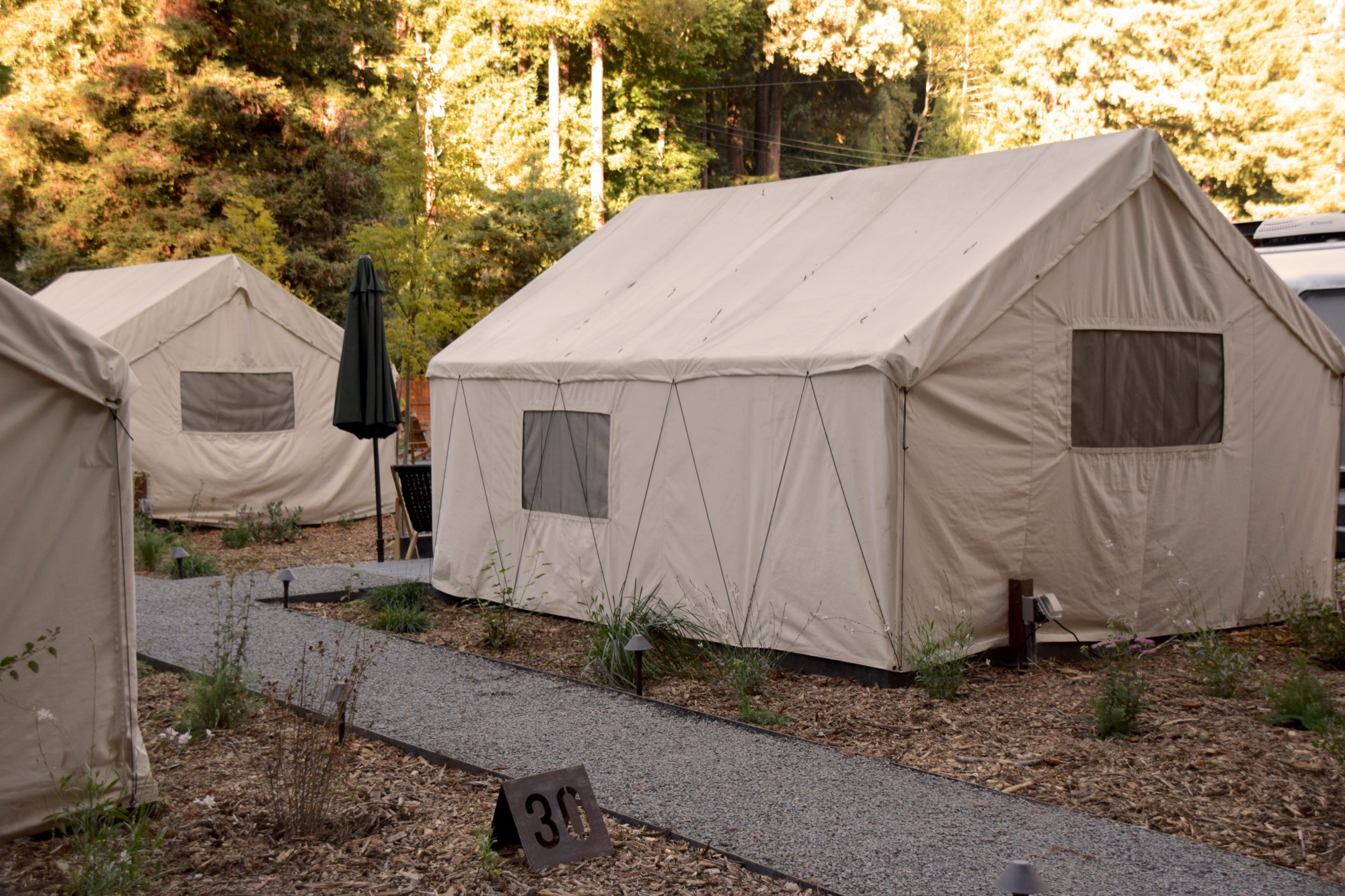
You won’t be at a loss for things to do at AutoCamp. Emerging from your Airstream or tent in the morning is an event in itself—bundled against the early chill, we helped ourselves to coffee in the Clubhouse and looked out at a meadow cloaked in fog. Linus bikes, helmets, and locks are available on a first-come, first-serve basis; on our journeys into town, we spotted several of these distinctive baby blue beach cruisers. You can check out beach towels and umbrellas to bring to the river or borrow a bocce ball set for a leisurely game on the green. An adjacent playground, basketball court, and tennis court, though not affiliated with AutoCamp, are easy to access as well.
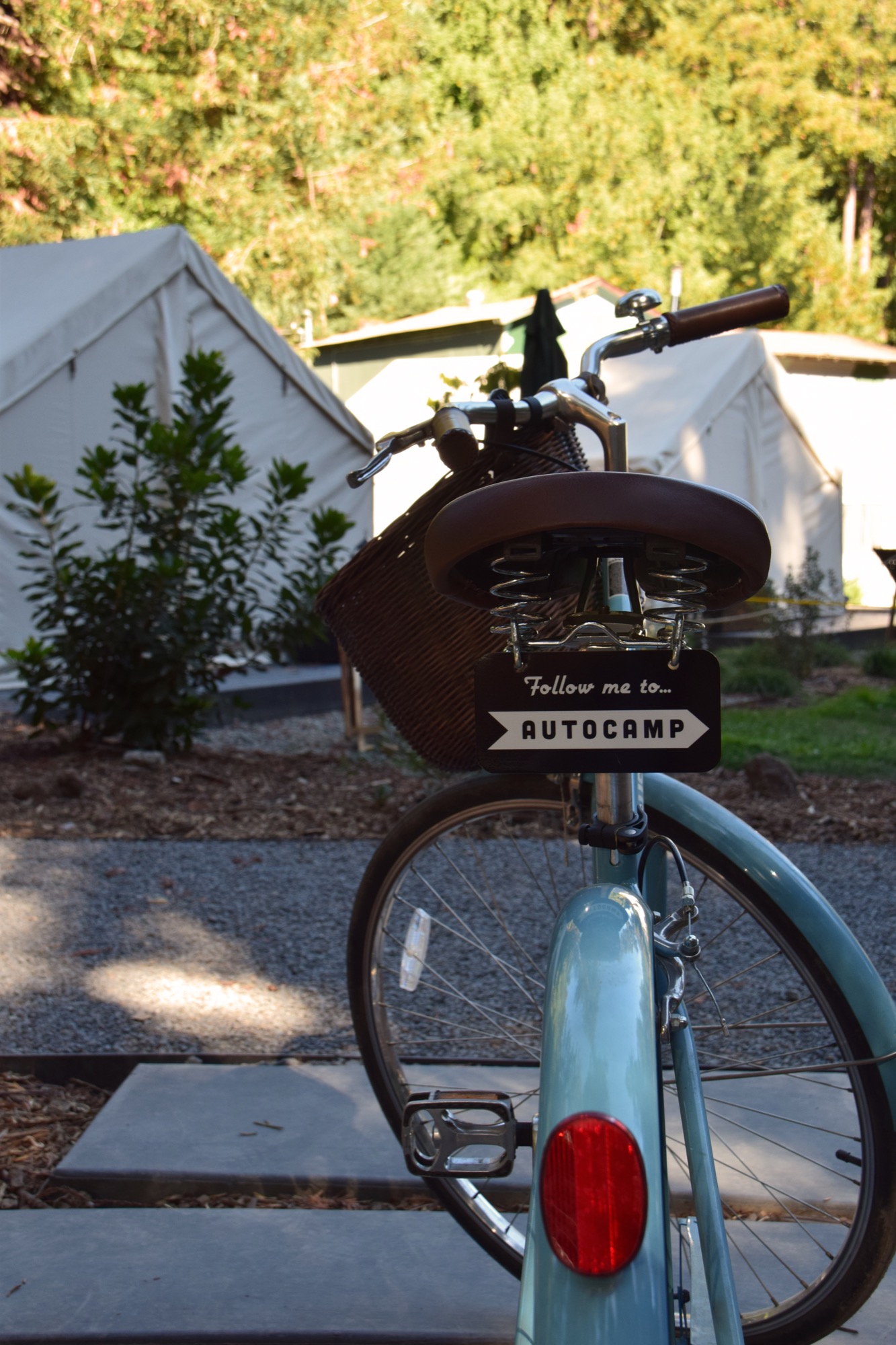
Where else you go is up to you. Describing AutoCamp, Miller said, “It’s a platform to jump off of. The best experience at AutoCamp is using it as a base camp for exploration.” From exploring the local scene to getting lost in nature, the Russian River Valley has much to offer—and AutoCamp puts it all at arm’s reach.
“It’s a platform to jump off of. The best experience at AutoCamp is using it as a base camp for exploration.”
Nightly rates for tent accommodations start at $139, while Airstream camping starts at $225. △
Monolith on the Mountain
In the Slovenian Alps, Bivak Pavla Kemperla sticks up for alpinists
Bivak Pavla Kemperla, a black beacon for mountaineers in the rugged landscape of the Slovenian Alps, was designed by Slovenian architect and alpinist Miha Kajzelj of the firm MODULAR arhitekti in Ljubljana, Slovenia.
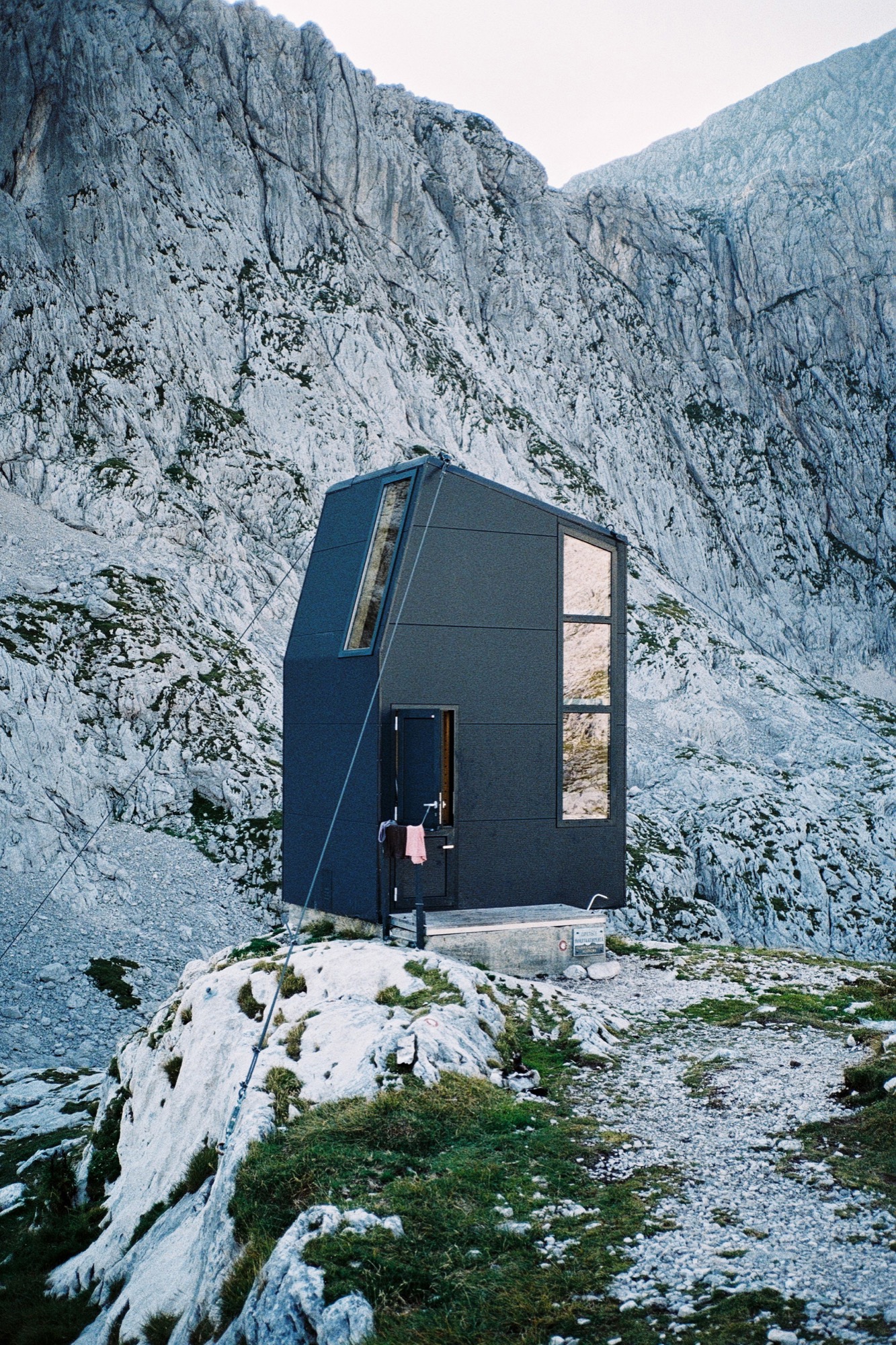
Situated at 2104 meters (6903 feet) above sea level in the Kamnik Alps north of Ljubljana, the bivouac under Grintovec was built in 2009 to replace an old shelter that stood there since 1973. The three-level structure is built on a concrete base. The long, vertical windows maximize the magnificent mountain views.
Its outer skin, made of aluminum isolating panels, is designed to prevent loss of the heat produced by the people inside. The inner skin is made of perforated wooden panels designed to wick body moisture out; so the interior always feels dry and warm. As a result of the vertical three-level concept, the upper sleeping level is warm, as the heat from below rises up.
The tiny, simple volume—2 × 3 × 4.5 meters (6.6 x 9.8 x 14.8 feet)—sleeps eight people.
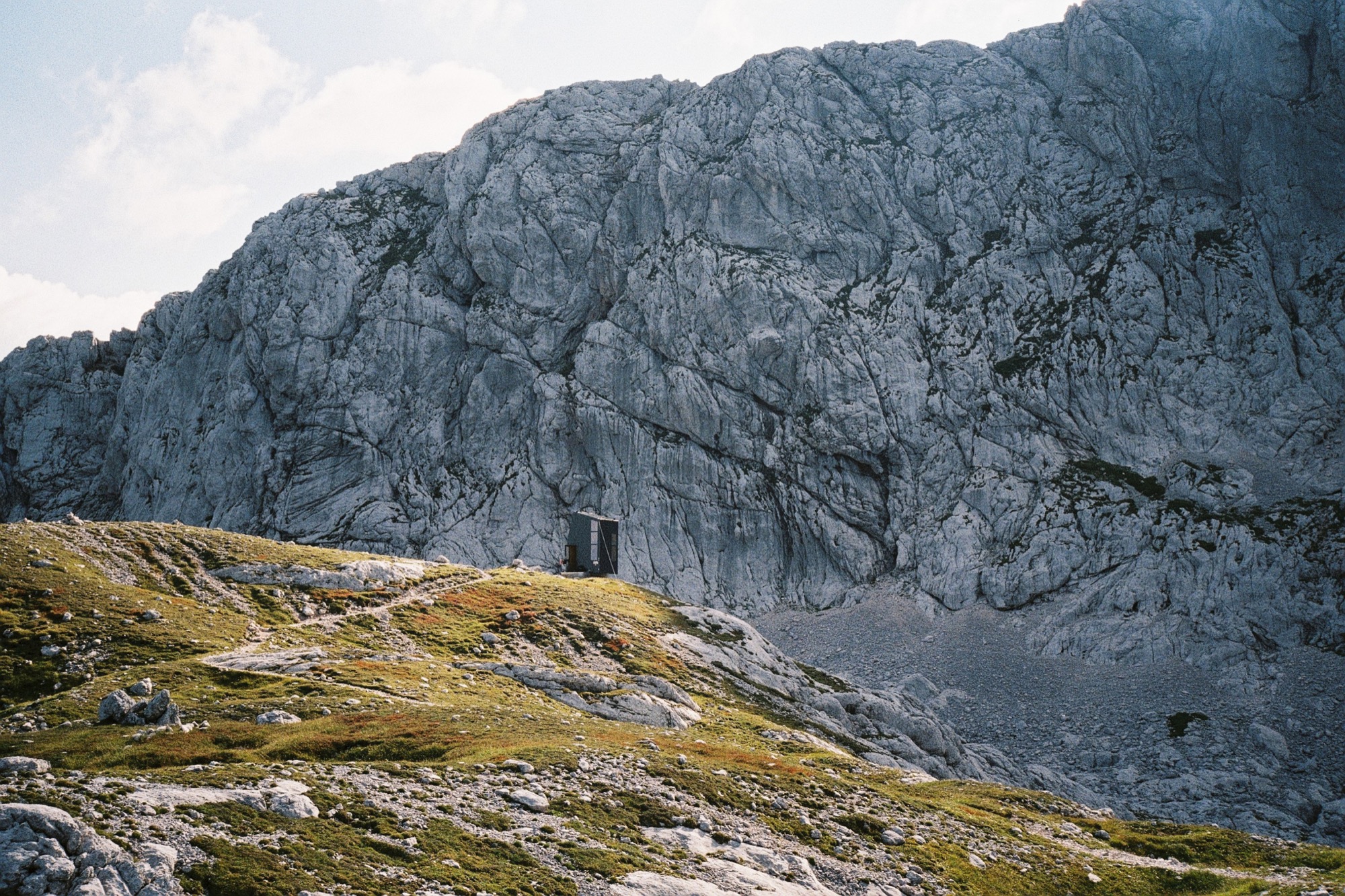
Bivak Pavla Kemperla is dedicated to Pavle Kemperle, a Slovenian alpinist.
Photographer Jaka Bulc (@jakabulc) discovered the bivouac for us with his lens
He writes about his experience:
The first part of the marked trail to this bivouac is usually very crowded, since it leads to a popular mountain hut on the Kokra Saddle and then onwards to Grintovec, one of Slovenia's most frequently visited mountains.
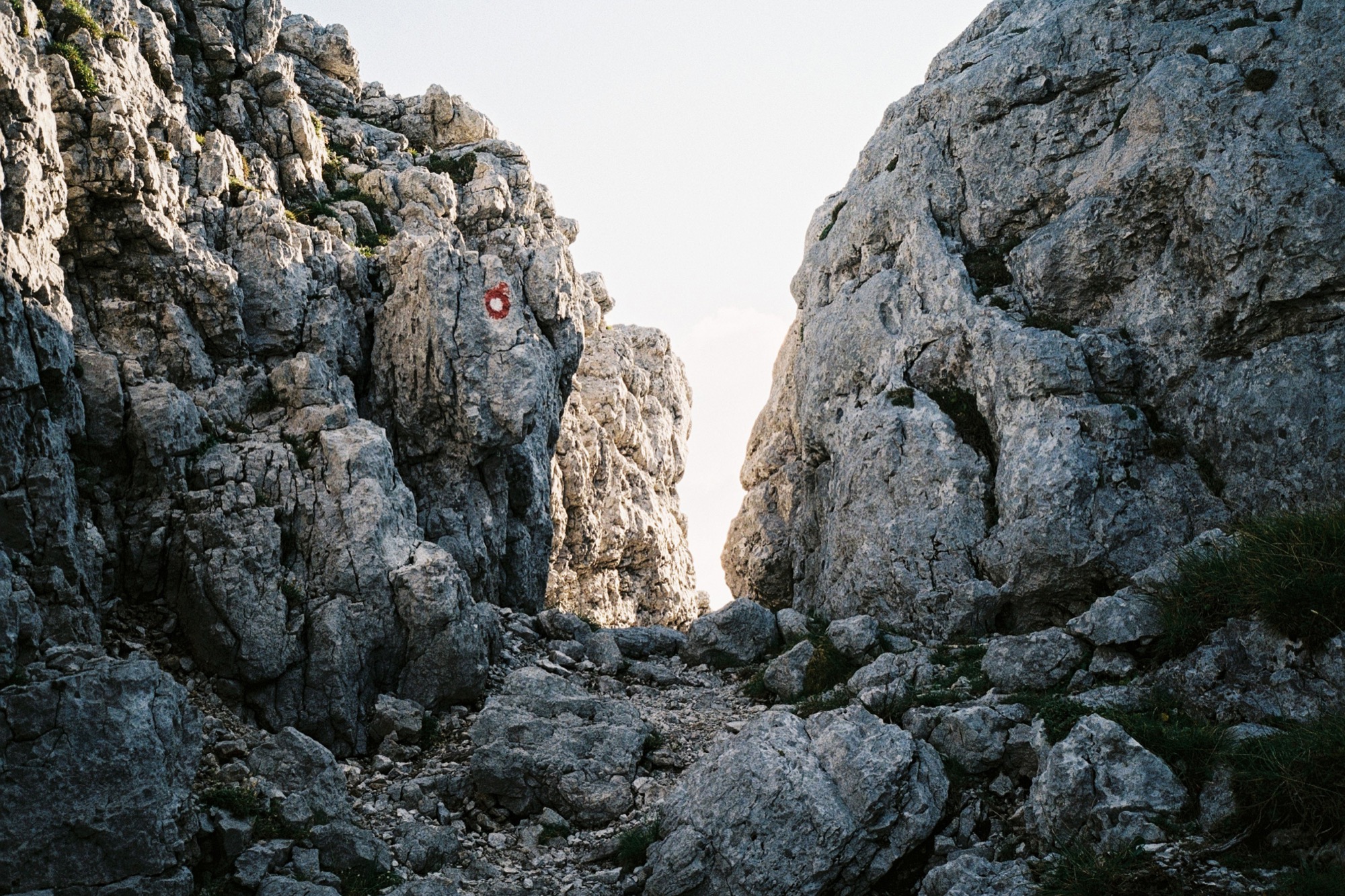
The trail to the bivouac gradually veers off and goes through an interesting passage to a scenic path that winds its way across the steep rocky slopes of Grintovec. We reached the bivouac late in the afternoon and bumped into two other hikers, who were just getting ready to summit a couple of nearby peaks.
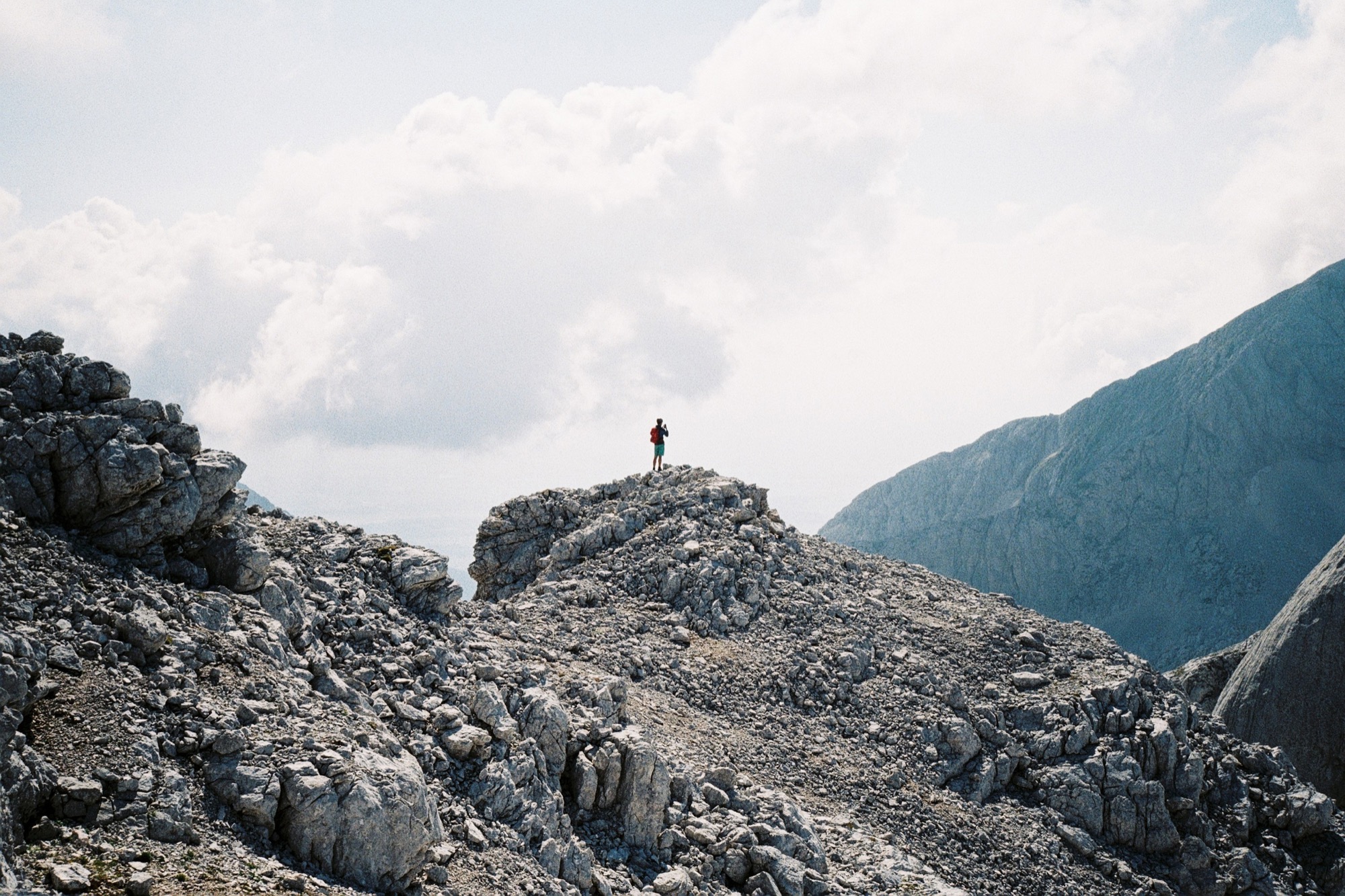
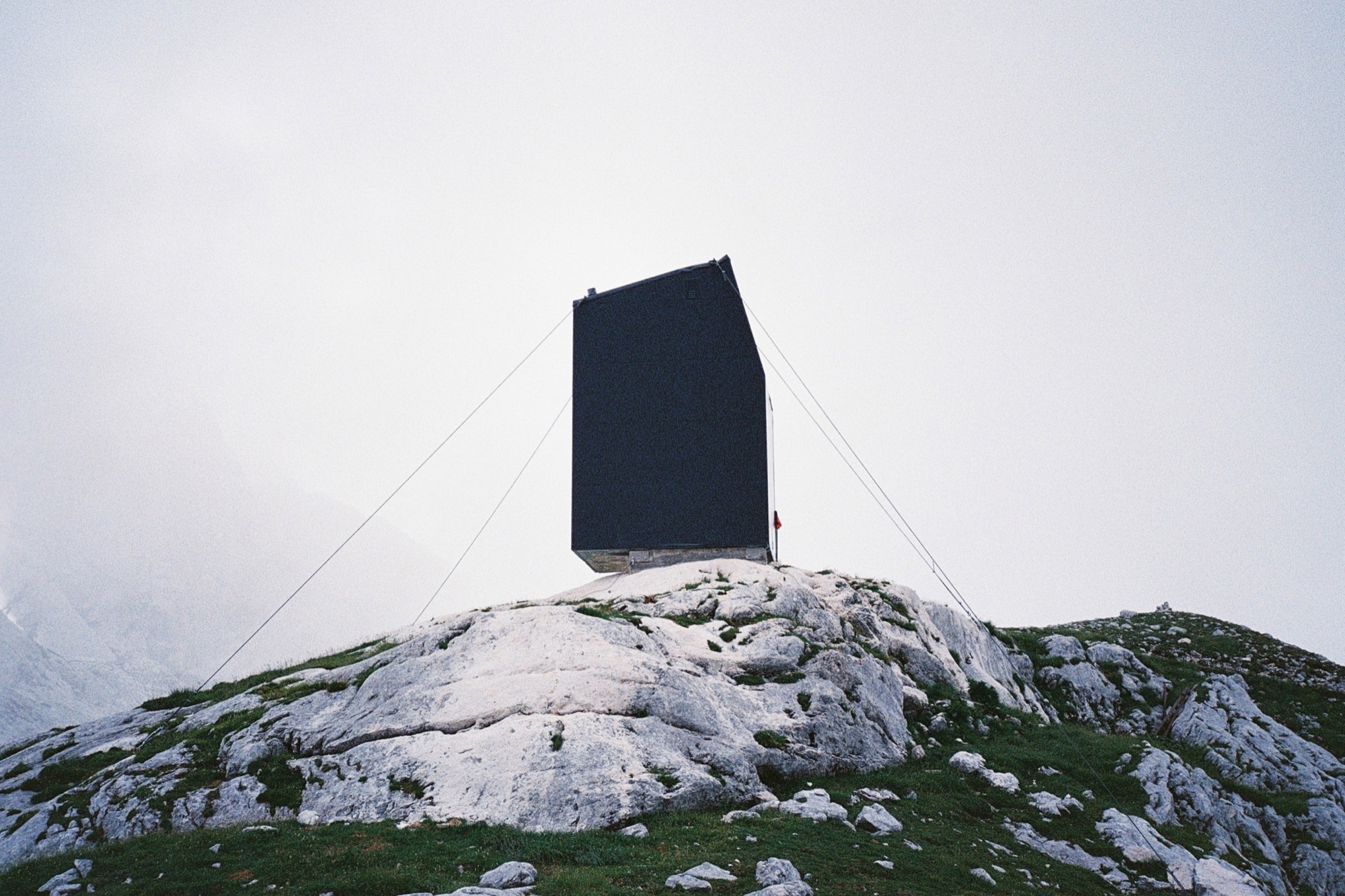
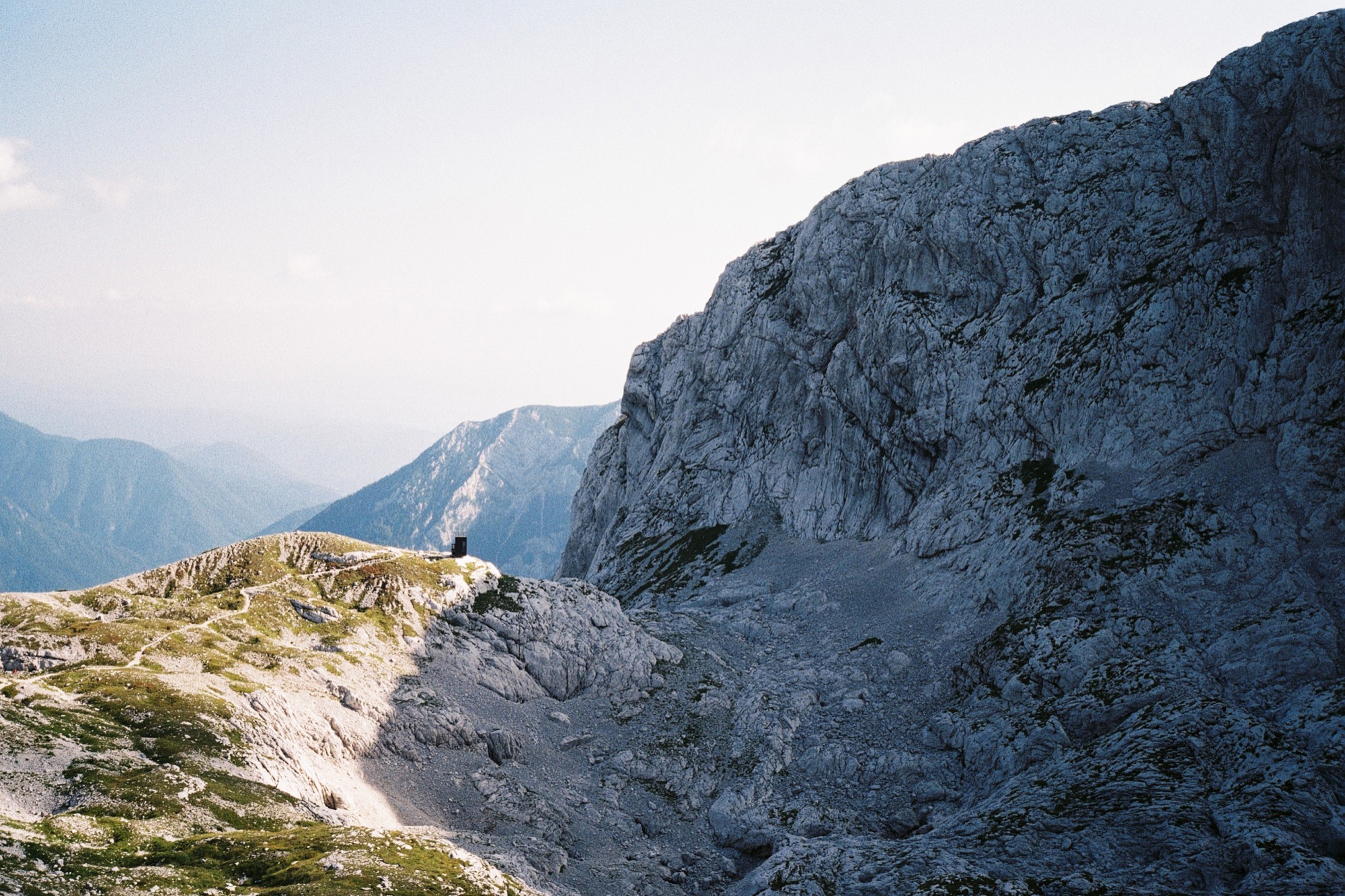
The monolithic building gives the impression of being sheltered by the natural amphitheatre of rock walls, although the bivouac sits on a knoll that gently rises over the surrounding landscape. △
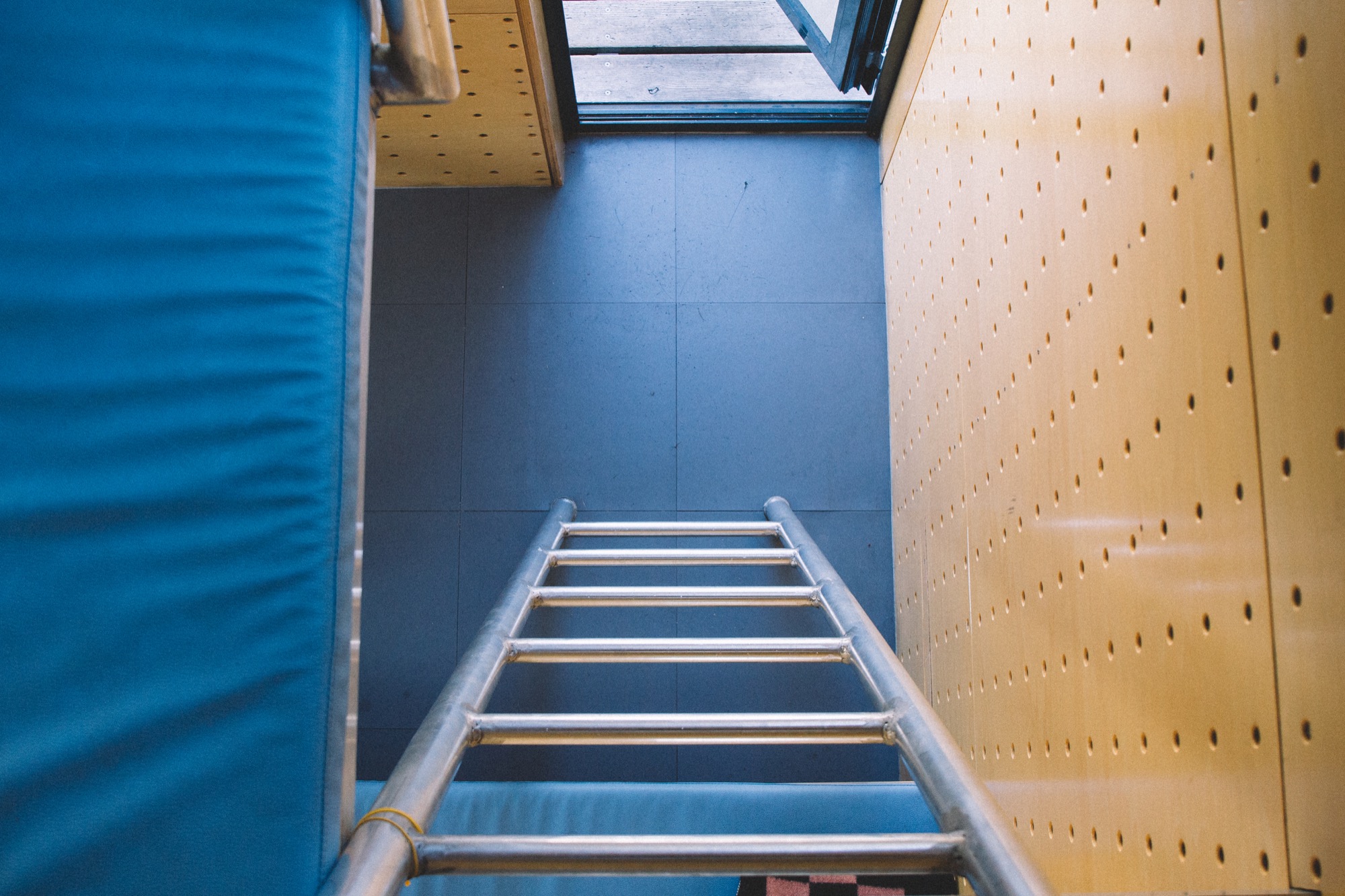
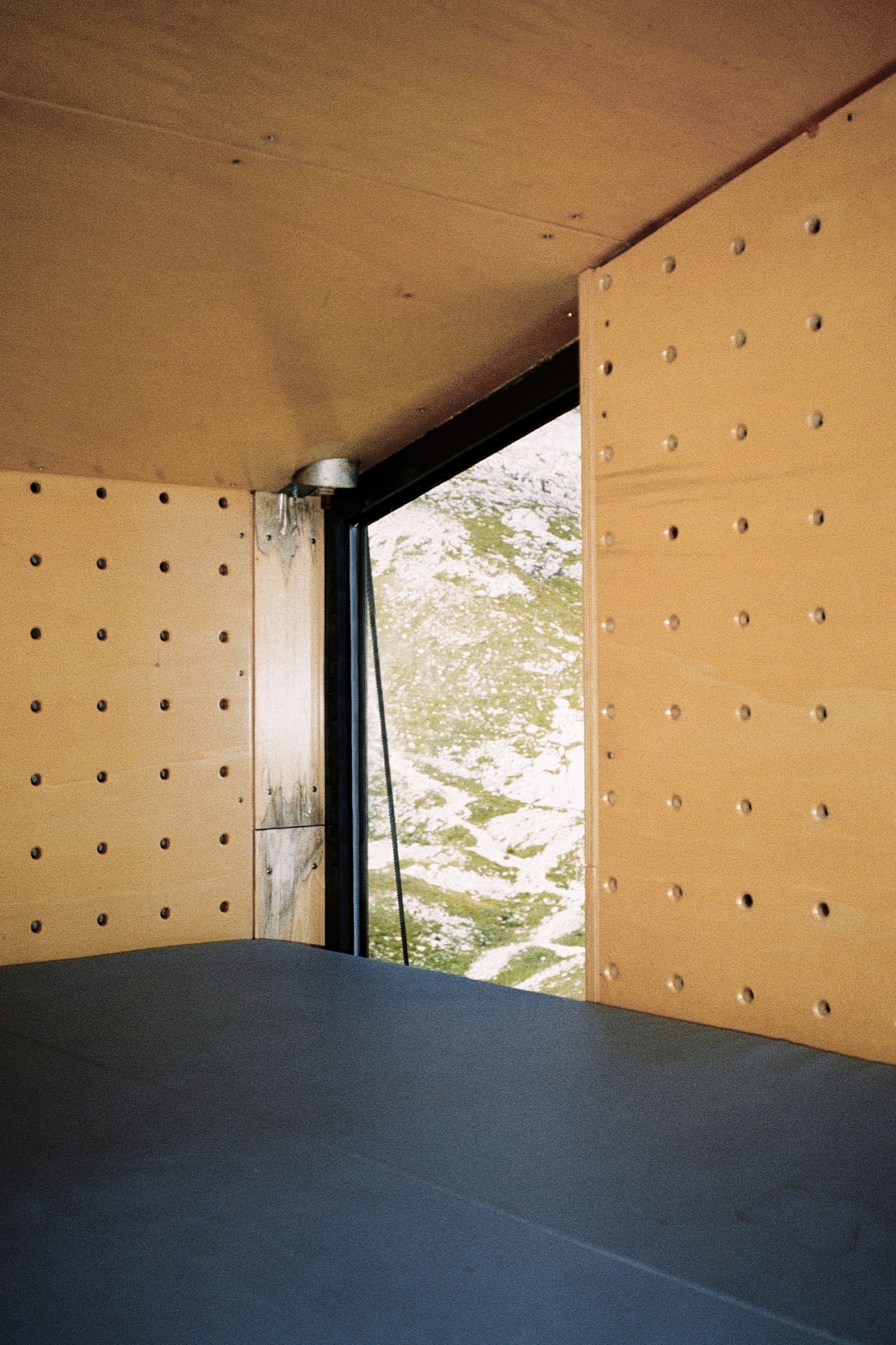
Wild Presence
Outdoor and wildlife photographer Martin Dellicour captures the graceful lure of chamois and ibexes in the Italian Alps
Early last winter, Belgian outdoor and wildlife photographer Martin Dellicour overnighted in an old barn in the Italian Alps to wake up among these wild yet graceful chamois and ibexes.
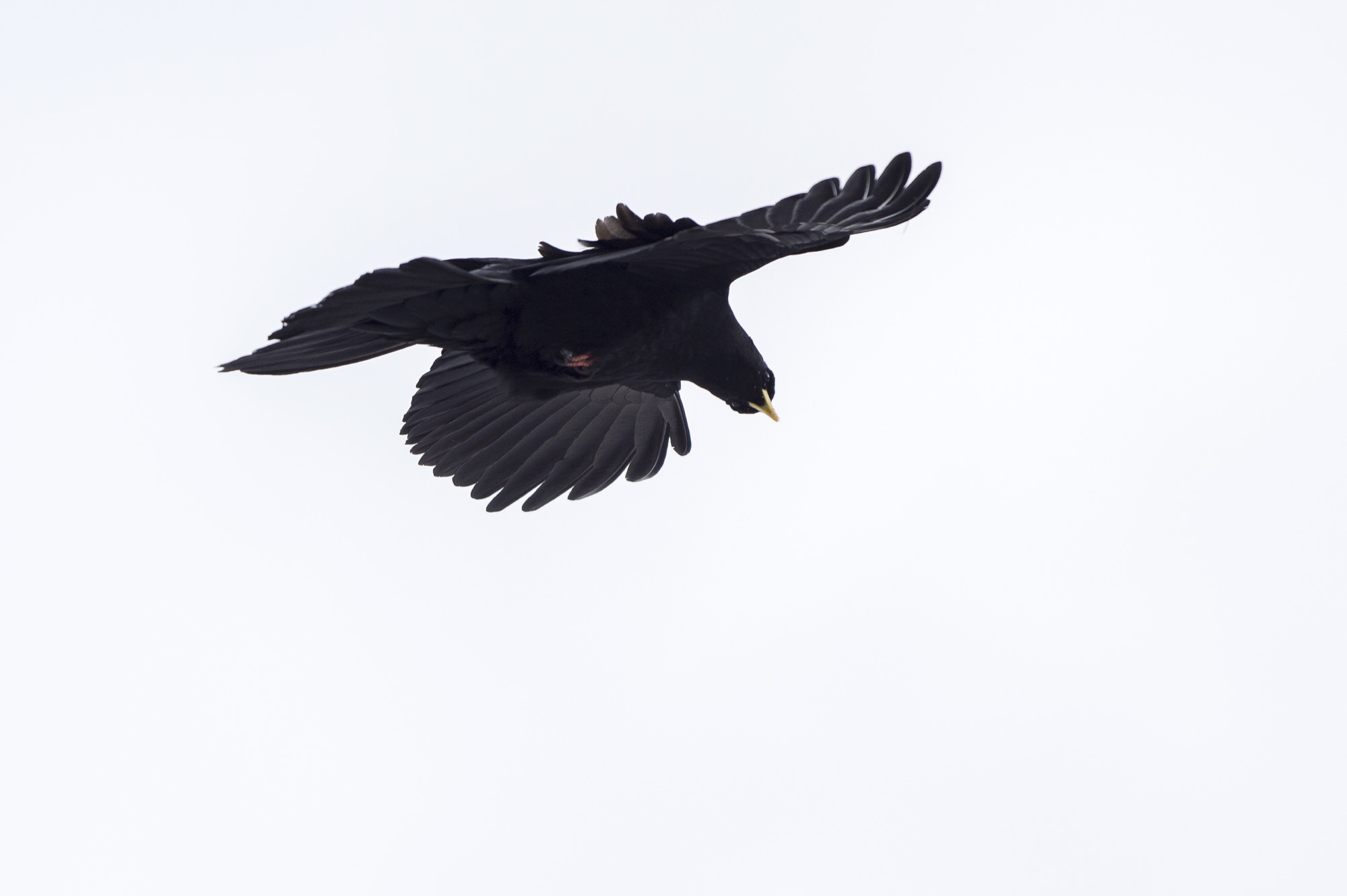
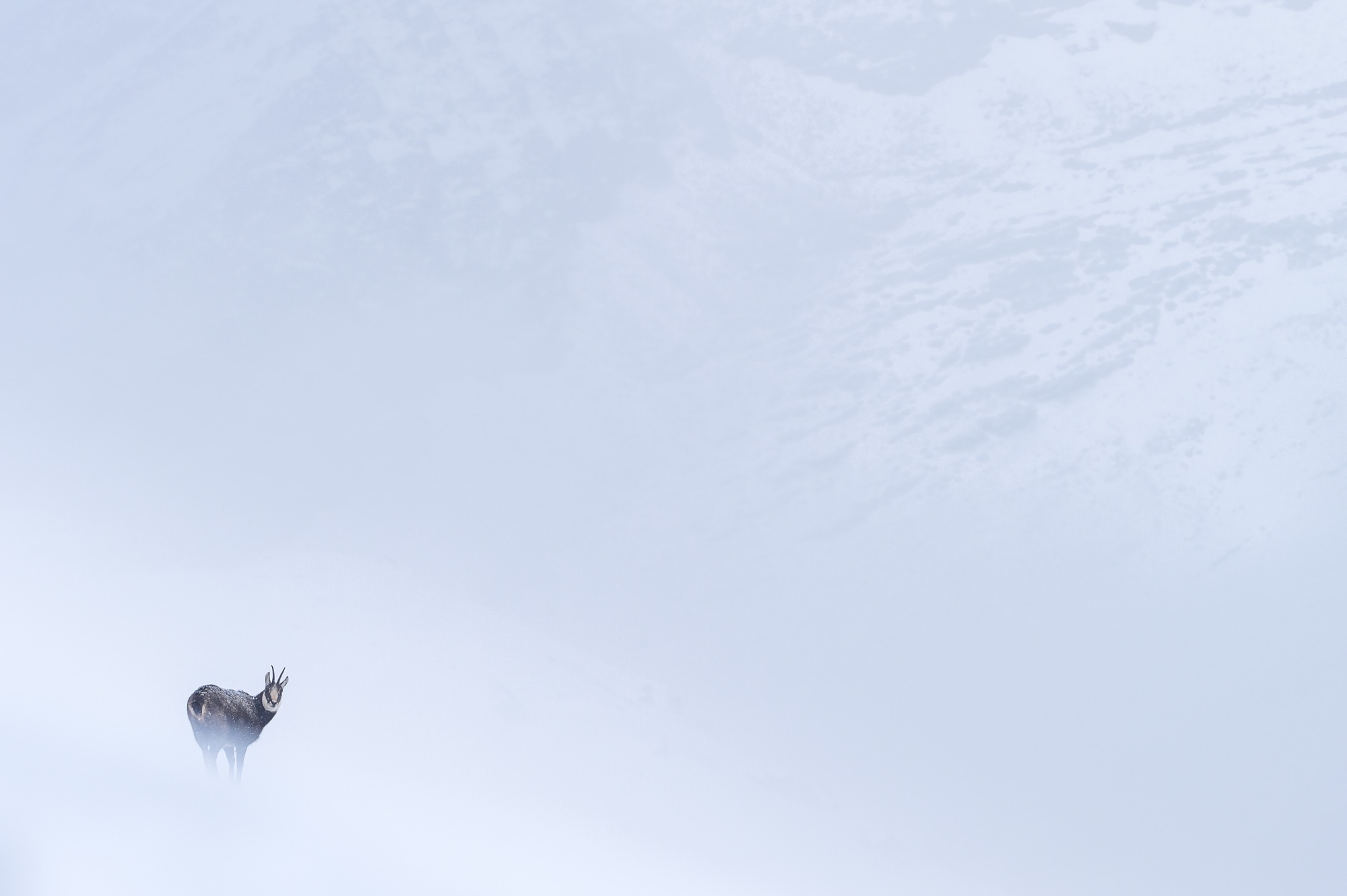

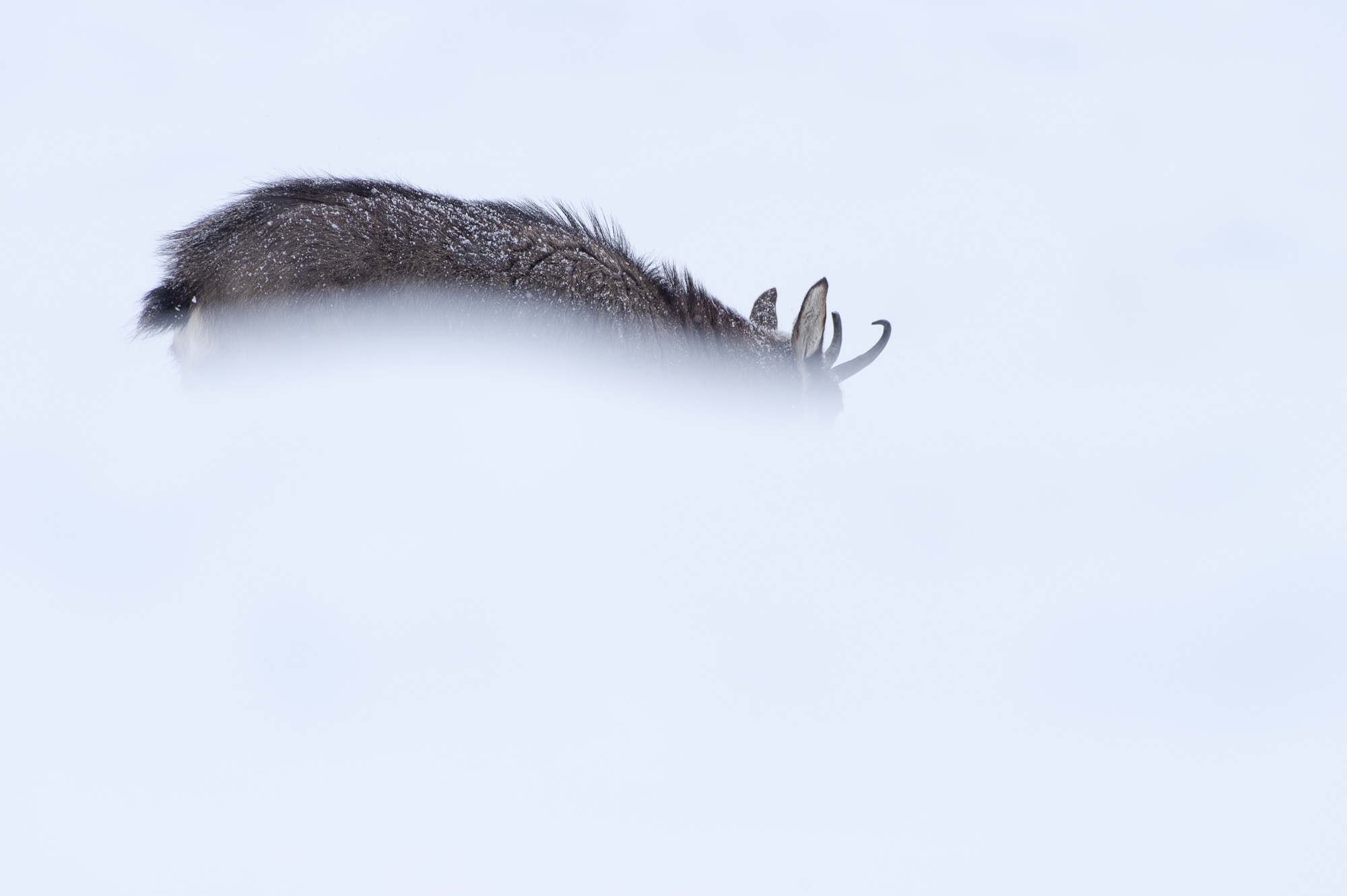
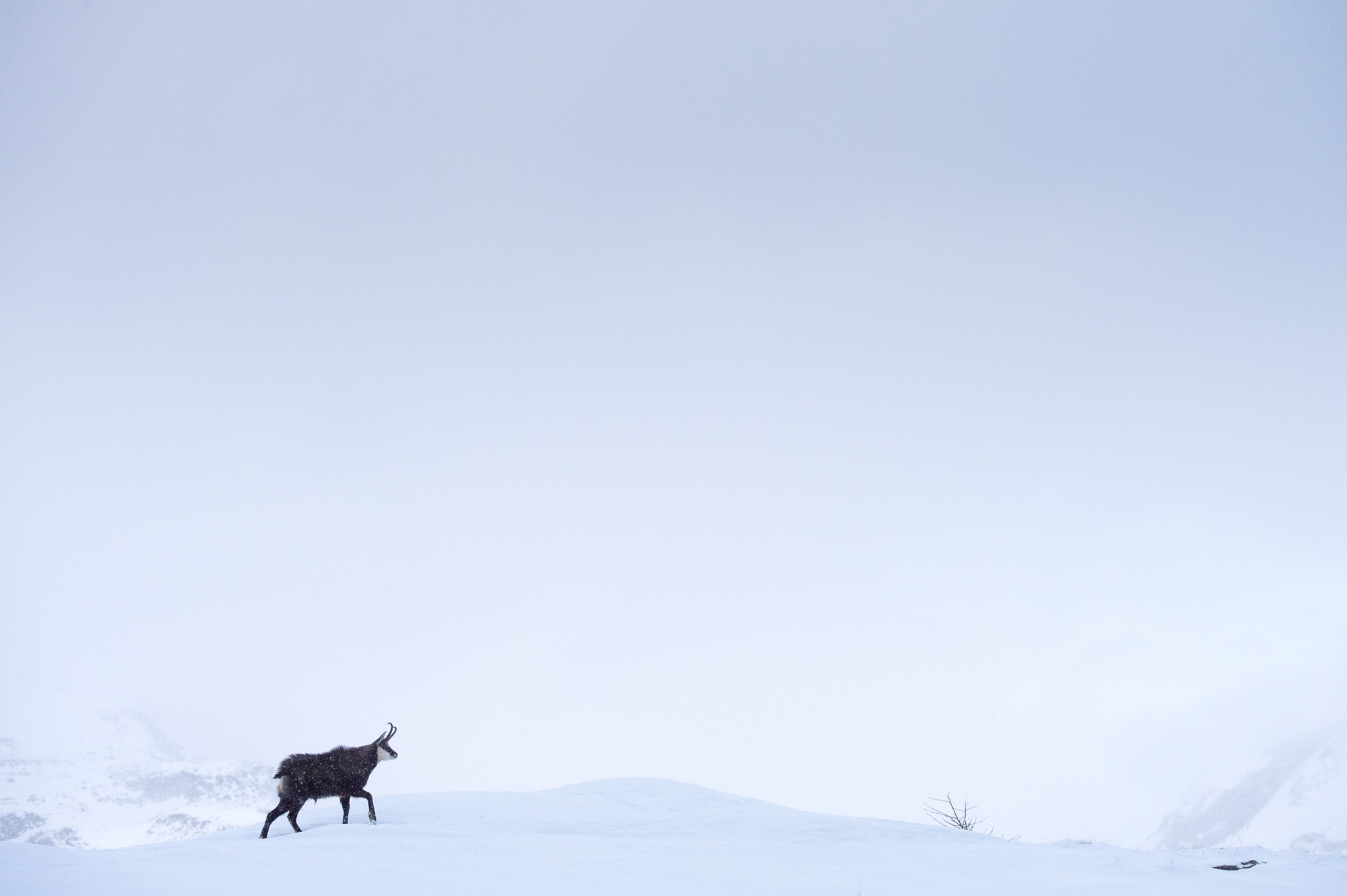
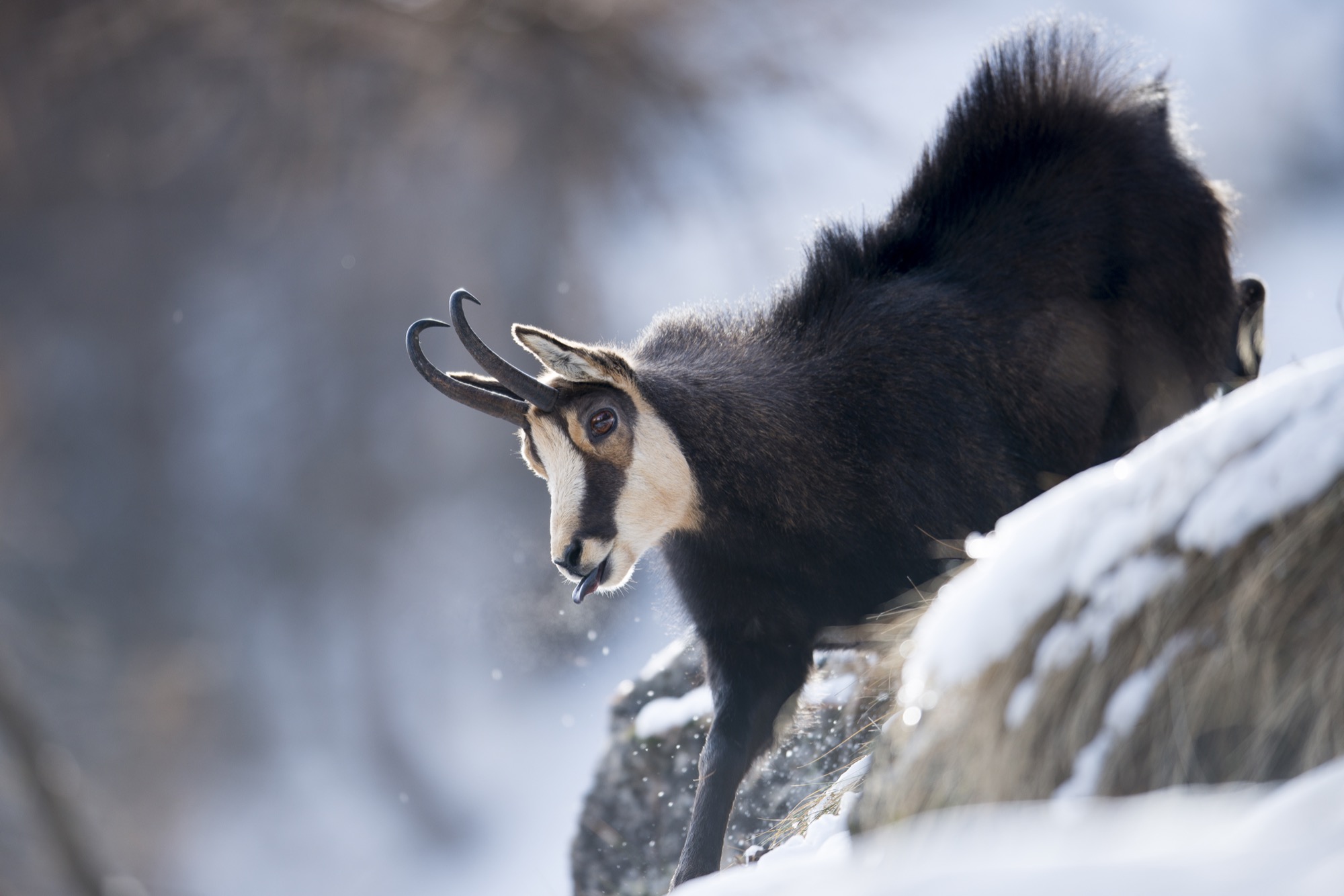
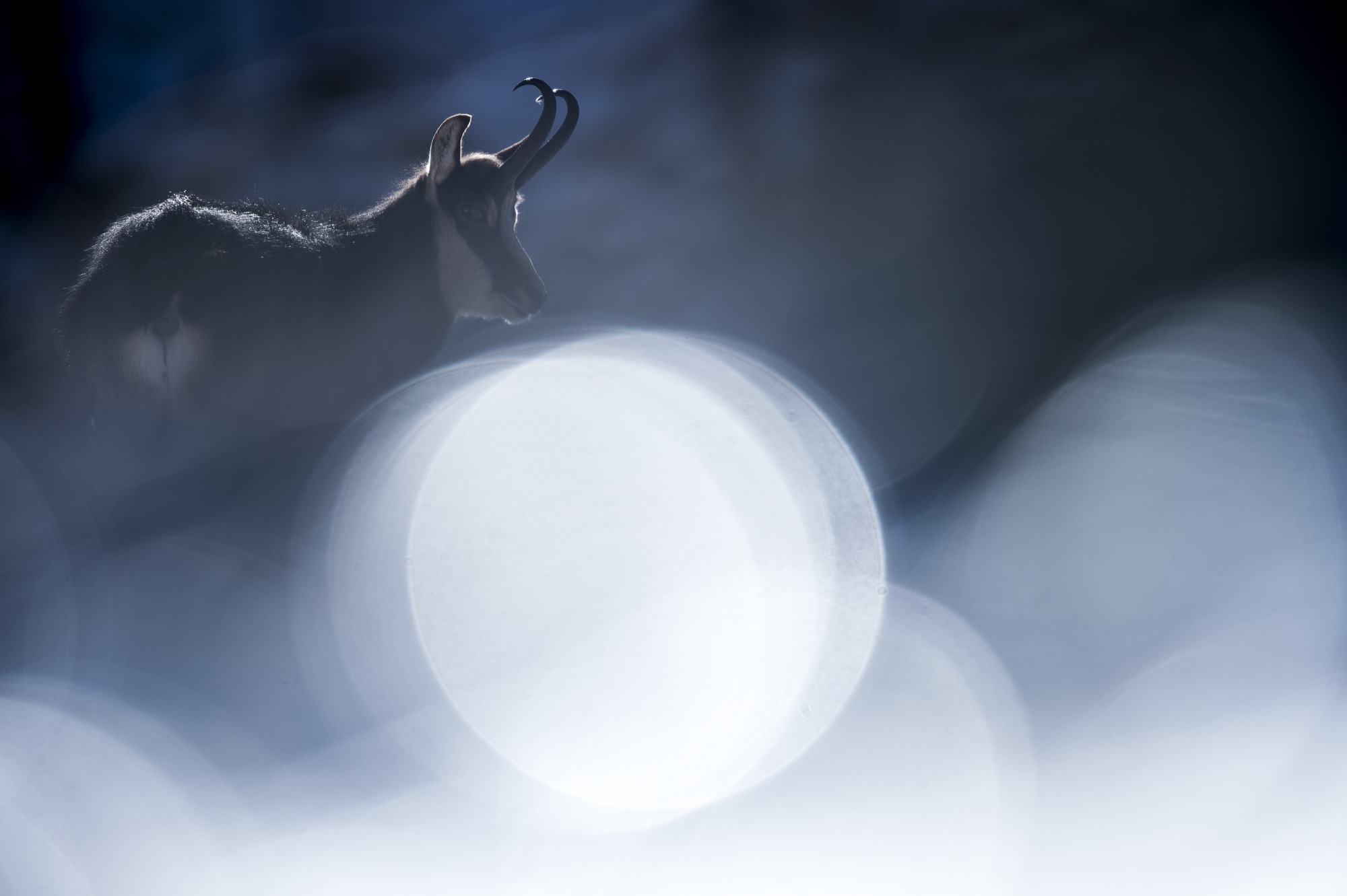
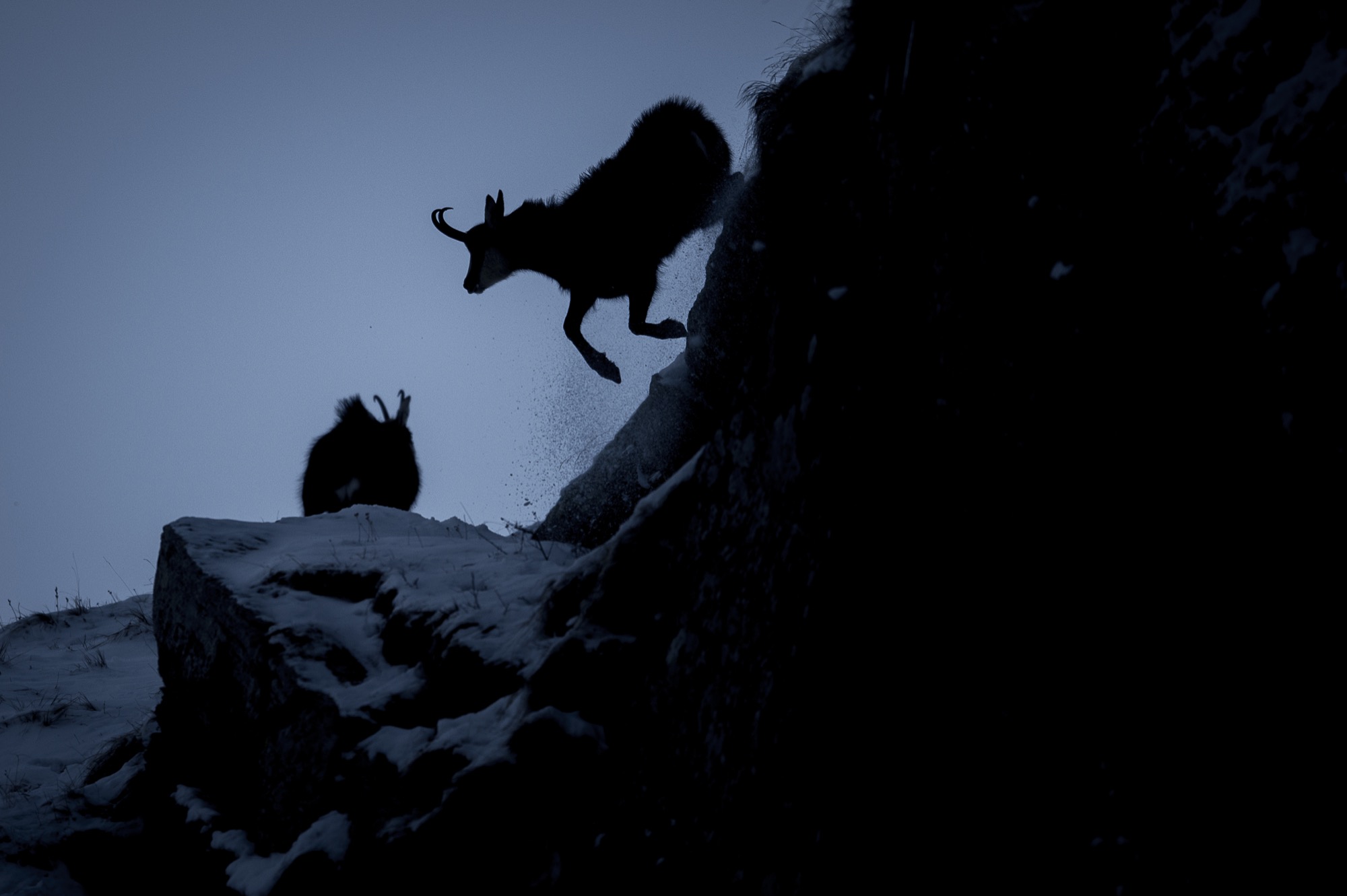
Your Highness: Chalet Zermatt Peak
Celebrities and royalty stay at this über luxurious chalet with majestic Matterhorn views
Zermatt / Canton of Valais / Switzerland A stay at Chalet Zermatt Peak with views of the majestic Matterhorn is pure indulgence, and that begins with the location: Zermatt is one of the most beautiful mountain resorts in Europe.
“Chalet Zermatt Peak was designed to make the most of its stunning surroundings,” says Sarah Hixon- Broad, head of sales and operations at Chalet Zermatt Peak. “Floor-to-ceiling windows offer guests unrivaled views, and the interior had no expense spared to make it the most luxurious chalet in the village.” Rated “five star plus,” the five-bedroom chalet comes with a personal chef, concierge, serving staff, housekeeping, and masseuse. Though Hixon-Broad won’t drop names, she says, “We have had members of several European royal families, celebrities, and sports personalities.”









